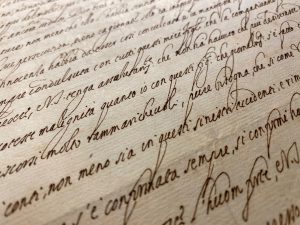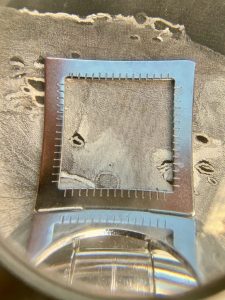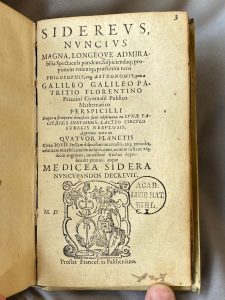Een meesterwerk van Petrus Apianus. Nadat ik dit boek heb leren kennen heb ik het aangevraagd bij de Universiteitsbibliotheek van Leiden. Ongelofelijk wat een meesterwerk. Bijna een half millennium oud en wat een prachtstuk is dit… Daarom een lange pagina met veel foto’s en informatie.
Omdat dit het mooiste boek is dat ik ooit heb gezien, heb ik de facsimile versie aangeschaft. Bijna net zo zeldzaam
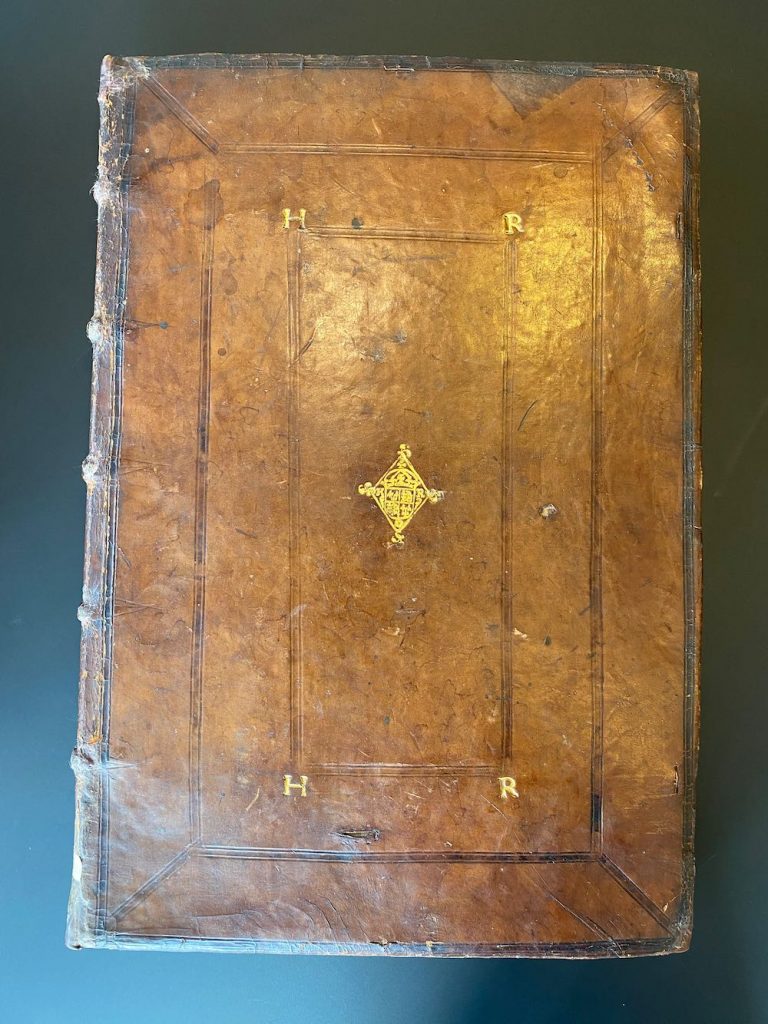
De “Emperor’s Astronomy” uit de privé-pers van Petrus Apianus is een van de grote meesterwerken van de zestiende-eeuwse boekdrukkunst. In dit grote foliovolume vond het papieren instrument zijn grootste realisatie in een reeks ingewikkelde volvelles, allemaal met de hand ingekleurd in de drukkerij in Ingolstadt van de astronoom.
Voordat Apianus het Astronomicum Caesareum schreef en vervaardigde, was hij een pionier in het uitgeven van boeken vol ingenieuze beweegbare apparaten, de zogenaamde volvelles: op deze pagina van Wikipedia wordt zelfs een exemplaar in het boek van munne grote vriend Sacrobosco genoemd. Een half dozijn van zijn werken werd geproduceerd op zijn eigen pers in de universiteitsstad Ingolstadt, waar hij hoogleraar astronomie was. De productie van het magnum opus moet de astronoom verscheidene jaren hebben gekost, want tussen 1534 en 1540 publiceerde hij weinig andere boeken. Het grote volume groeide en veranderde in de loop van het drukken, en omvatte uiteindelijk vijfenvijftig bladen, waarvan er eenentwintig bewegende delen bevatten en twaalf andere indexdraden.
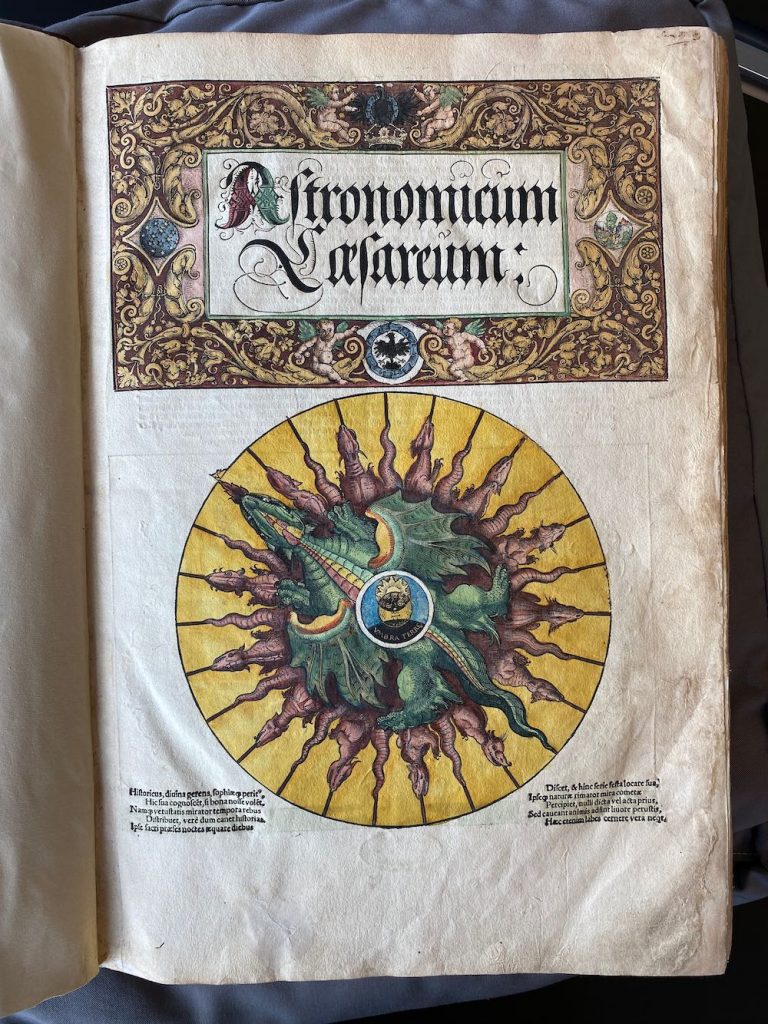
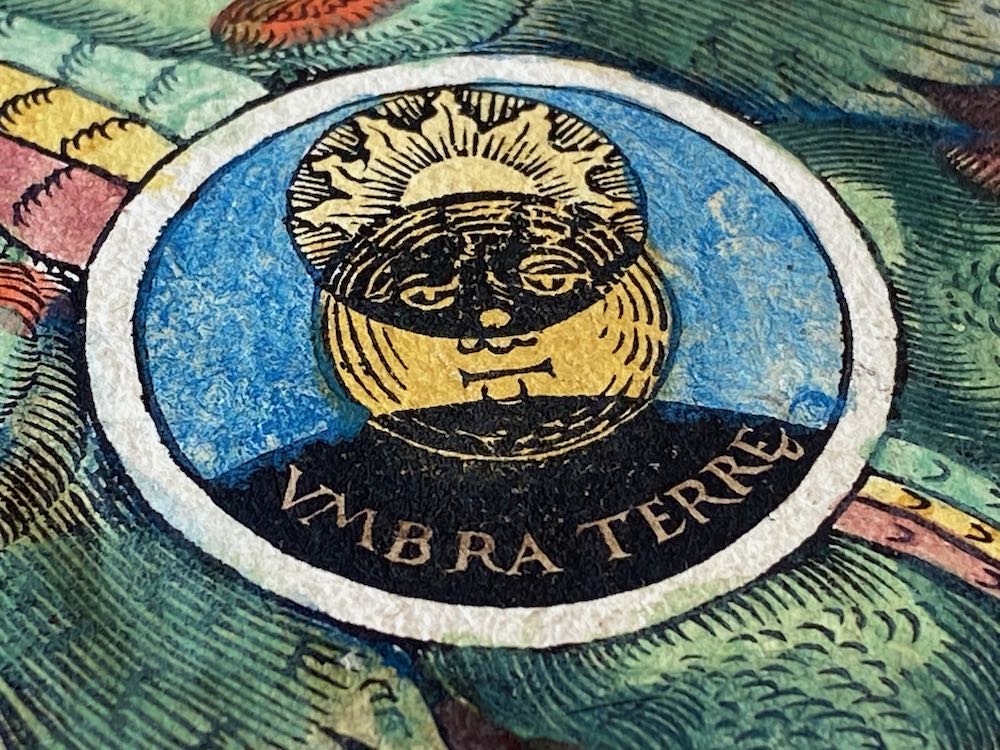
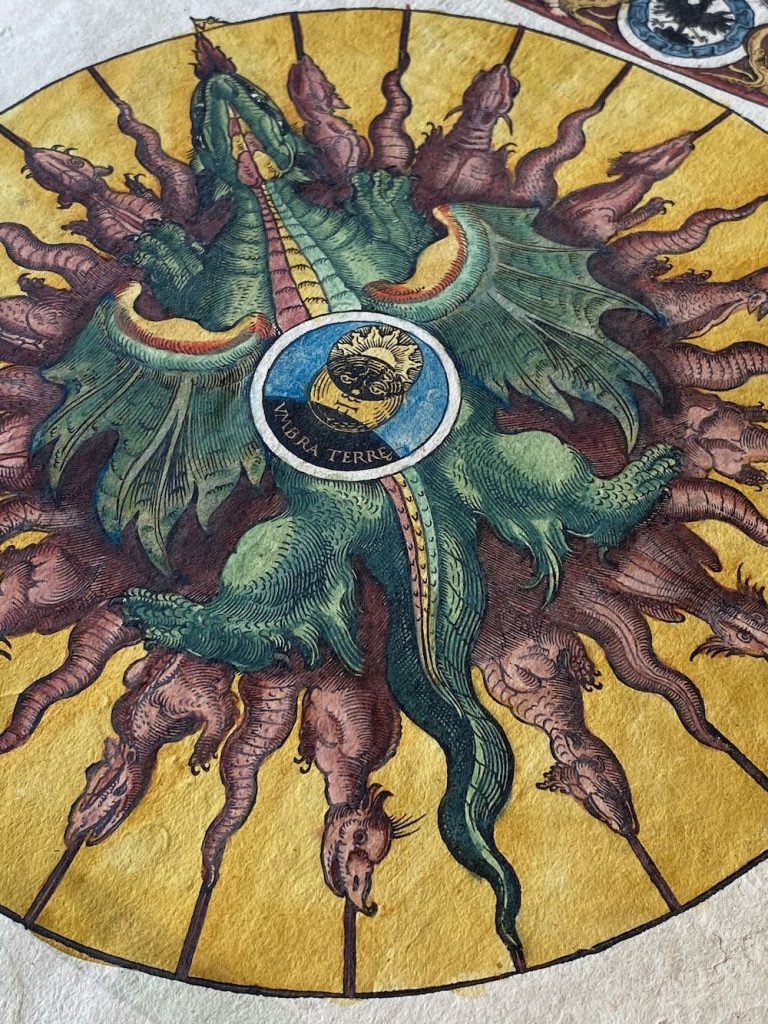
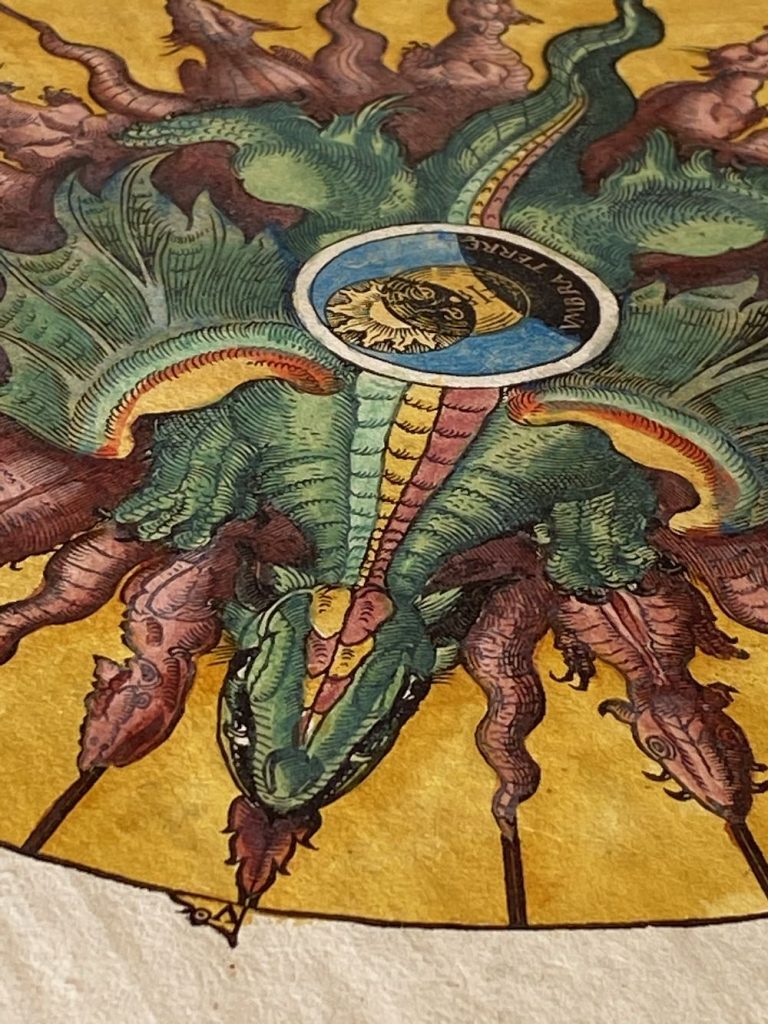
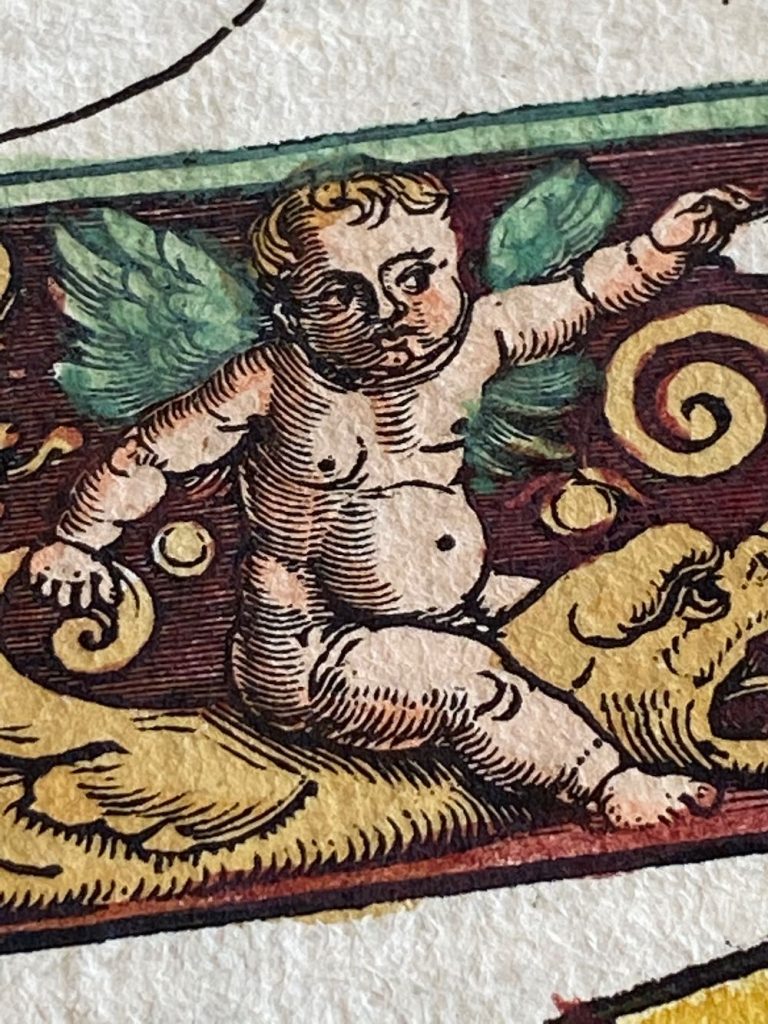
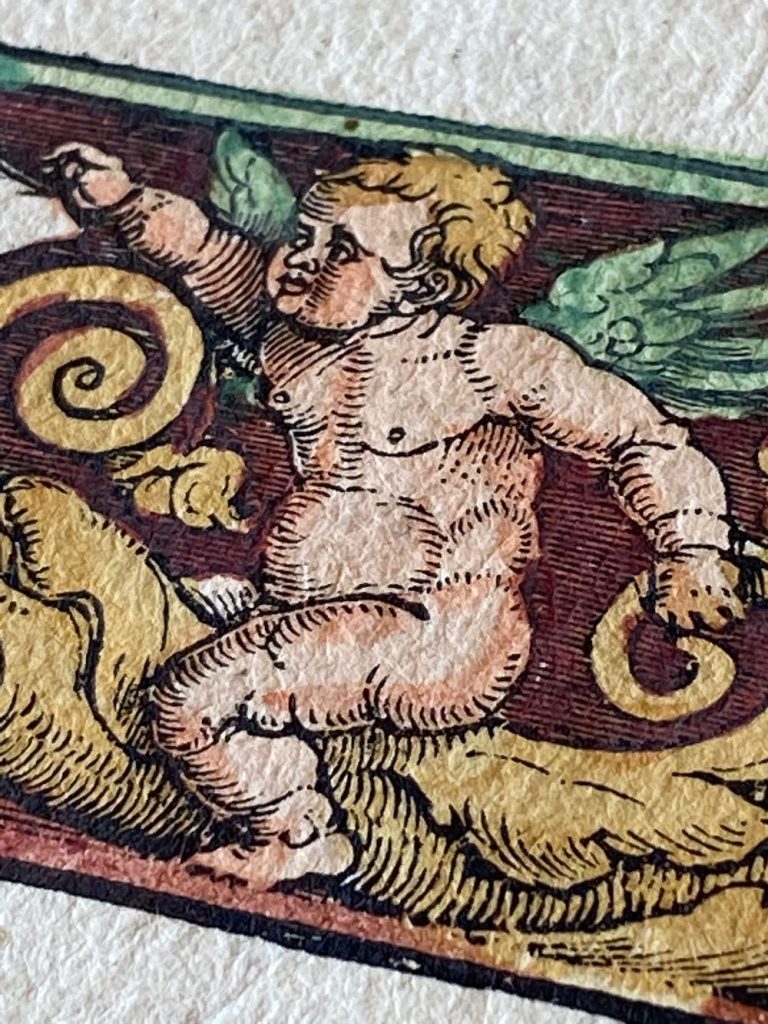
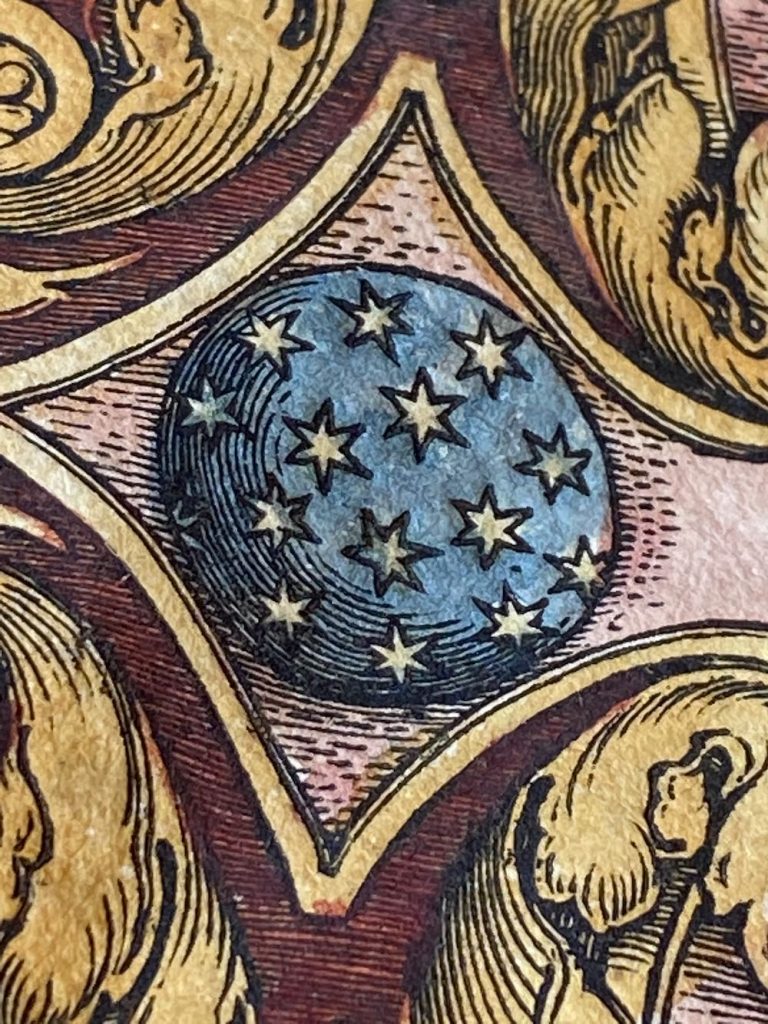
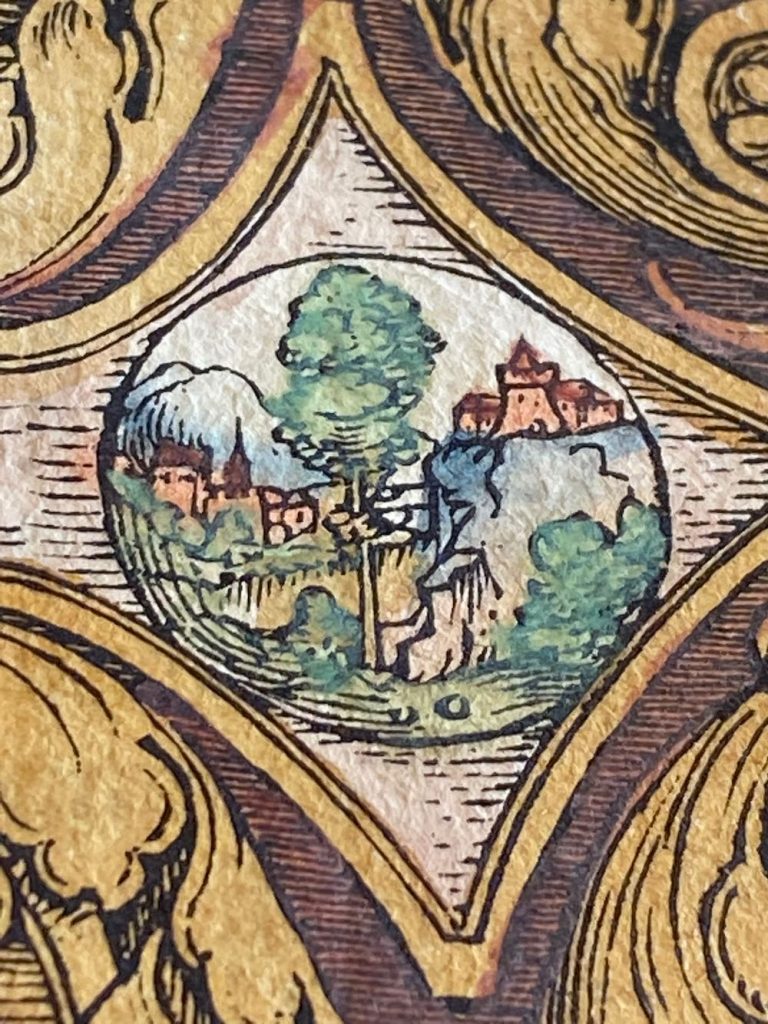
De uitleg hoort bij deze pagina: Goed om daar ook te kijken als je de uitleg precies wil volgen.
Onder de verscheidenheid aan pagina’s met bewegende delen komt in de eerste plaats een reeks planetaire equatoria, papierwielen om de plaatsen van de planeten binnen de dierenriem te vinden. Folio’s [B3] tot en met FIII bevatten deze apparaten. Door alle details van het geocentrische Ptolemeïsche systeem te belichamen, bieden de volvelles en threaded charts een opmerkelijk nauwkeurige grafische berekening van de positie van een planeet. De meest indrukwekkende pagina is folio [E4], het mechanisme voor de lengtegraad van Mercurius, dat negen gedrukte delen bevat plus een complexe verborgen infrastructuur om beweging rond vier afzonderlijke assen mogelijk te maken. Op spectaculaire wijze rivaliserend met deze pagina is de opening GIIIv- [G4] met een dubbele cluster van maanwolvellen tegenover elkaar.
Apianus was oorspronkelijk niet van plan om de twee sets maanwolken tegenover elkaar te plaatsen; op de achterkant van de Rosenwald-kopie staan annuleerbladen voor folio’s GII en GIII volgens een eerdere opvatting voor dit deel van het boek. Er moeten ook andere herzieningen in het ontwerp zijn geweest. De bewegende delen op folio [G5] verbergen bijvoorbeeld een volledig irrelevante basis van een astrolabium, het fossiel van een plan dat ongetwijfeld werd verlaten toen Apianus zich realiseerde hoe moeilijk het zou zijn om alle lakachtige papierstructuur weg te snijden die nodig is voor zijn beweegbare ster. grafiek.
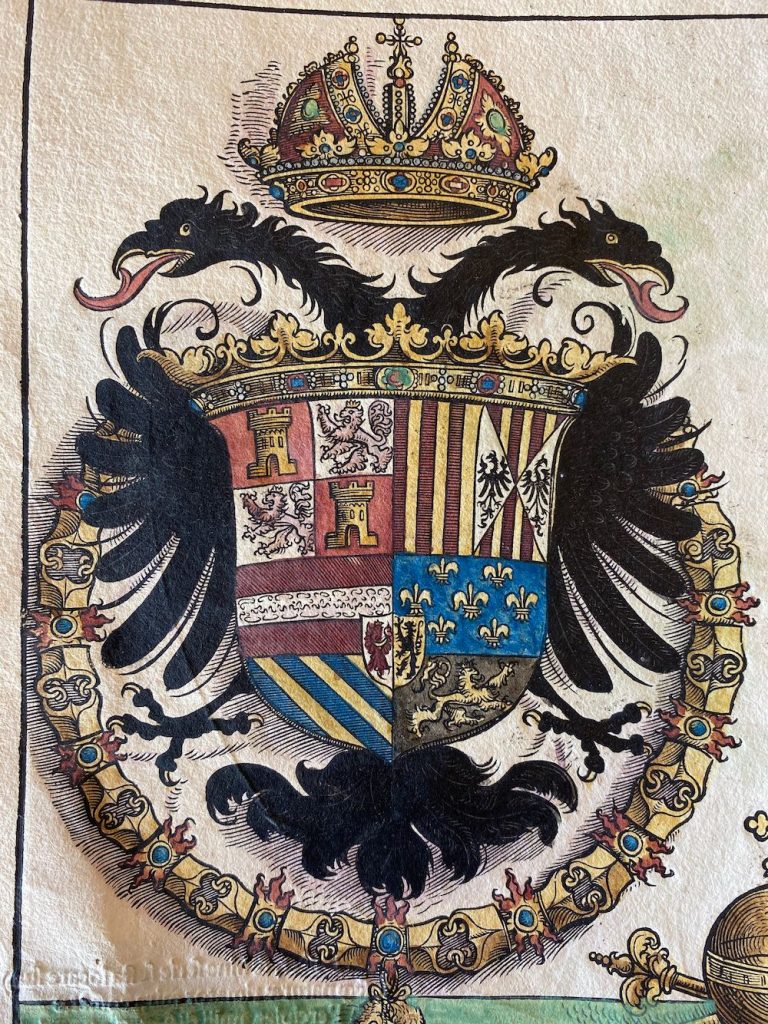
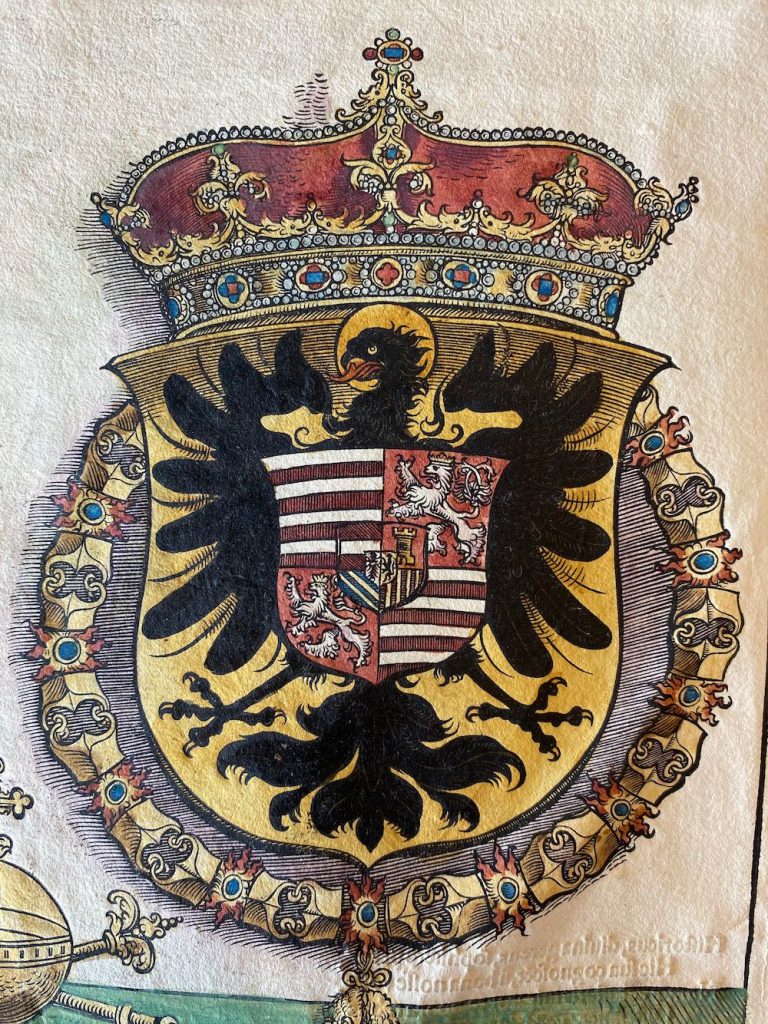
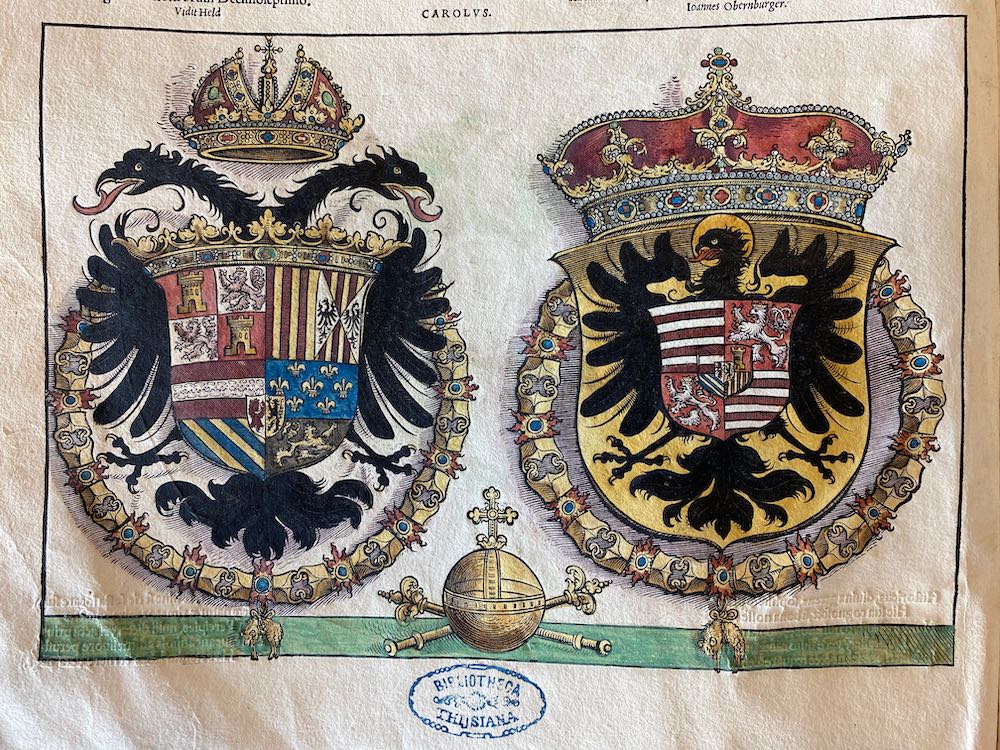
Gedurende het eerste deel van zijn boek geeft Apianus gedetailleerde instructies voor de werking van de volvelles, waarbij hij als voorbeelden de geboortedata van de heilige Romeinse keizer Karel V en zijn broer Ferdinand I, de toegewijden, gebruikt. In de hoofdstukken die onmiddellijk volgen, laat Apianus zien hoe verduisteringen kunnen worden berekend, en in het bijzonder de gedeeltelijke maansverduistering van 15 november 1500 binnen het geboortejaar van Karel V, dat voorafgaat aan de geboorte van Ferdinand I op 15 oktober 1503, en de totale maansverduistering van 6 oktober 1530, binnen Het kroningsjaar van Karel V. Vervolgens keert Apianus terug naar twee oude verduisteringen, een gerapporteerd door Plutarchus in het jaar waarin Darius werd verslagen door Alexander de Grote en de andere gerapporteerd door Plinius in de tweede eeuw voor Christus. omstandigheden van verschillende historische verduisteringen. Dit deel wordt afgesloten met een aantal beweegbare apparaten voor een assortiment chronologische en astrologische onderzoeken. Een van de meest merkwaardige is een paar volvelles voor het vinden van het uur van conceptie vanaf het moment van geboorte en de fase van de maan.
Het tweede deel van het Astronomicum Caesareum behandelt voornamelijk observatieproblemen en hun grafische oplossingen. Hoewel er geen bewegende delen in het ontwerp zijn meegenomen, is dit gedeelte niet zonder belang, omdat het voor het eerst laat zien dat komeetstaarten van de zon af wijzen. Onder de vijf kometen die Apianus in de jaren 1530 observeerde en hier wordt beschreven, is degene die nu bekend staat als Halley’s Comet.
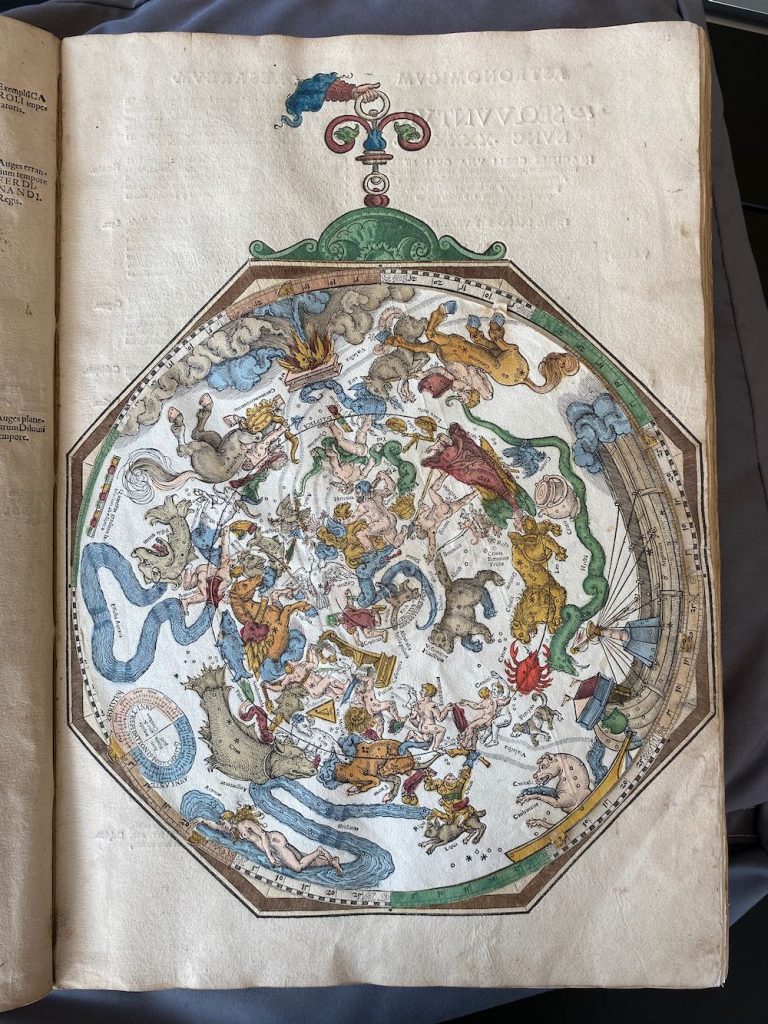
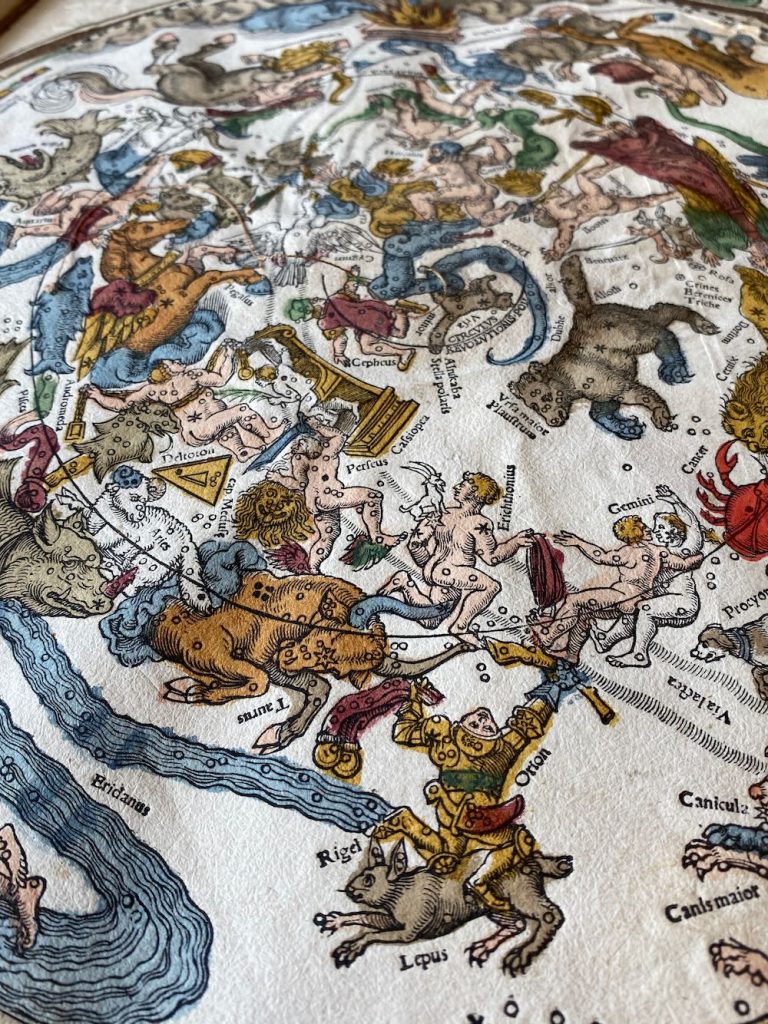
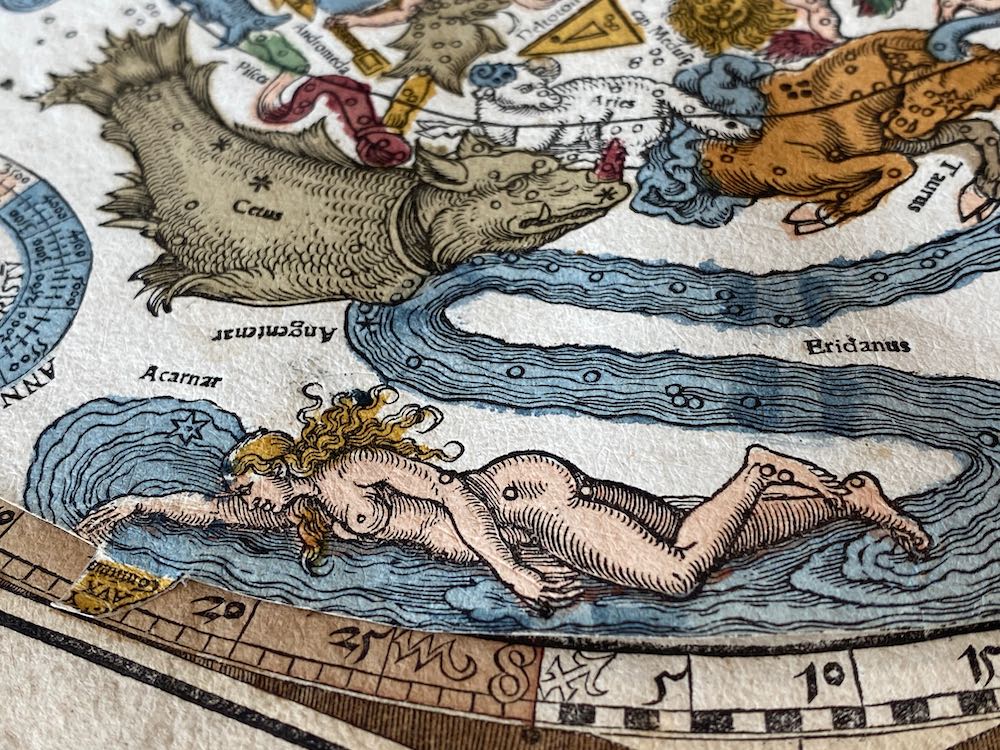
De laatste pagina van de kopie van Rosenwald bevat het originele wapen van Apianus. Als resultaat van dit prachtige boek schonk keizer Karel V de professor een nieuw wapen (Apianus drukte een vervangende pagina af, die in sommige exemplaren te vinden is). De keizer schonk de astronoom ook enkele meer ongebruikelijke beloningen voor dit typografische hoogstandje: het recht om dichters als laureaat te benoemen en zich uit te spreken als wettige buitenechtelijke kinderen.
De twintigste eeuw heeft zijn eigen karakteristieke eer gegeven aan Apianus ‘inspanning: in 1985 een exemplaar van het Astronomicum Caesareum werd geveild voor 80.000 dollar. Ongeveer 120 exemplaren zijn bewaard gebleven, waarschijnlijk het merendeel van de gedrukte exemplaren, aangezien het onwaarschijnlijk is dat iemand zo’n fascinerend boek zou weggooien. Zelfs in de zestiende eeuw was het een luxe boek. Tycho Brahe vermeldt dat hij twintig florin voor één betaalde, wat ongeveer gelijk zou zijn aan 3.000 dollar. Een paar boeken gedrukt na 1540 slaagden erin om nog complexere samenstellingen van papieren schijven te bevatten, maar geen enkele bereikte de totale elegantie en pracht van dit boek. Een triomf van de drukkerskunst, het Astronomicum Caesareum blijft echt een astronomie die geschikt is voor een keizer.
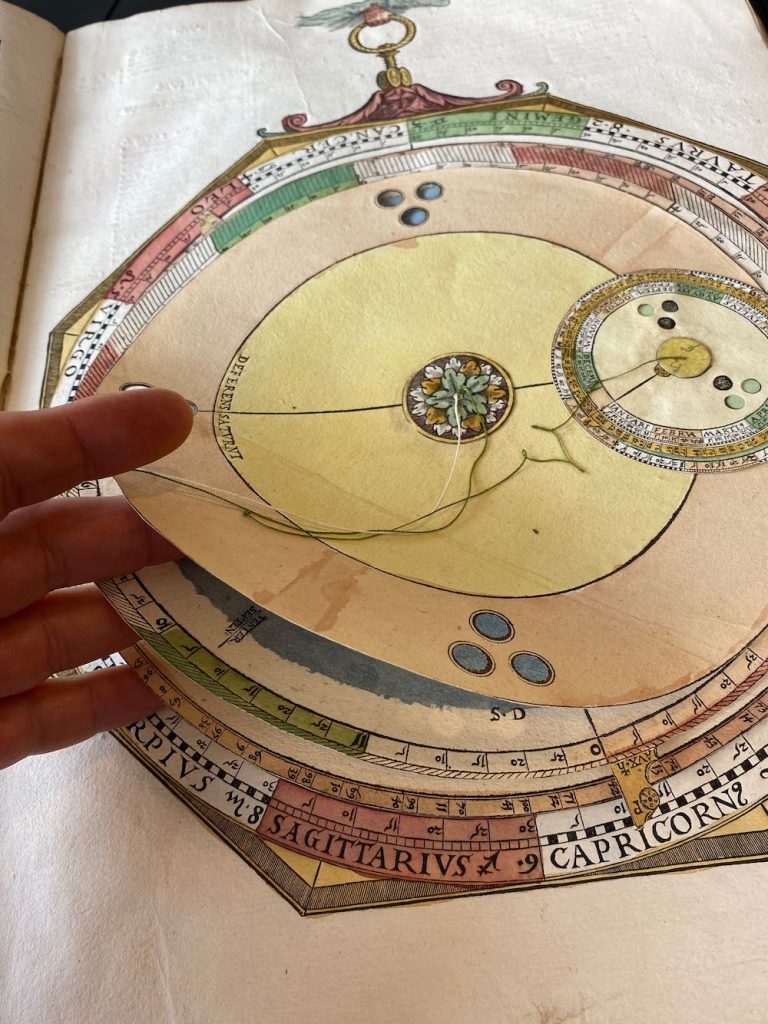
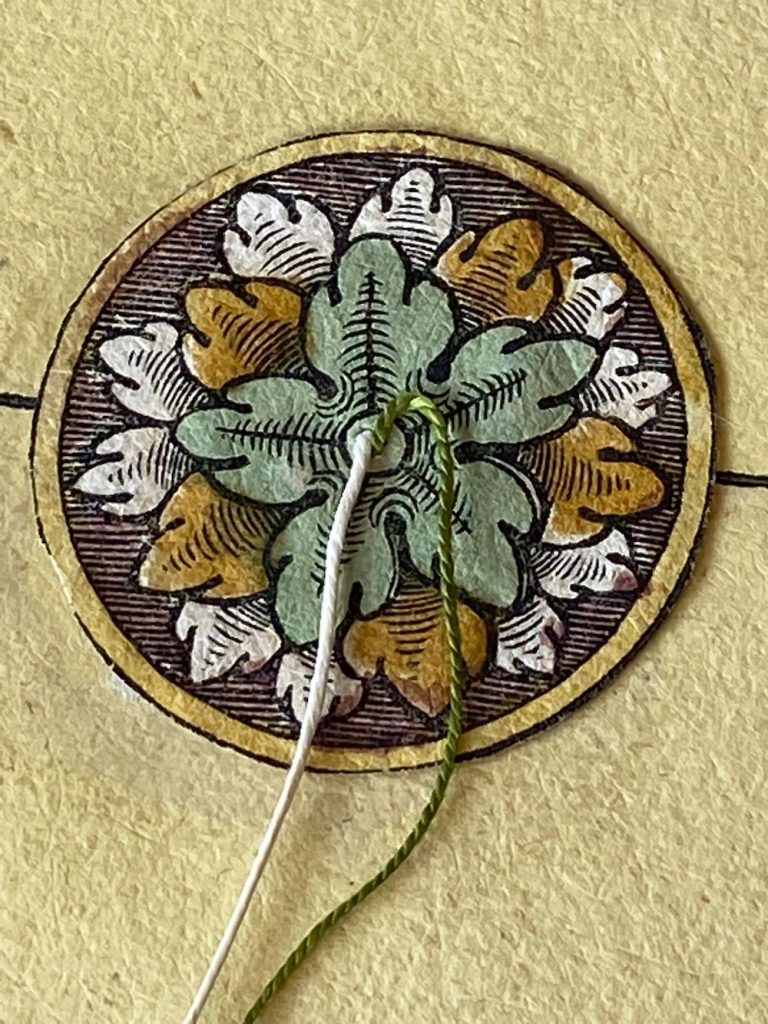
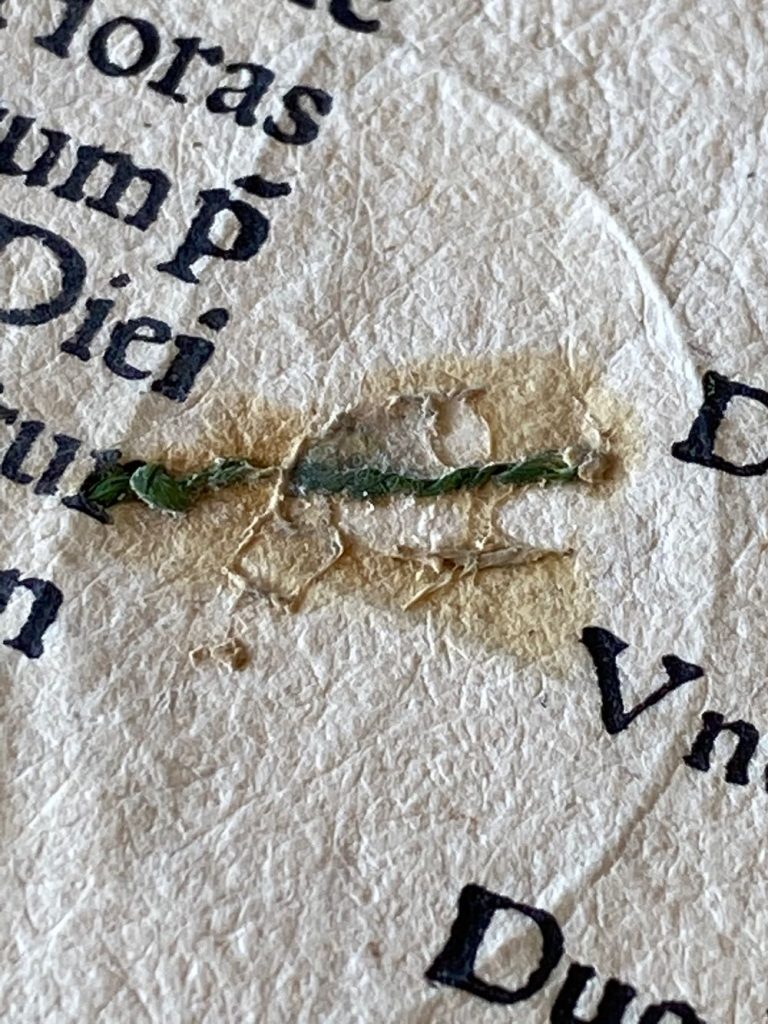
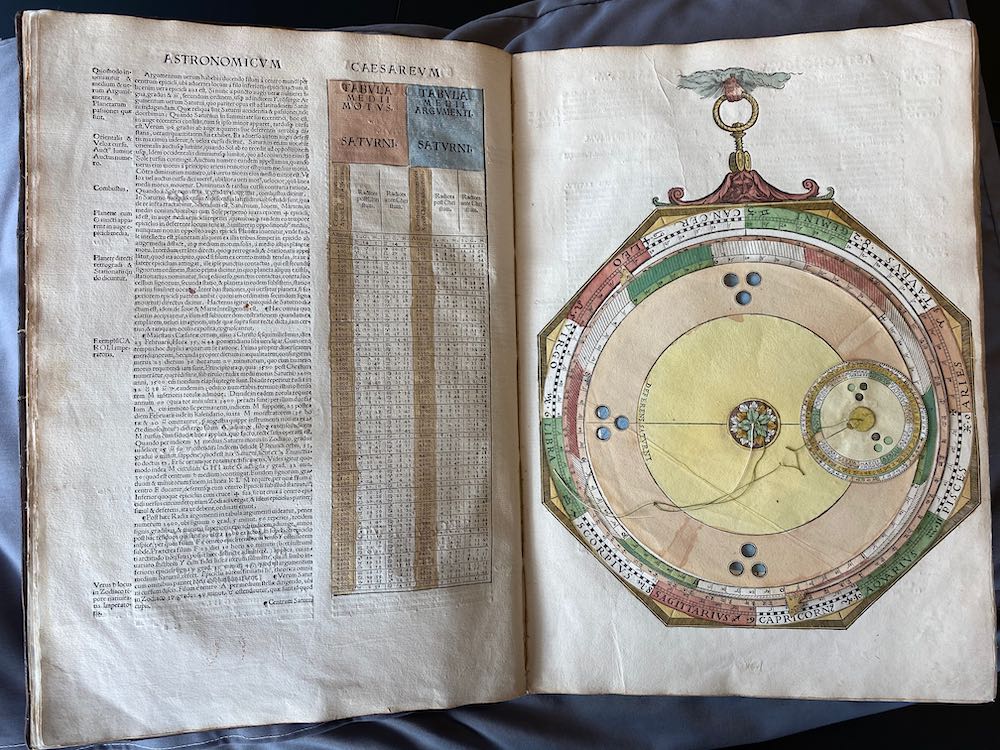
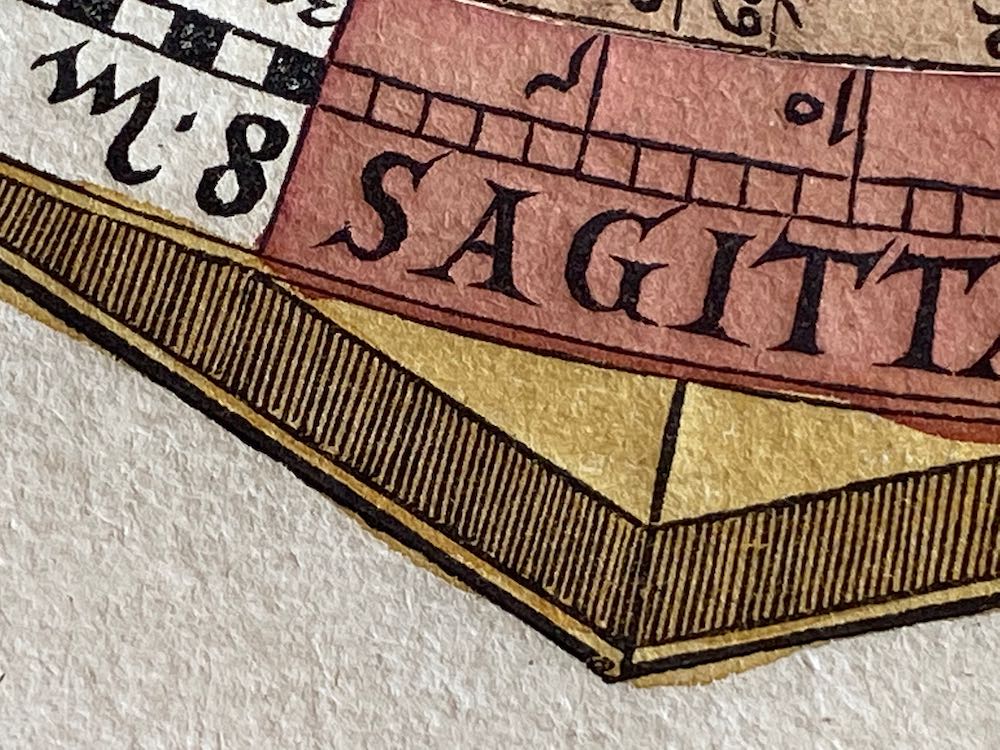
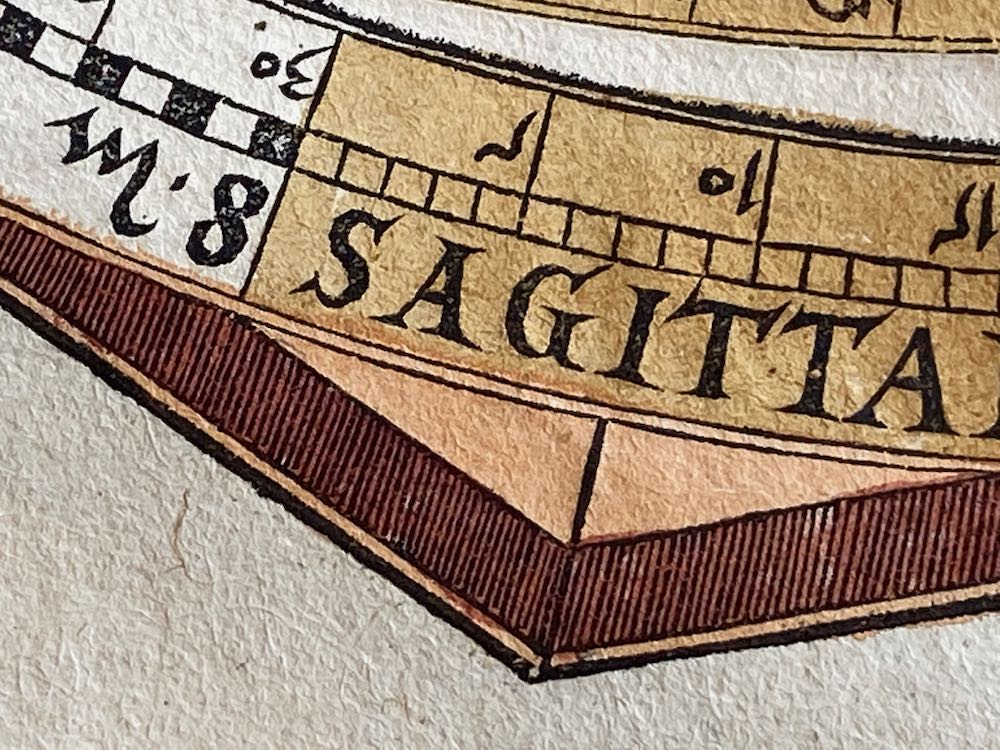
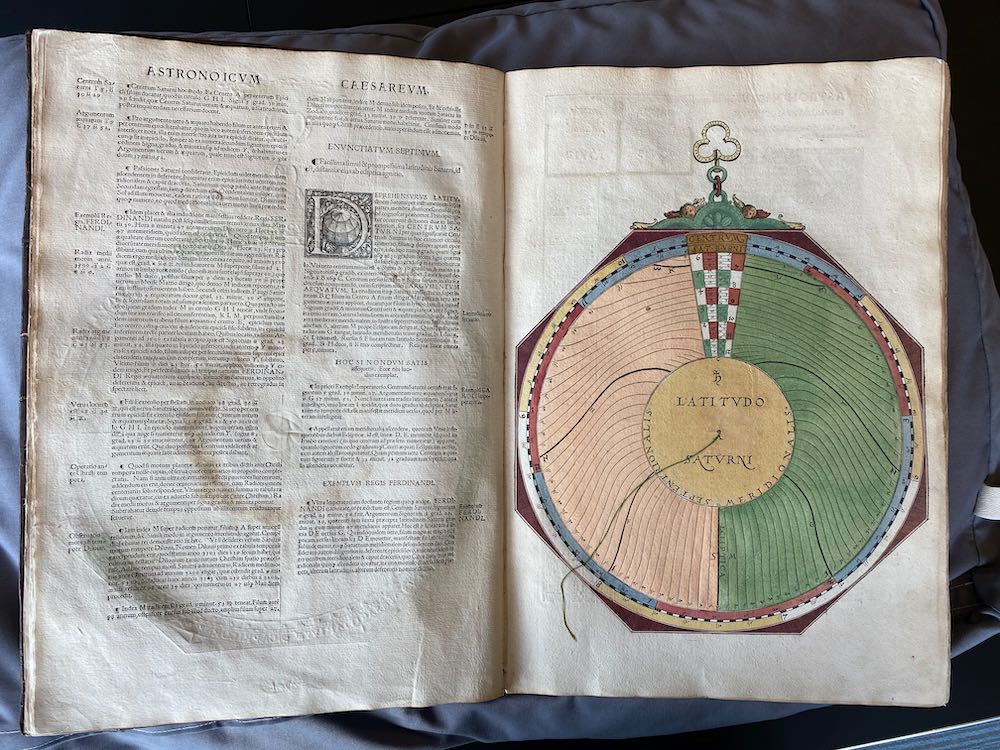
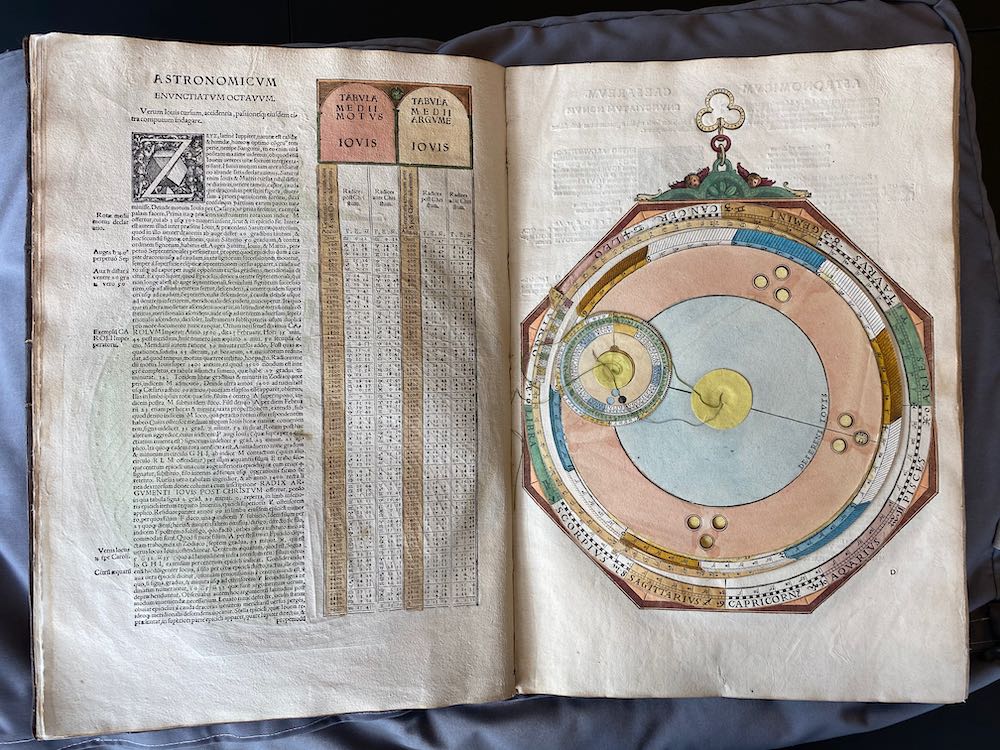
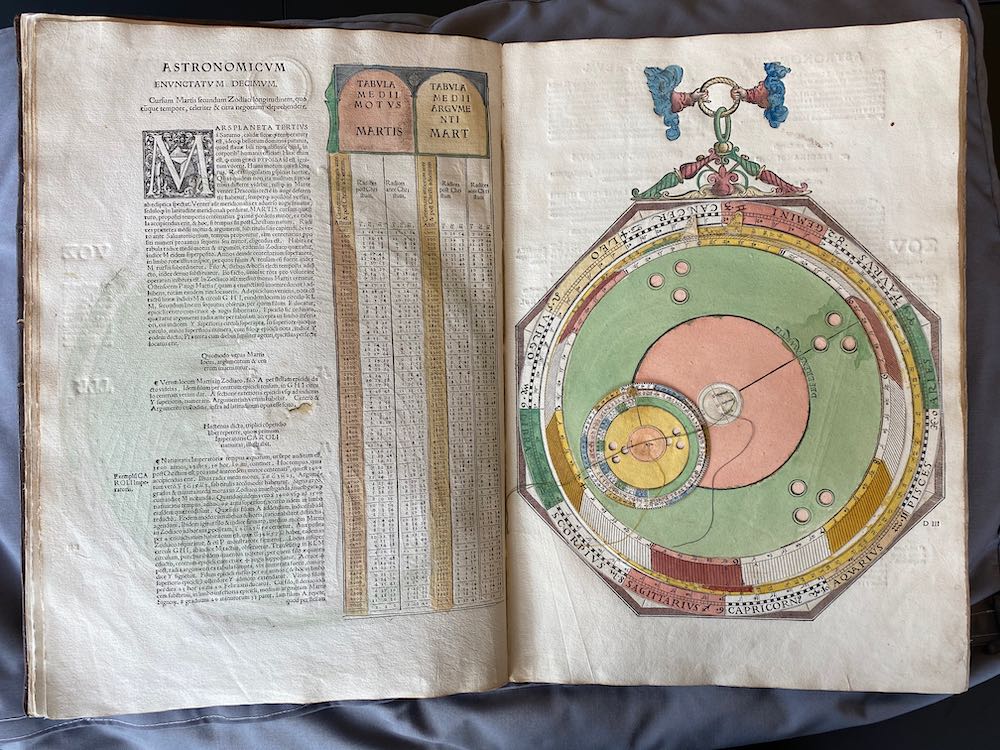
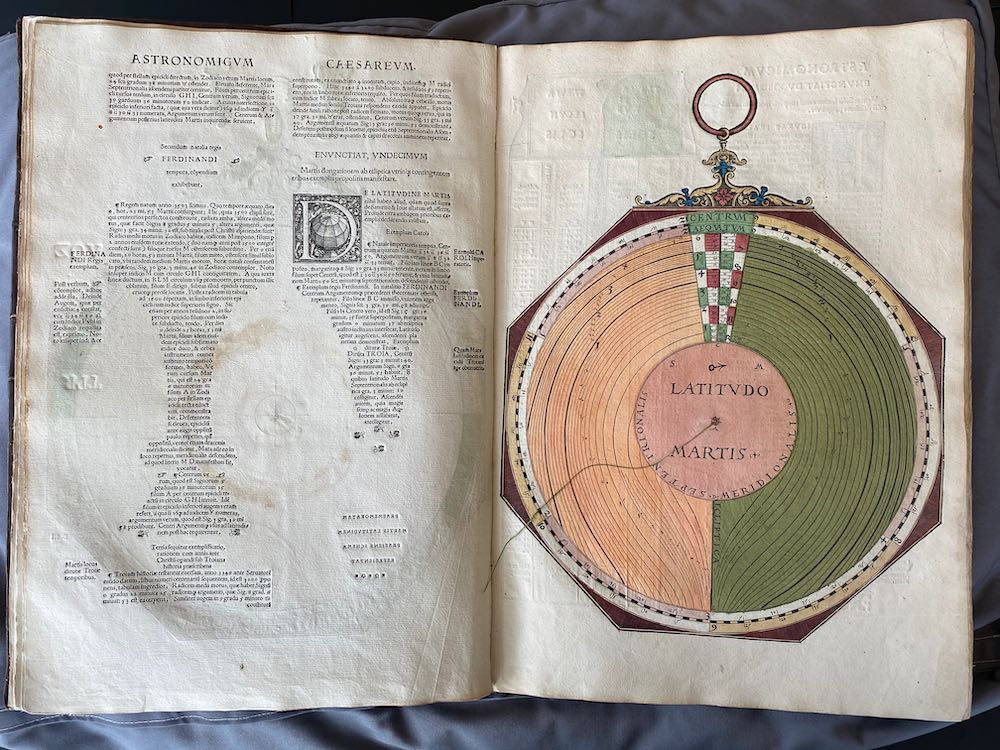
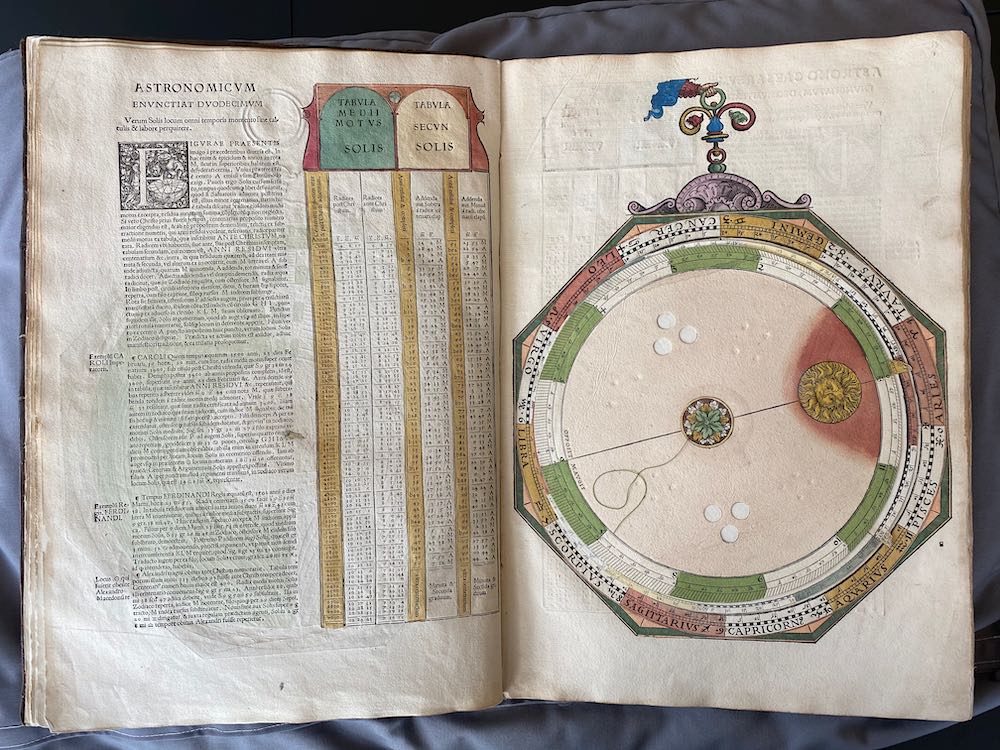
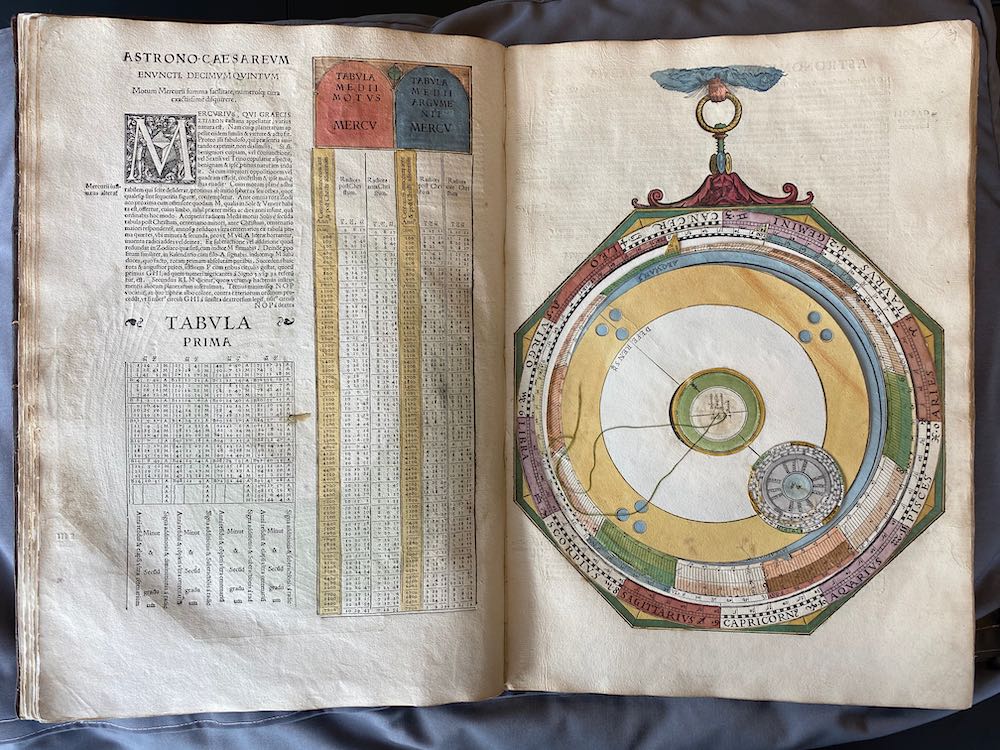
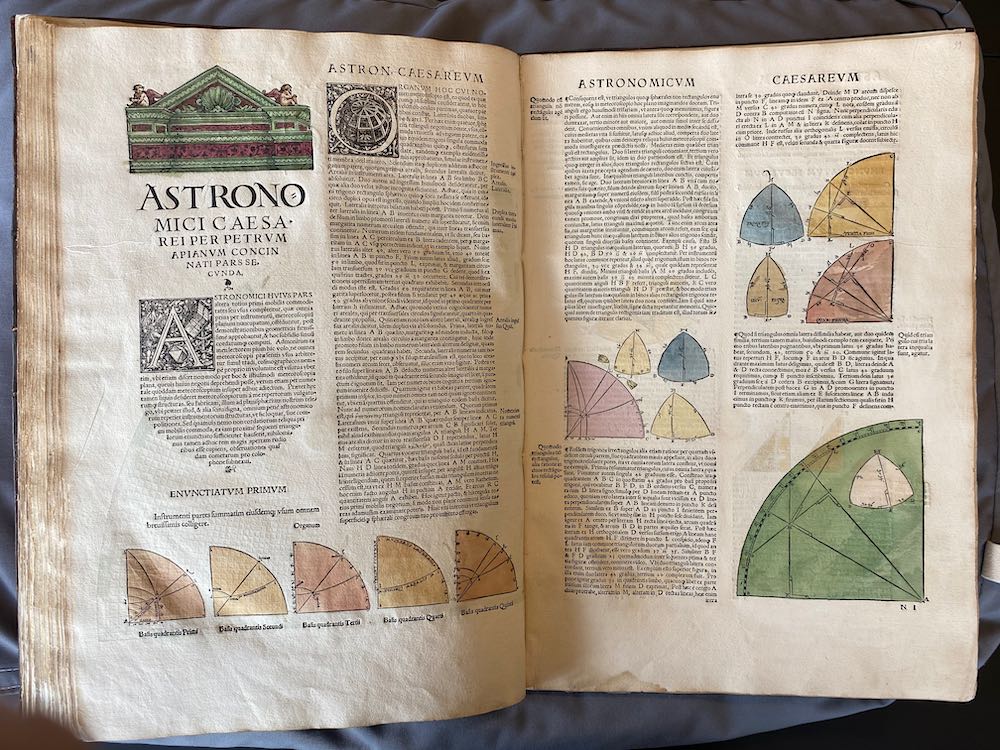
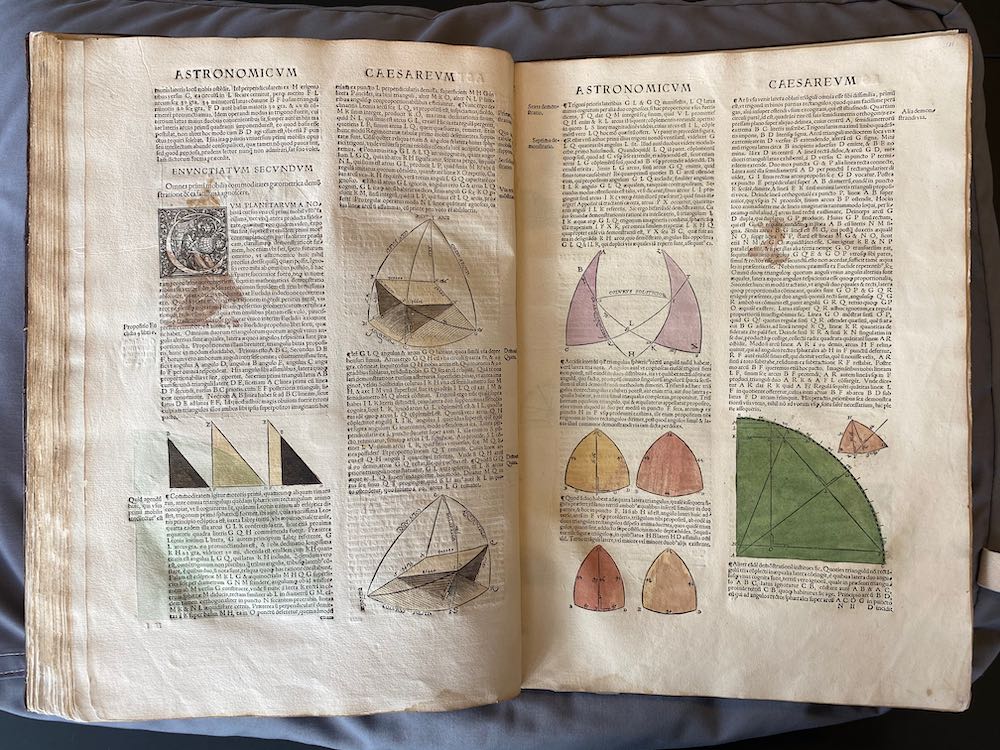
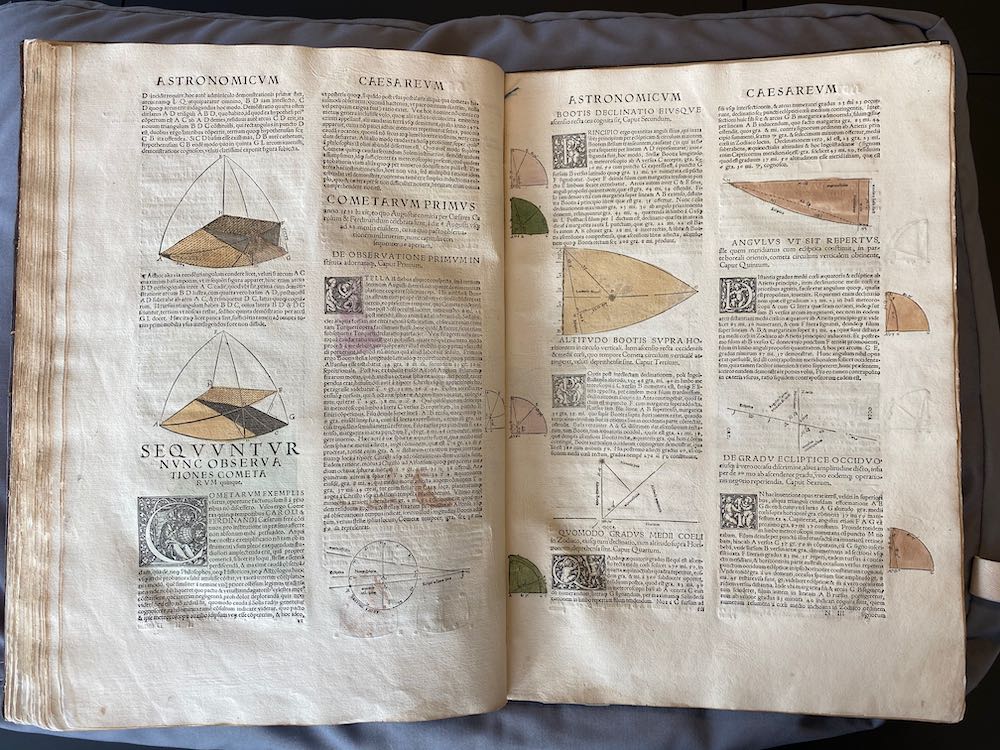
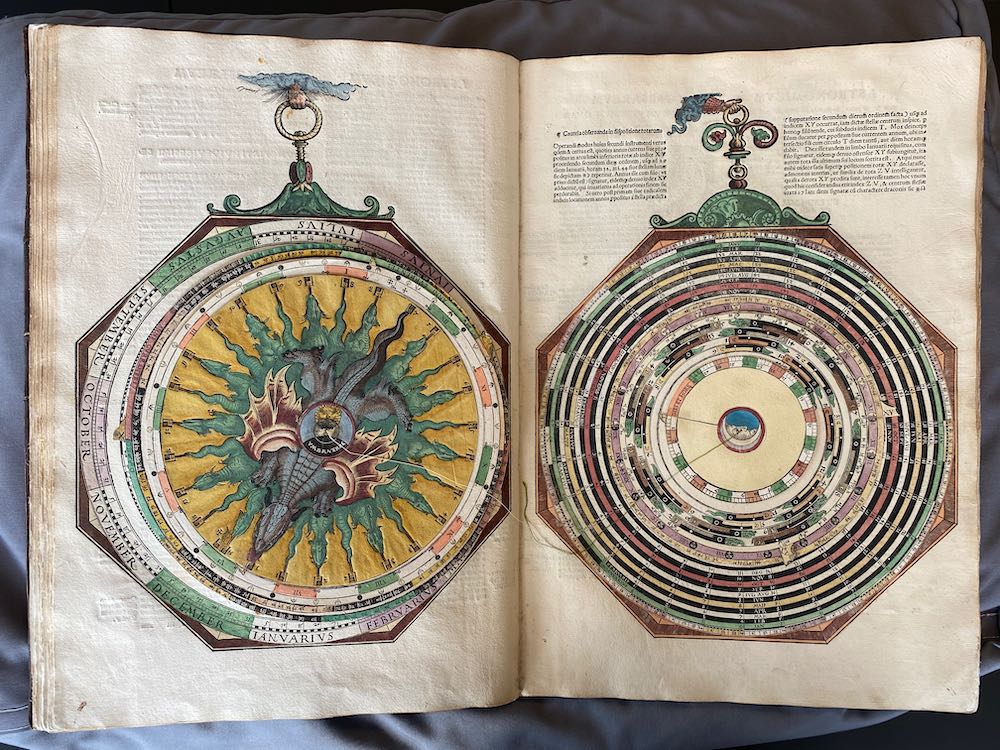
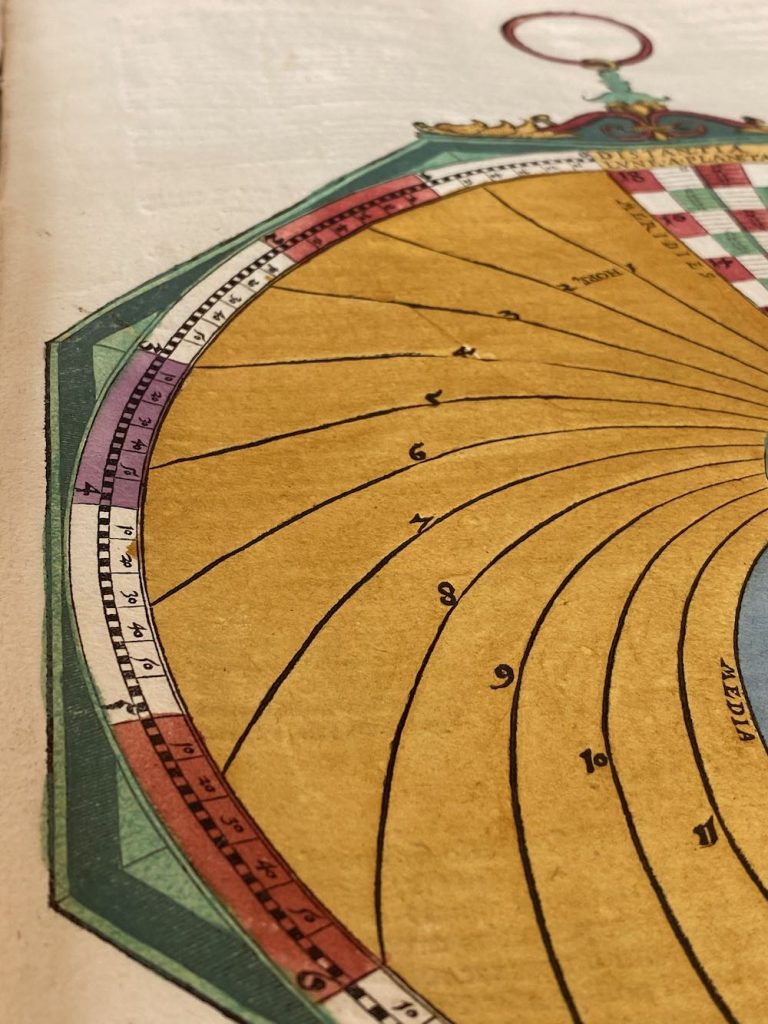
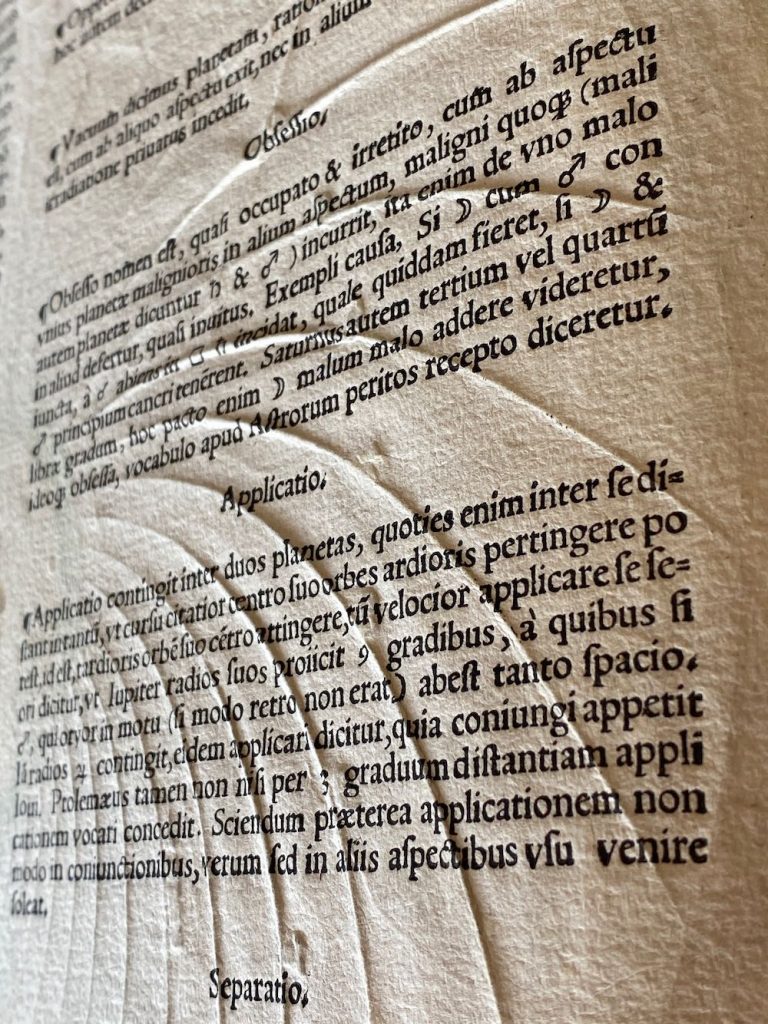
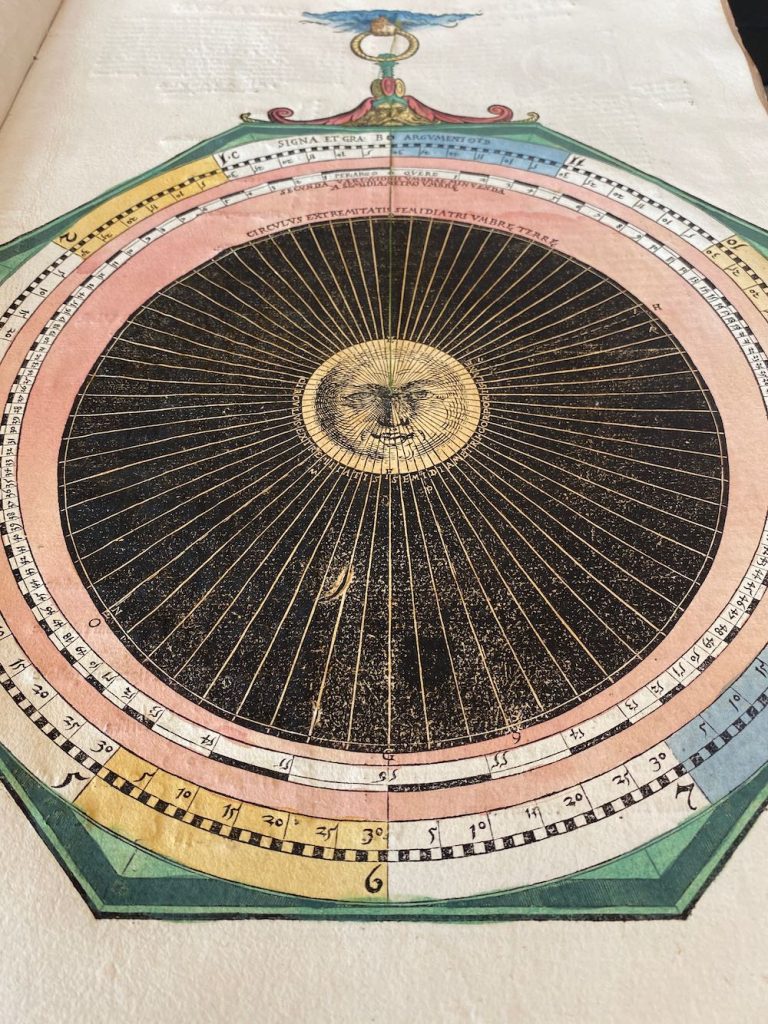
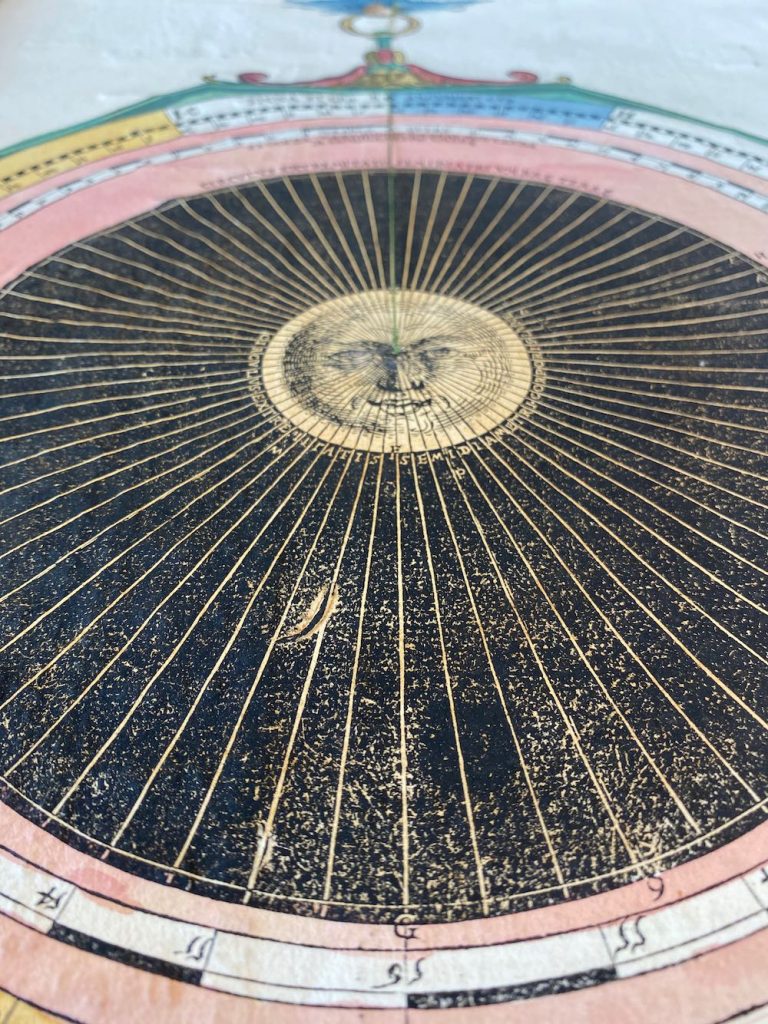
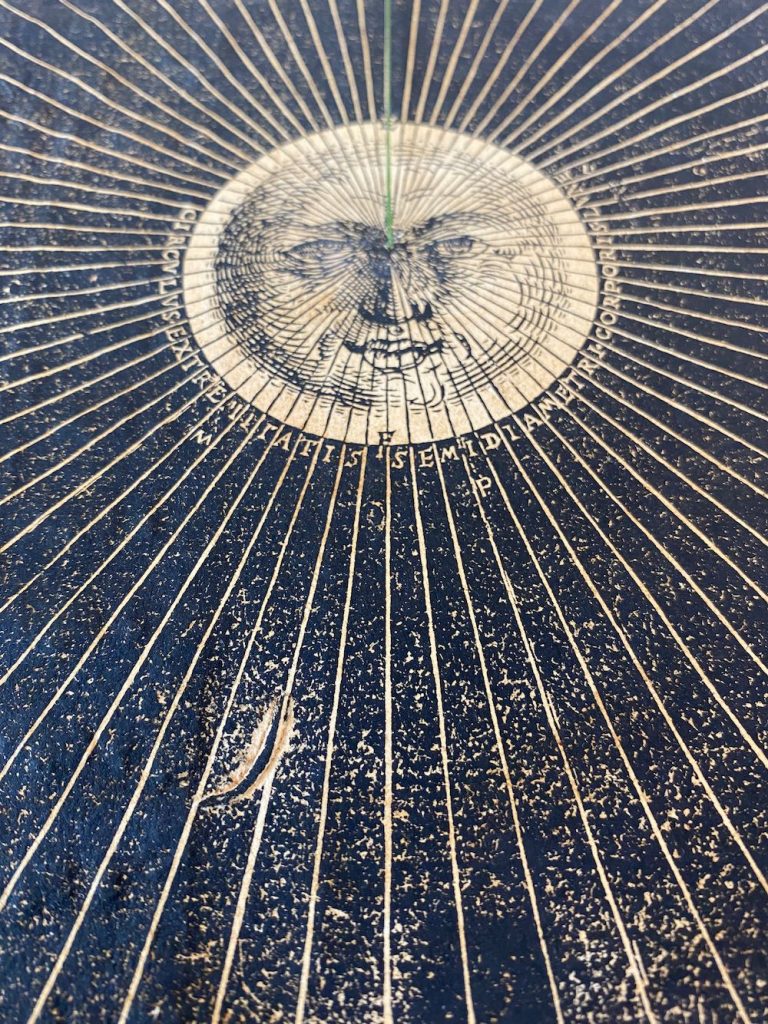
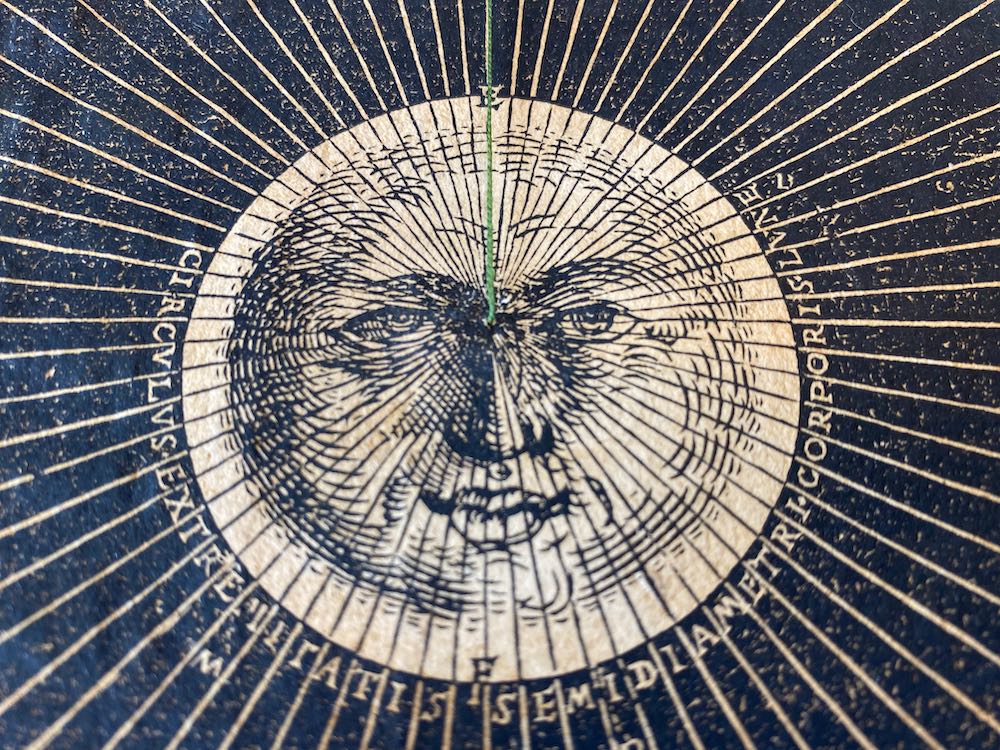
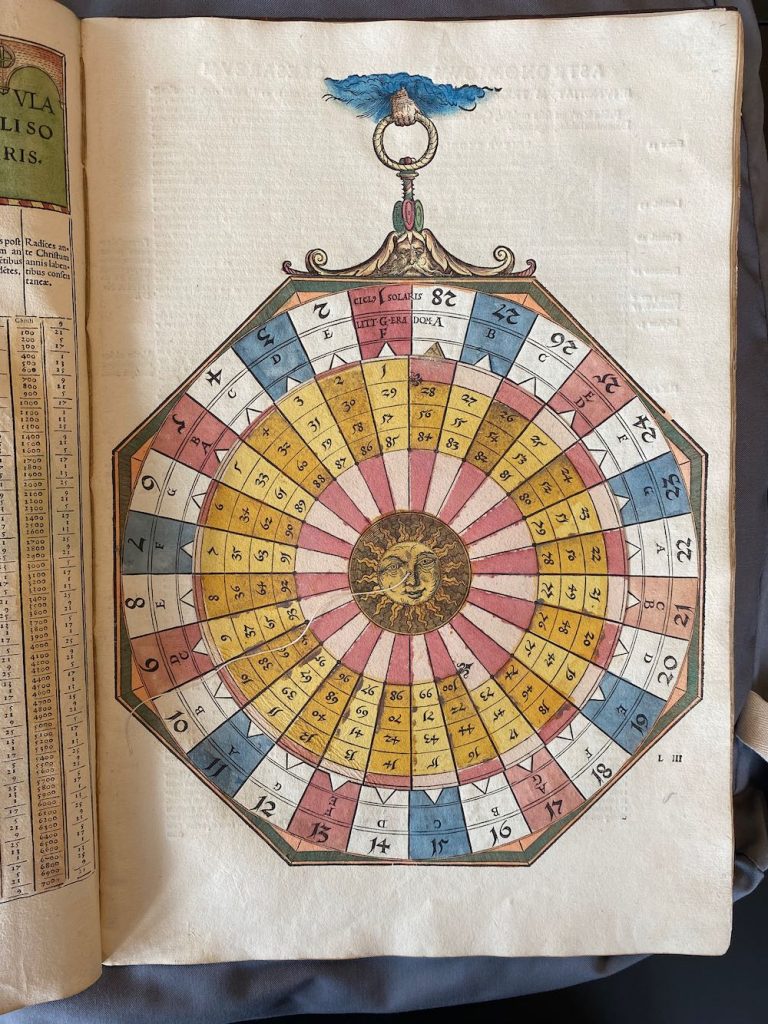
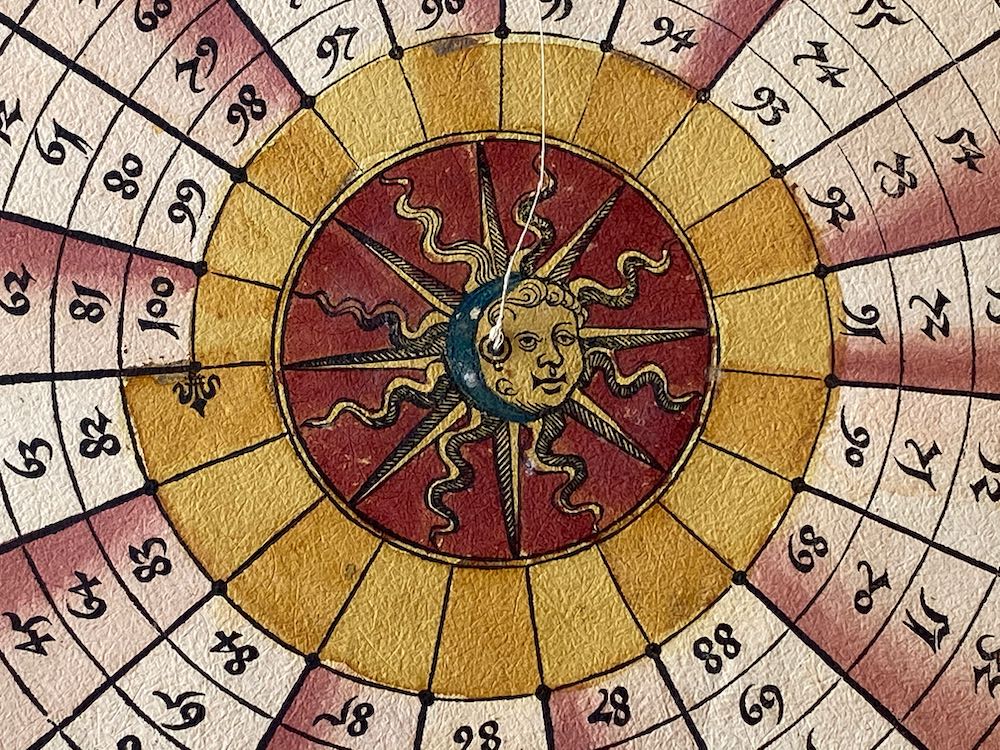
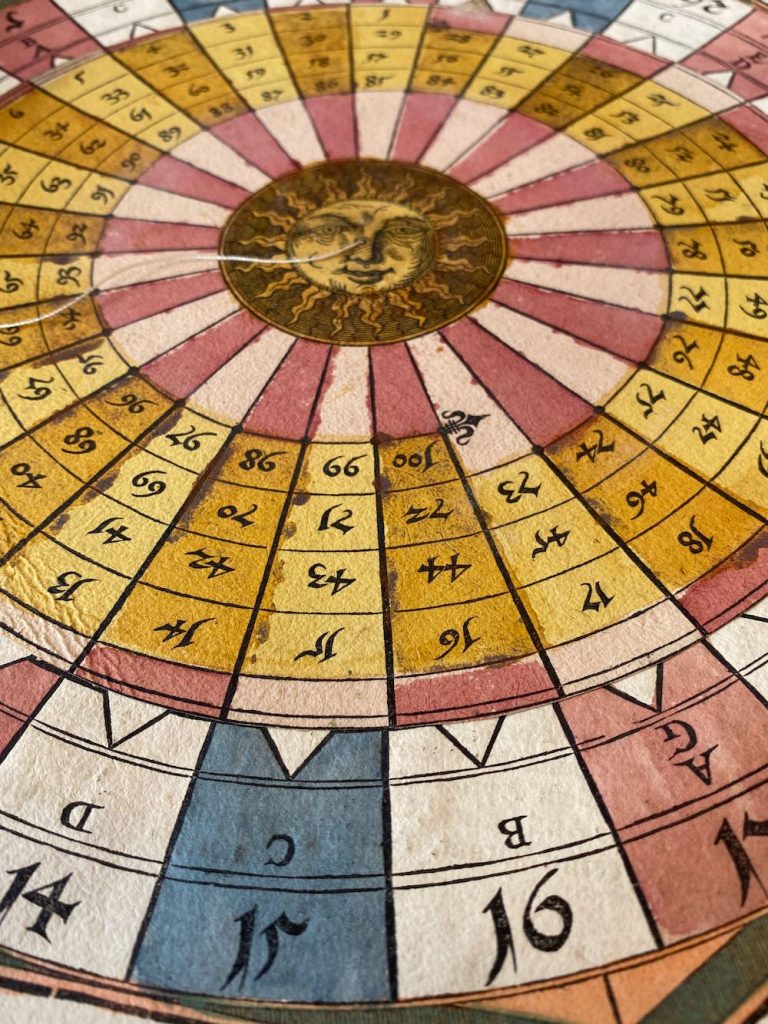
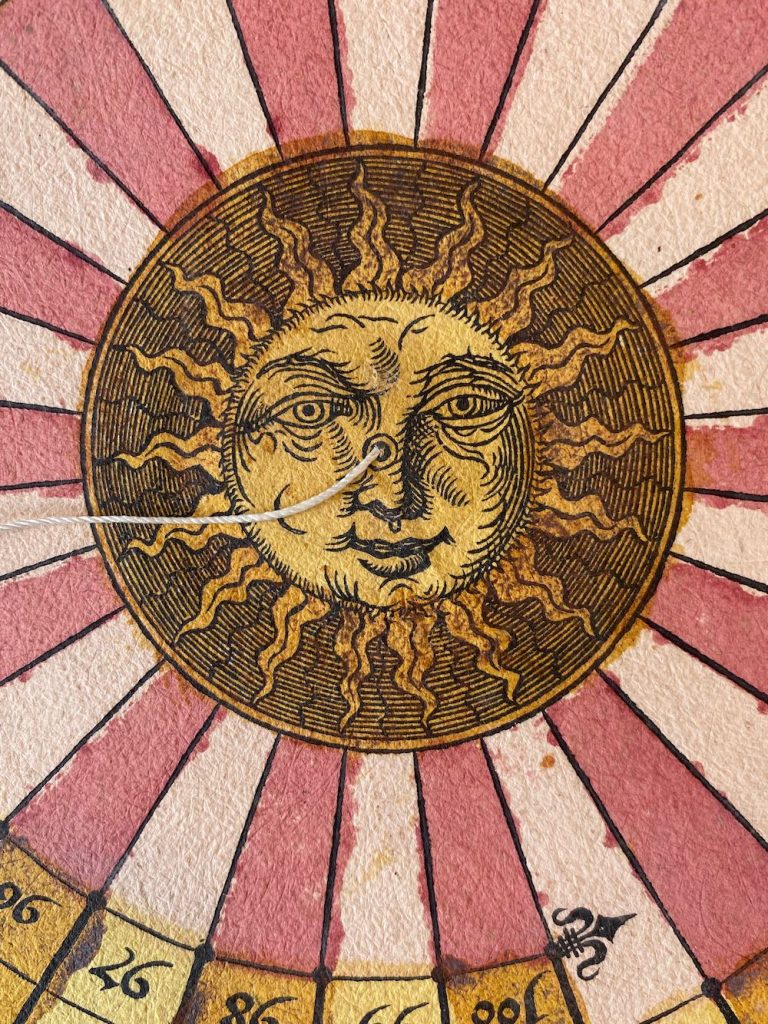
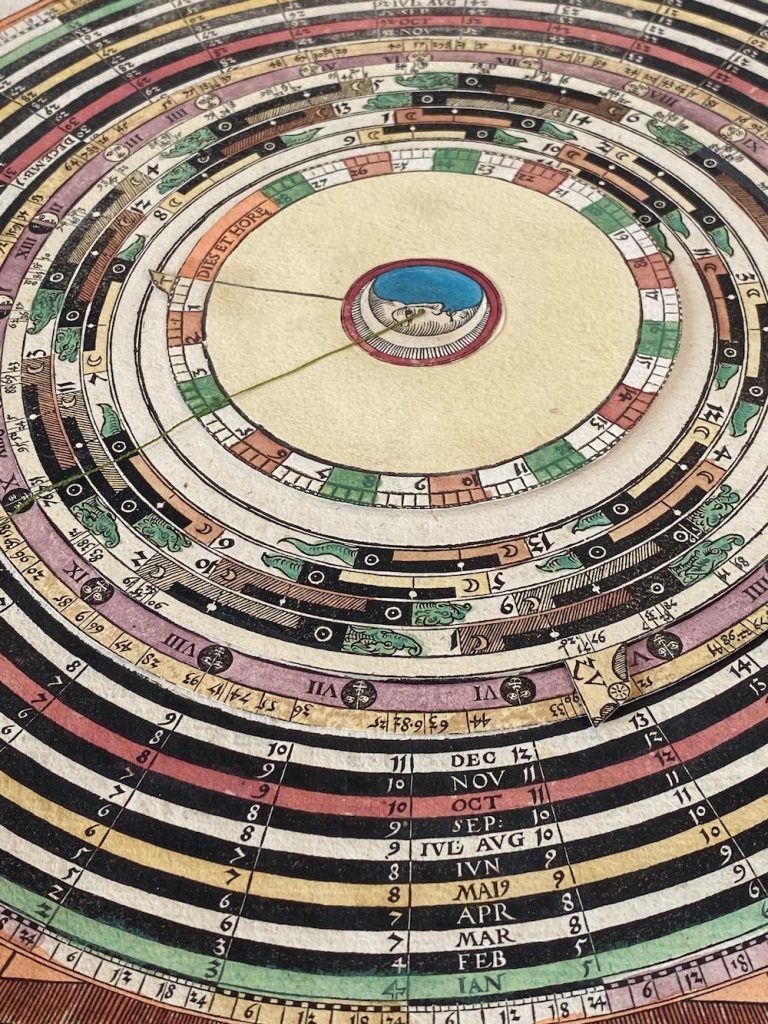
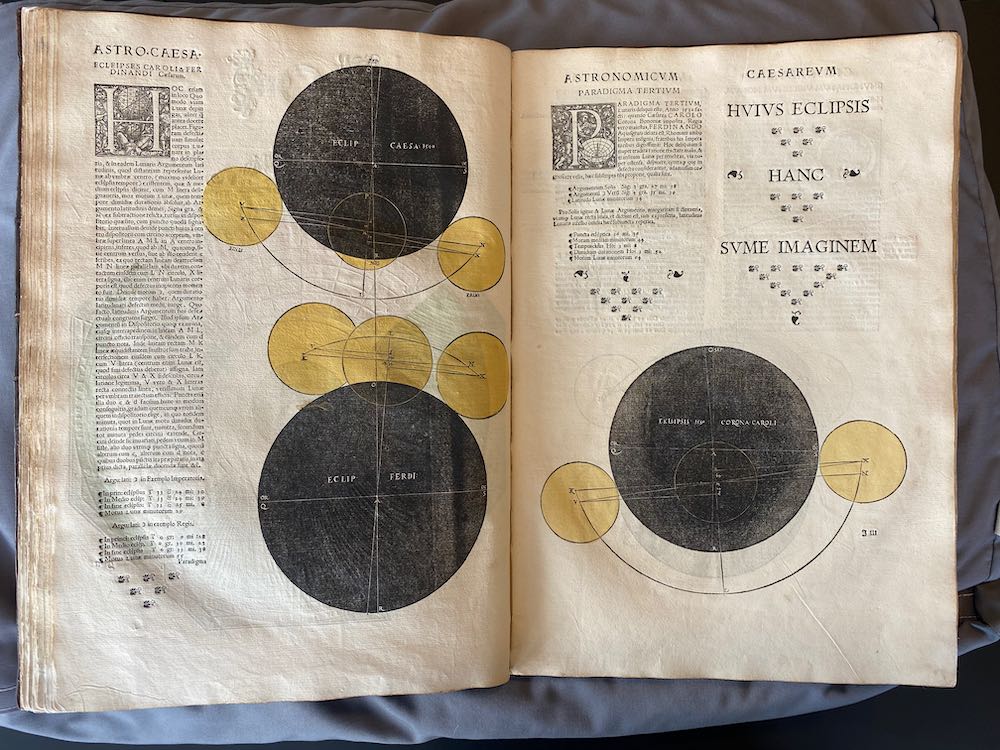
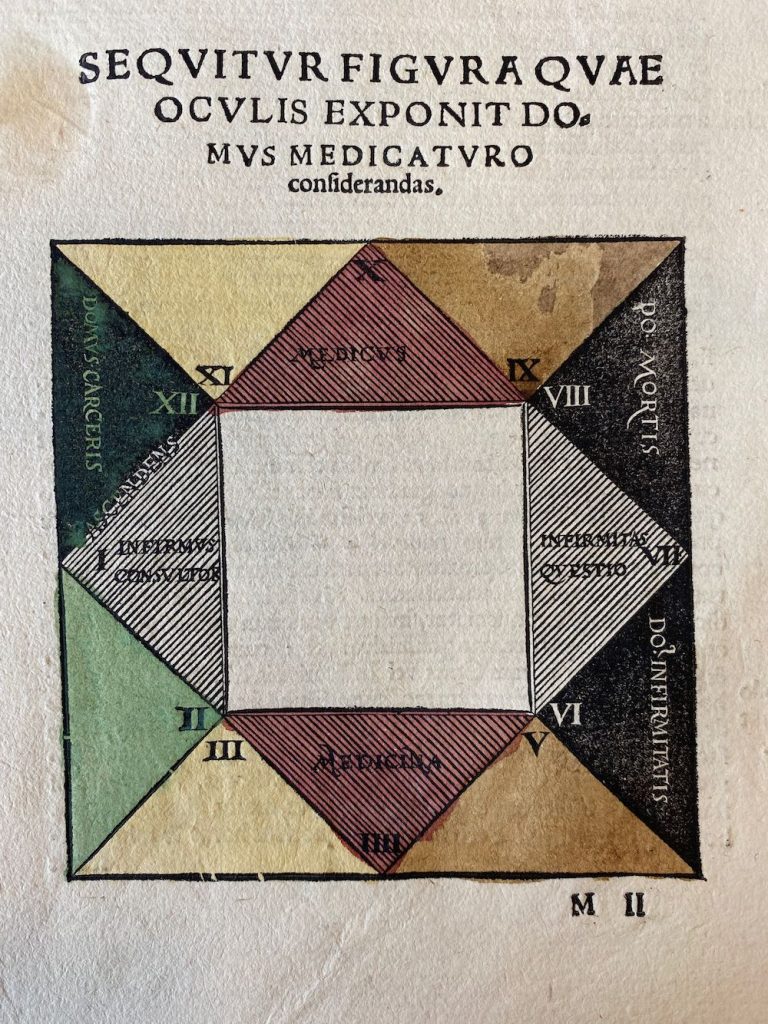
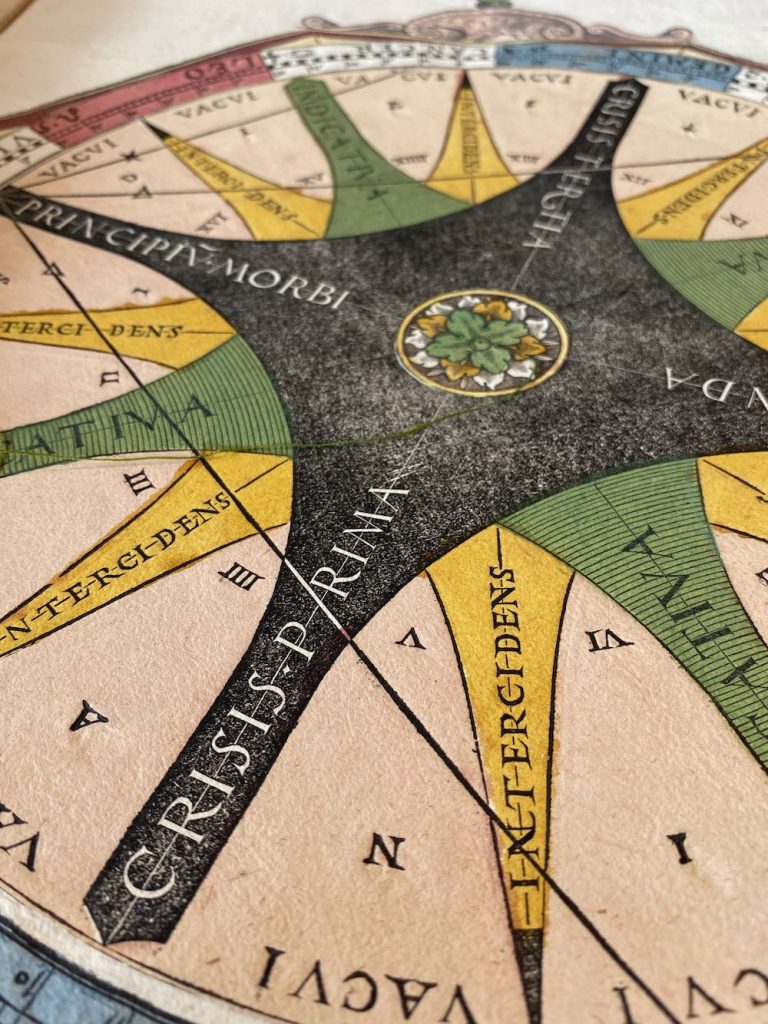
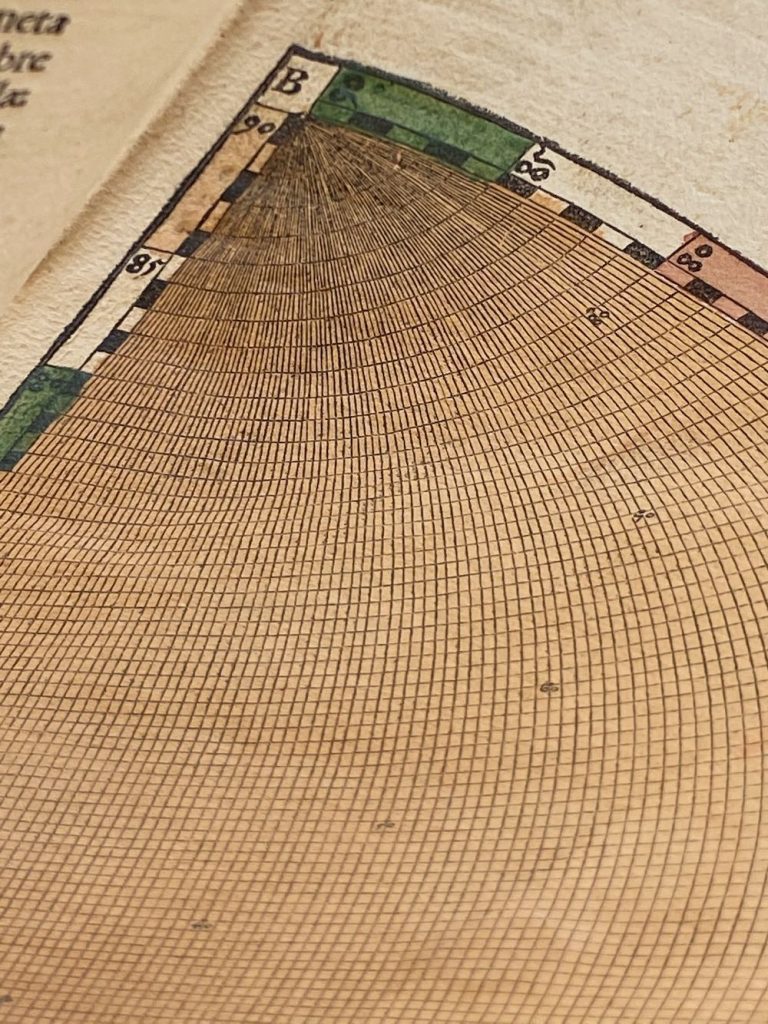
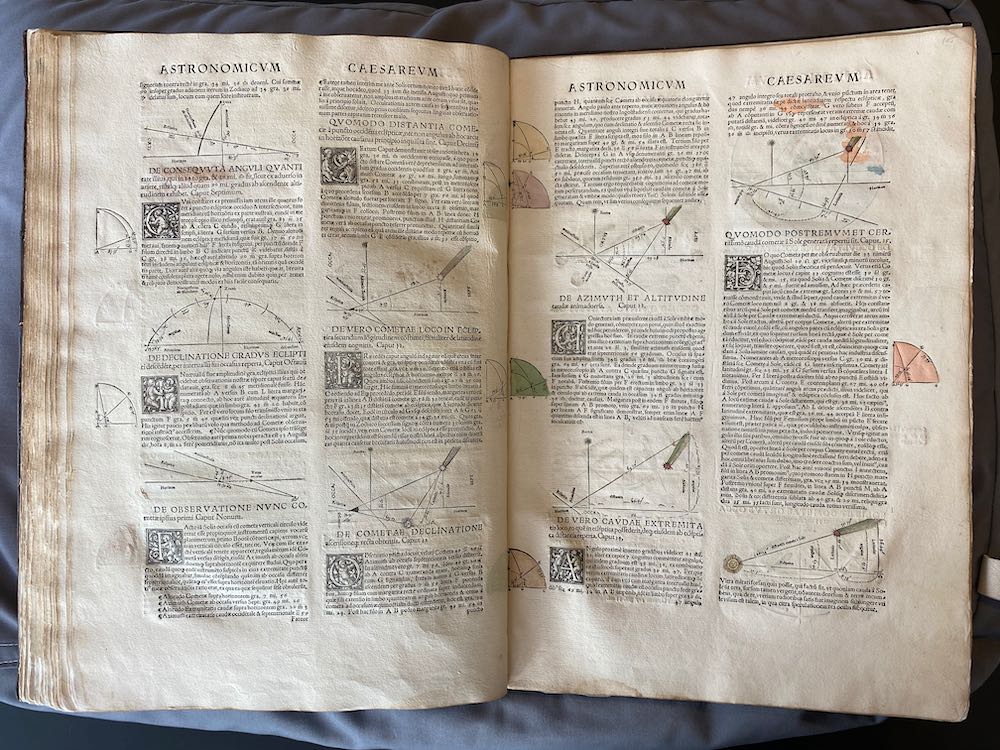
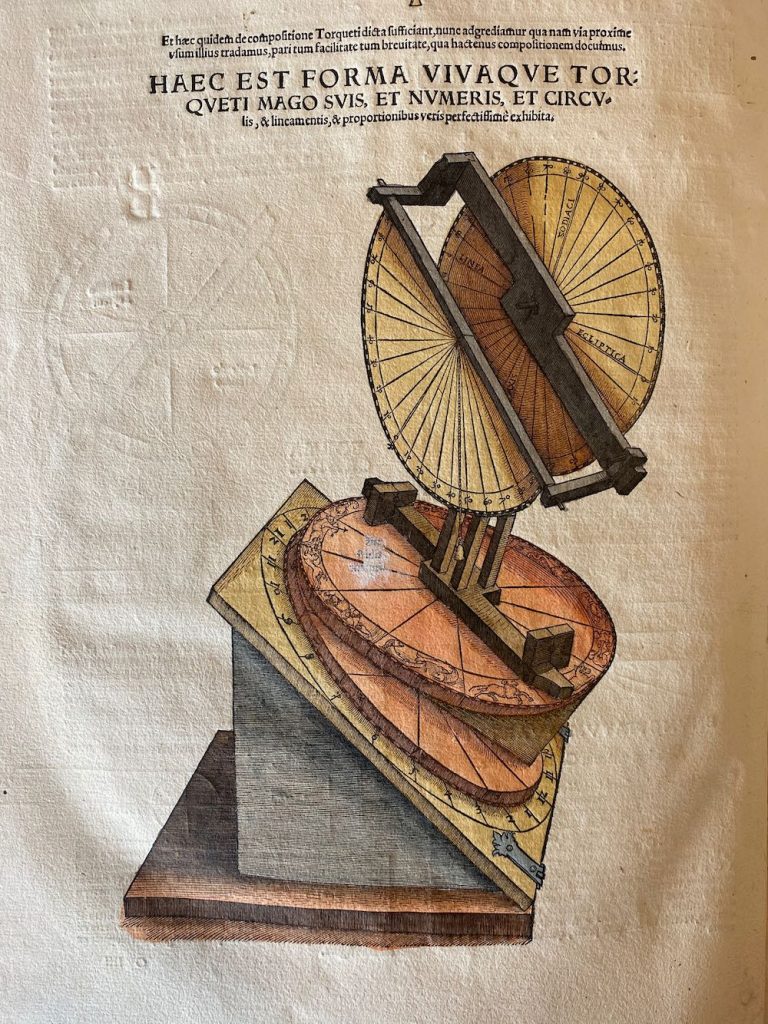
Drie prachtige draken
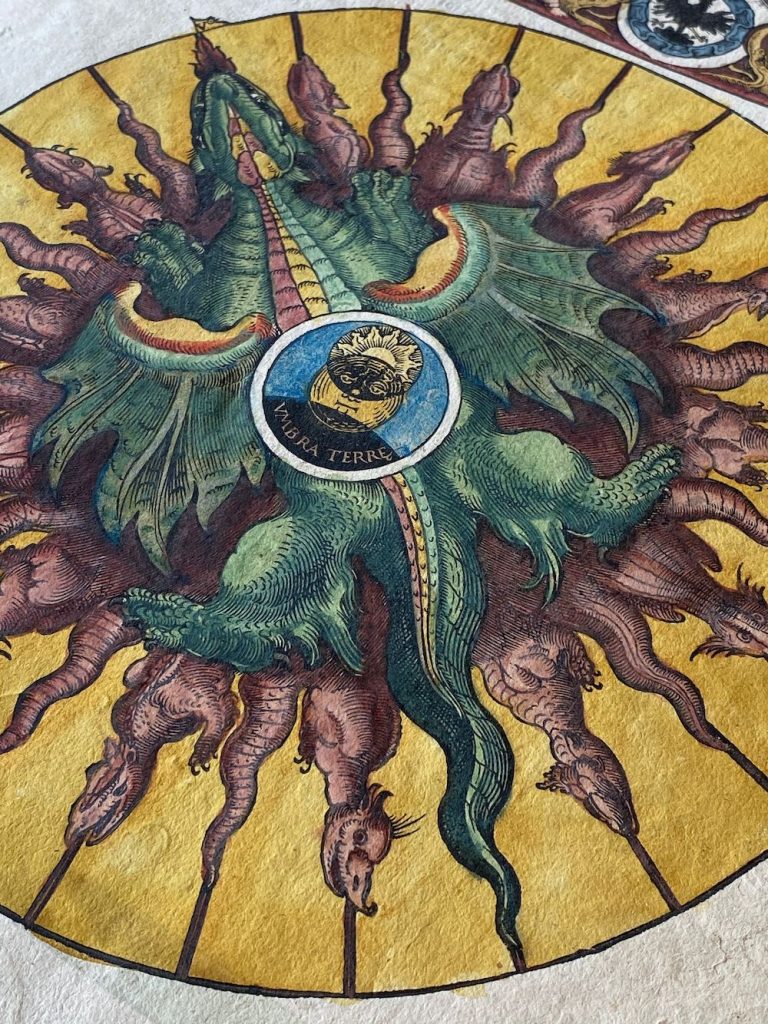
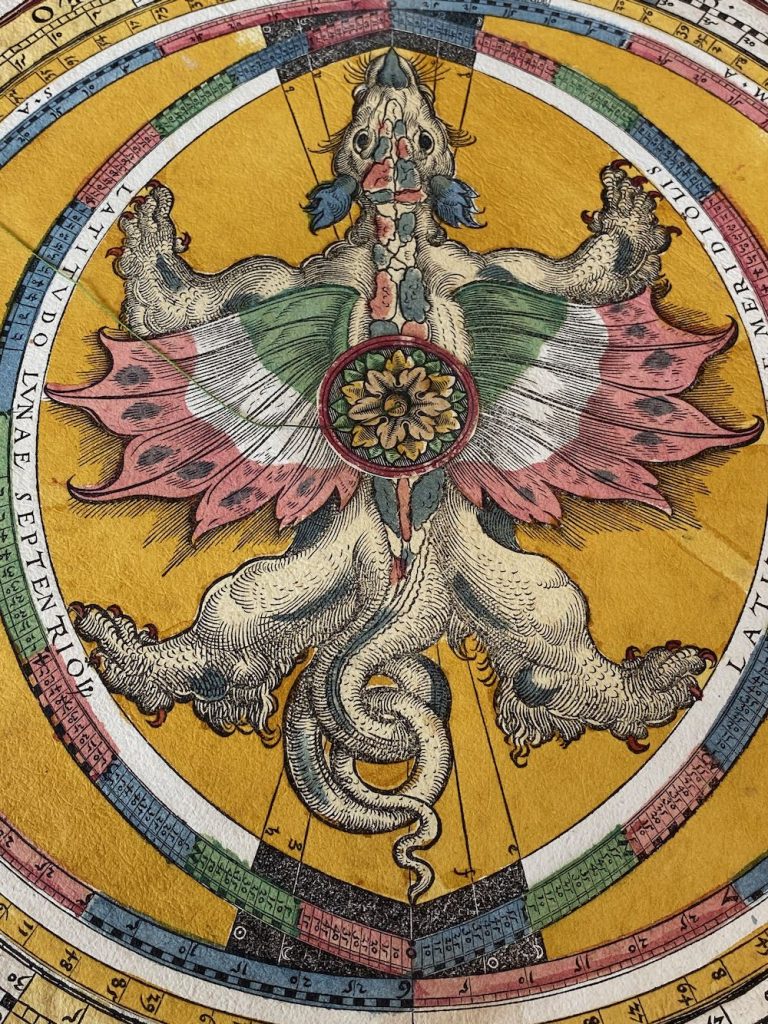
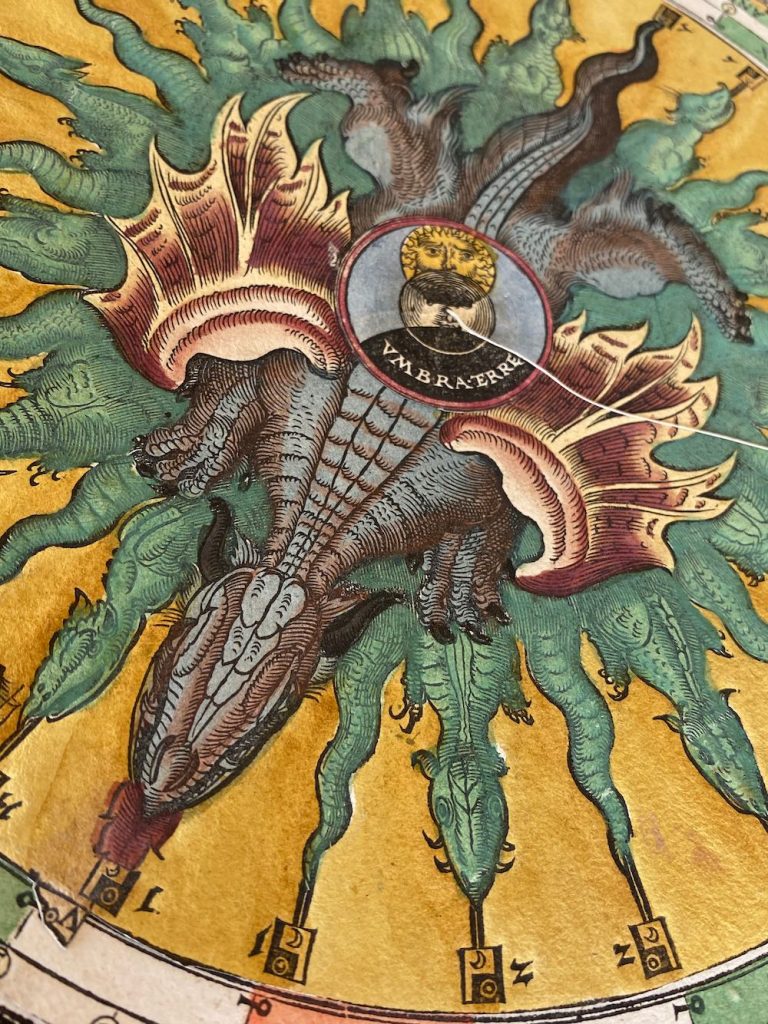
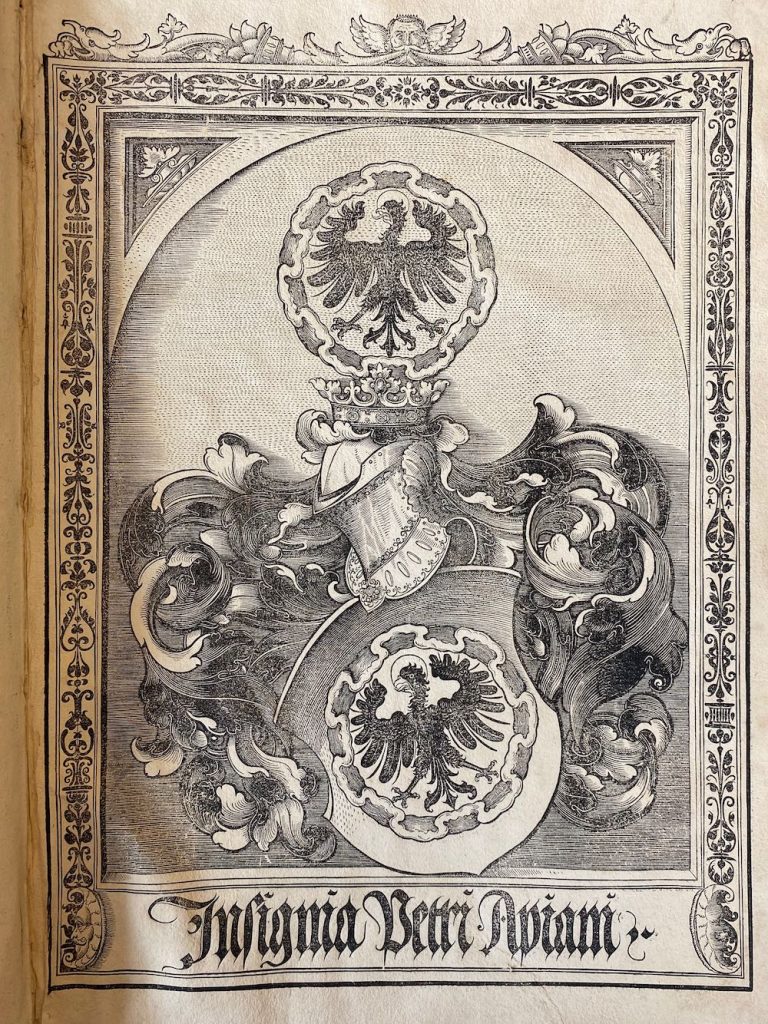
– – – – – – – – – – – – – – – – – – – – – – – – – – – – – – – – – – – – – – – – –
Wat een ongelofelijk boekwerk, zeker voor die tijd. Nog voor Copernicus en dus gebaseerd op de kennis van Ptolemeus. Het boek werd onder de aandacht gebracht in een FB groep. Het wordt geveild en het minimum bod is 150.000$, maar met veilingkosten kom je dan op minimaal 187.500$. Da’s niet weinig. Heel blij met de hoge resolutie foto’s van de prachtige inhoud. In Wenen staat er een te koop voor 850.000 euro…
Nog een origineel ingezien, in Florence
In 2023 was ik op studiereis in Florence voor mijn plannen betreft Galilei. De manuscripten van hem liggen daar opgeslagen in de Bibliotheca Centrale Nazionale di Firenze. Het kostte met veel geduld om, binnen te komen, maar het is gelukt. Zoals bekend had ik een aanbevelingsbrief nodig van een erkend instituut om überhaupt iets te zien te krijgen. Die brief is onderweg, morgen weer een poging. Tijdens mijn eerste bezoek kreeg ik het wel voor elkaar om nog (mijn tweede) een originele Astronomicum Caesareum in te zien. Deze was echter redelijk ‘verwoest’ door de overstroming van 1966 in Florence.
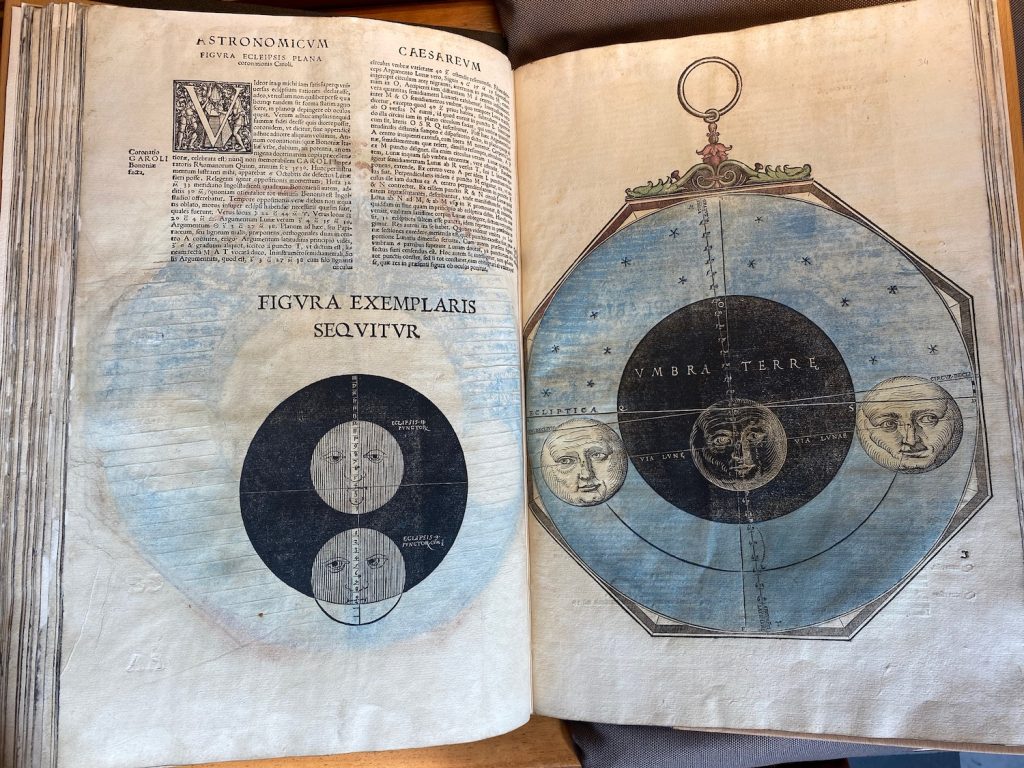
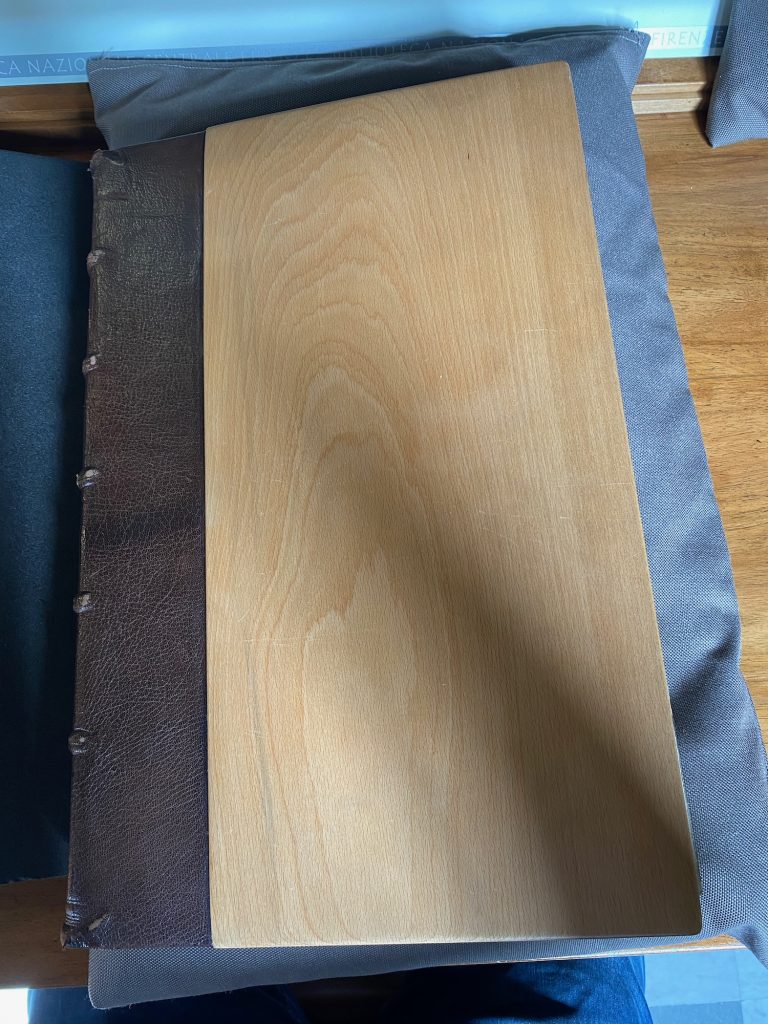
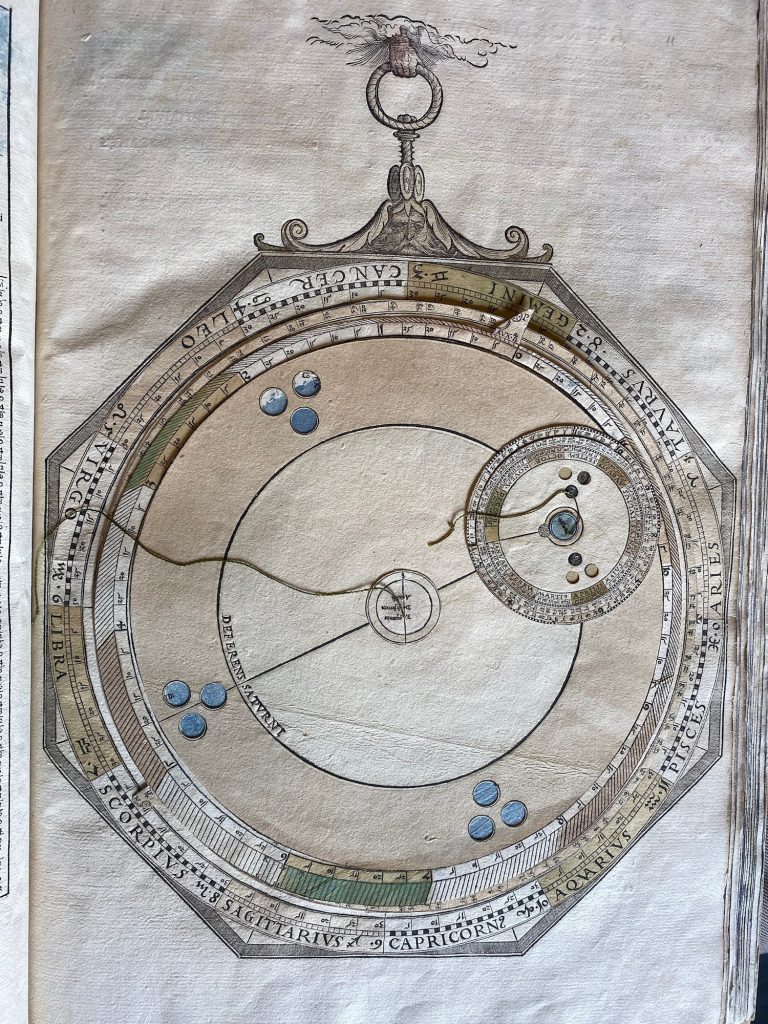
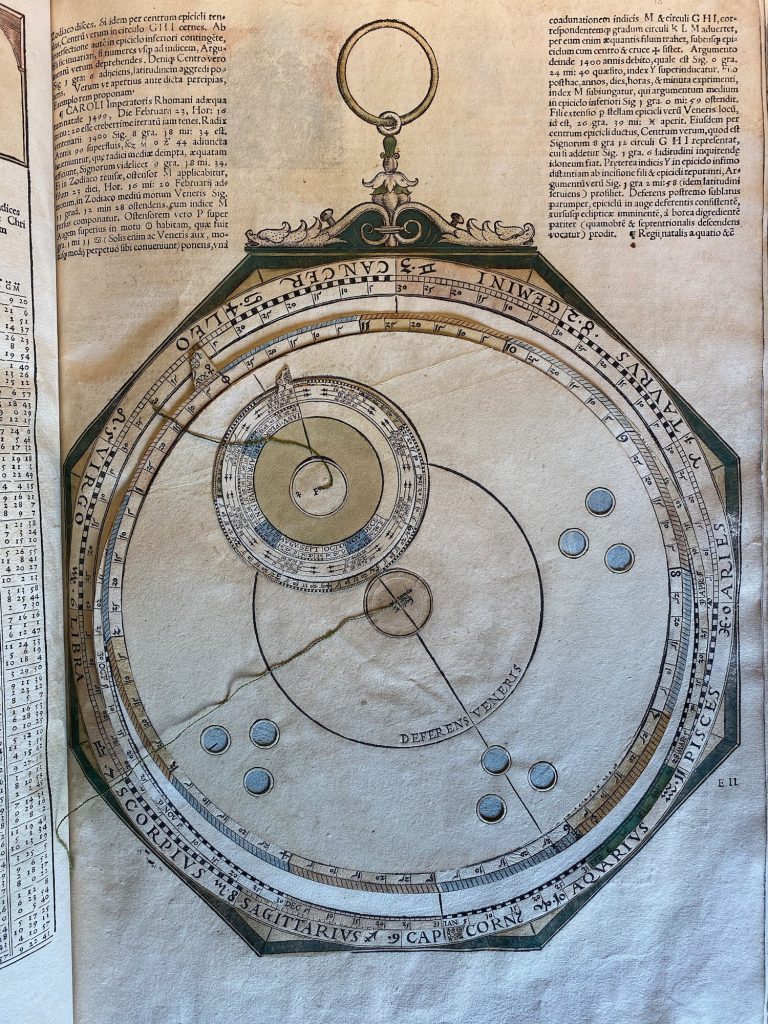
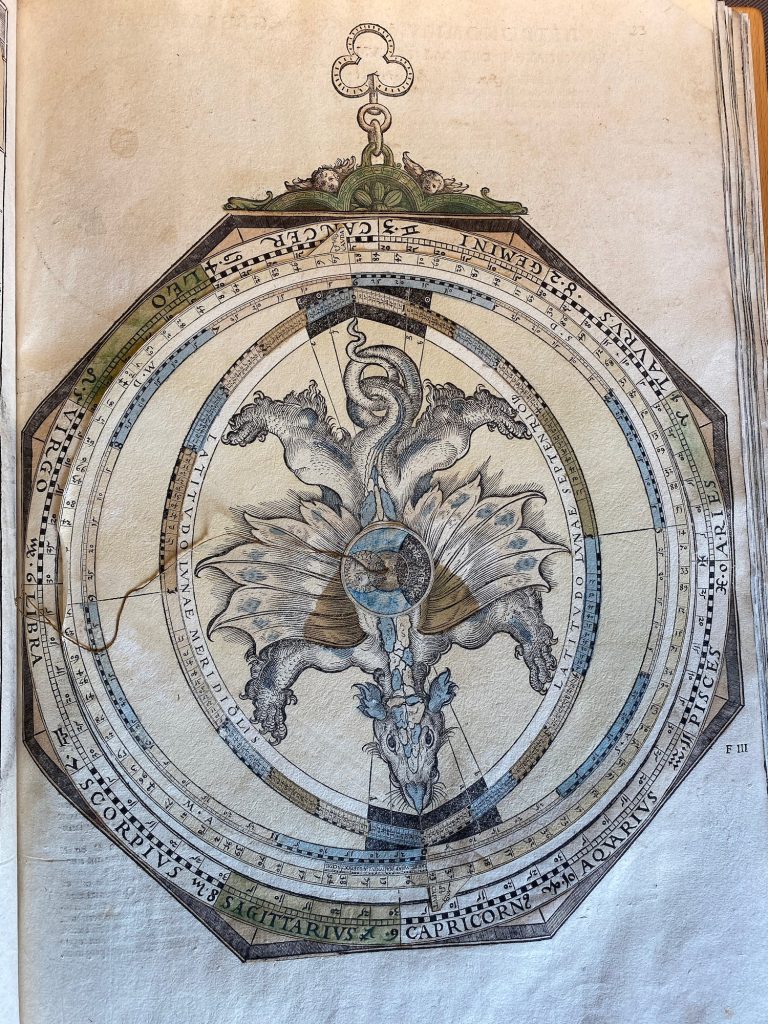
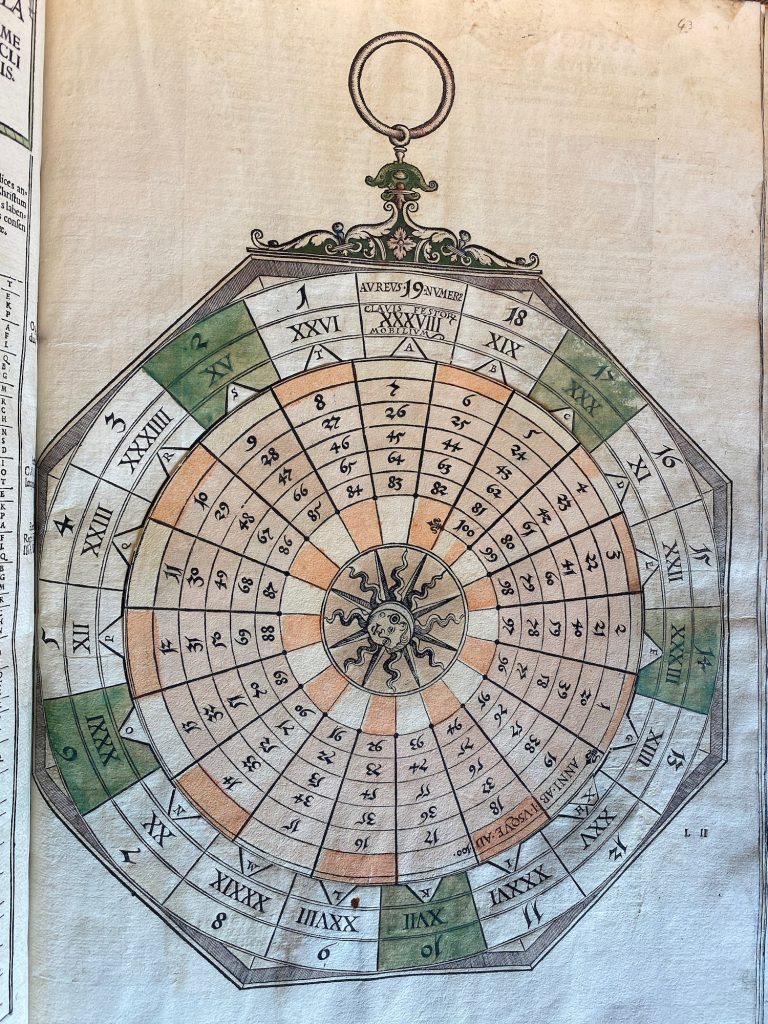
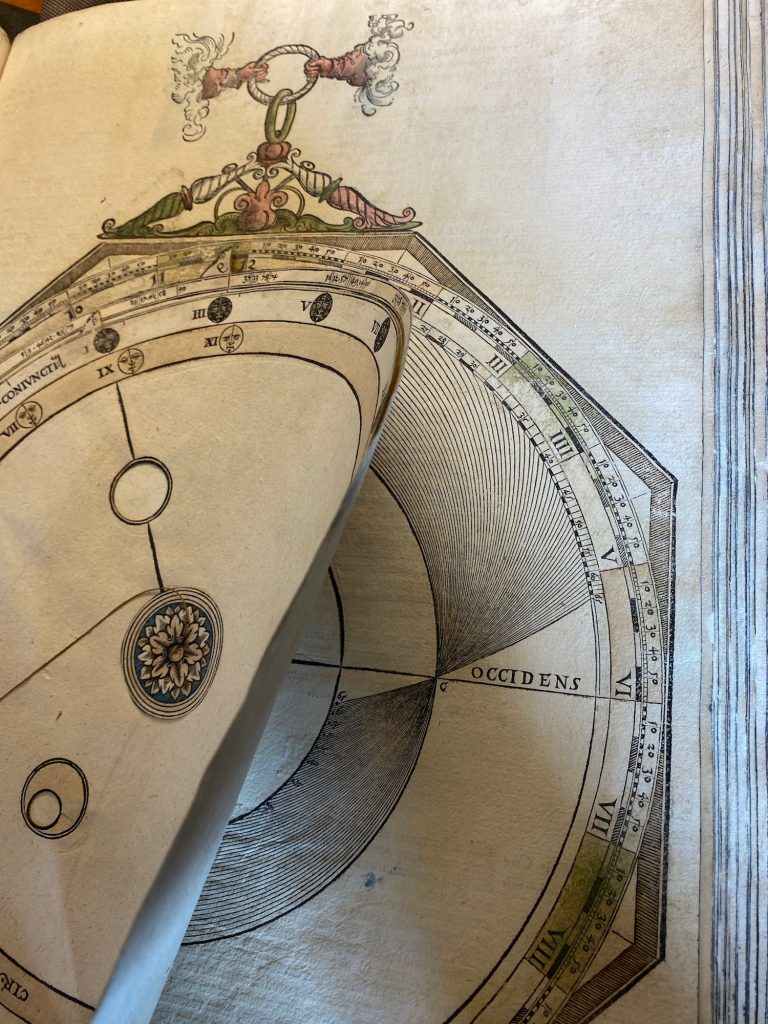
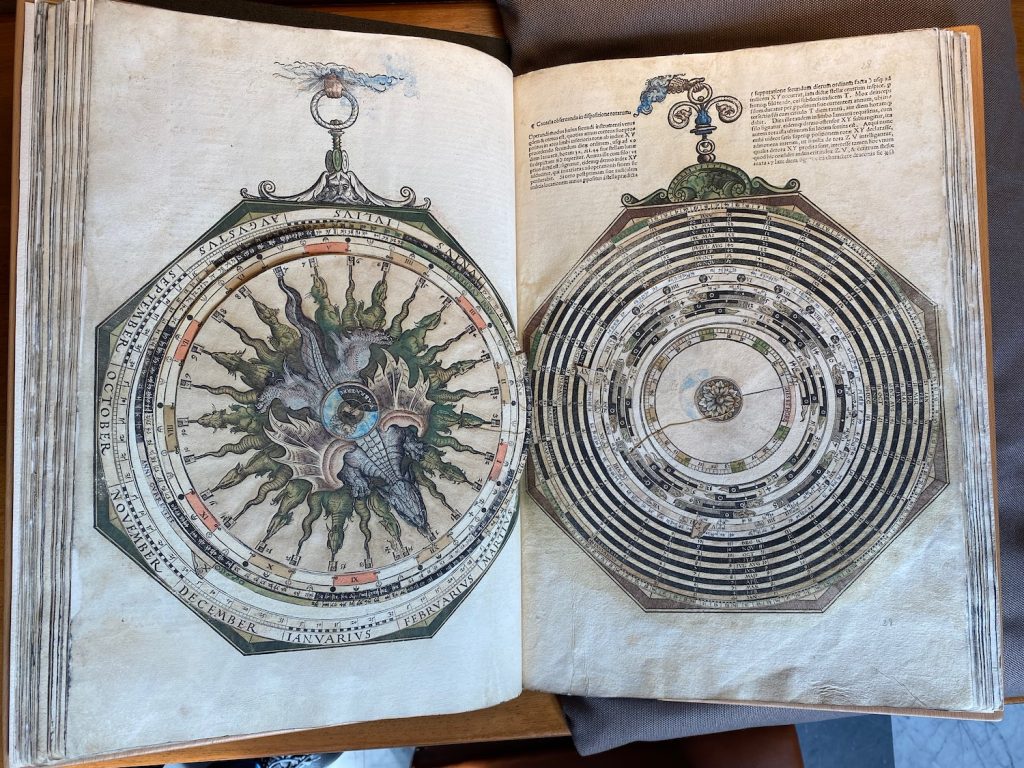
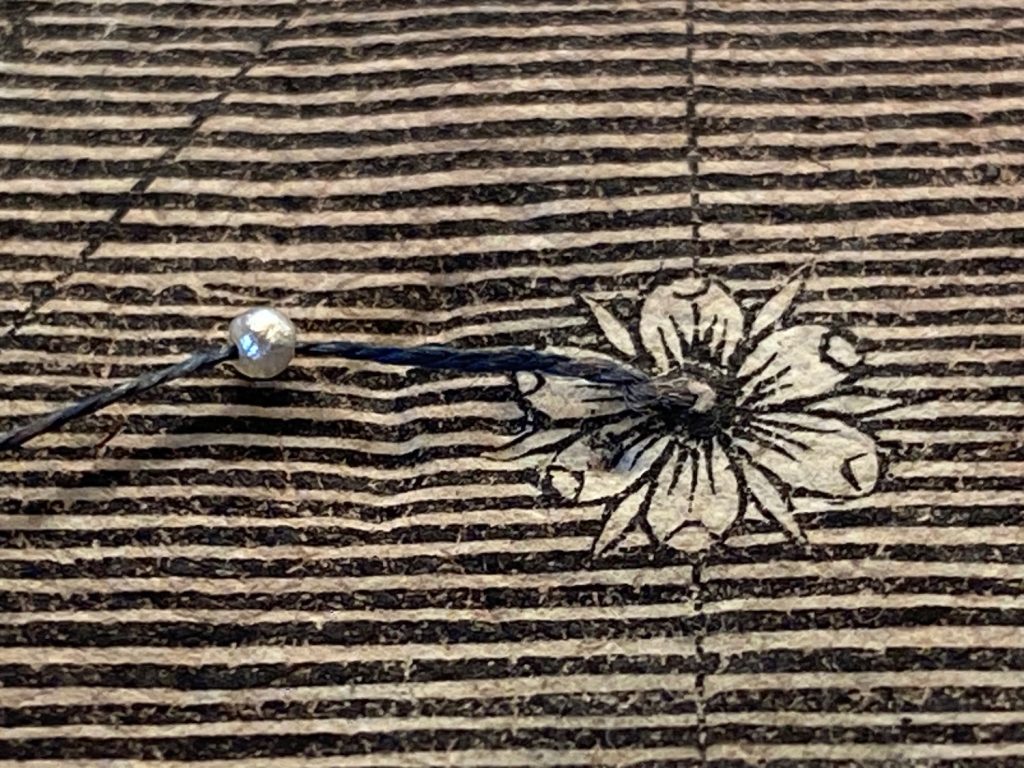
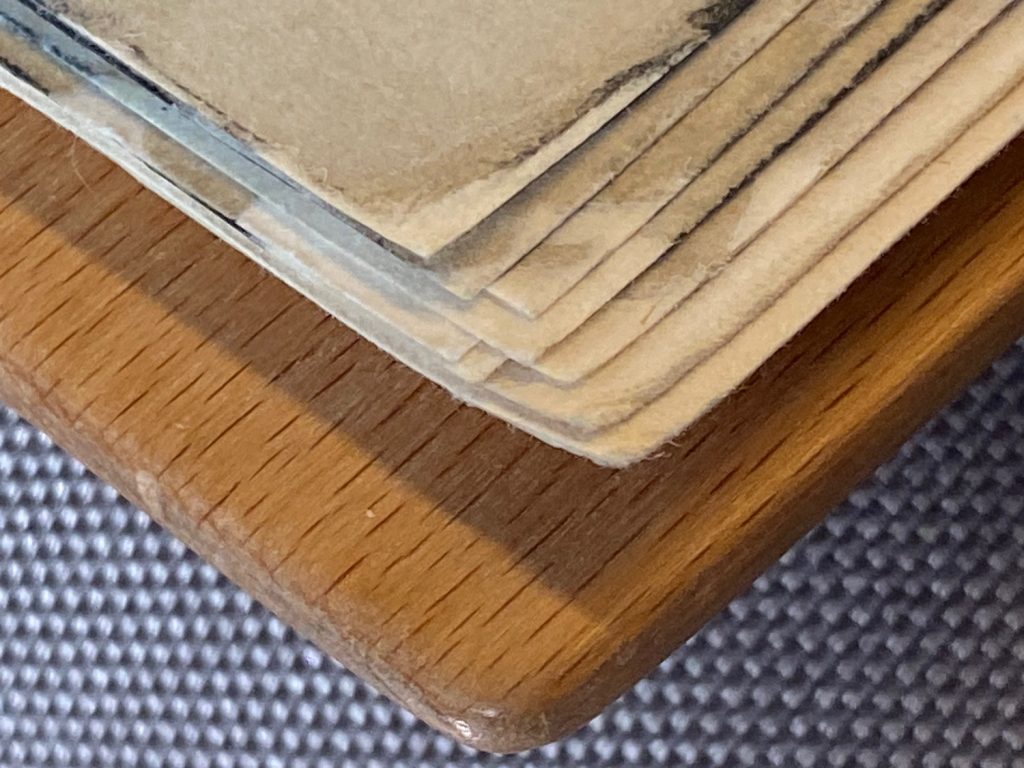
Een compleet nieuwe kaft waarbij niet echt moeite is gedaan er iets moois van te maken: triplex… Wel de eerste keer dat ik een kraaltje tegenkom, zoals die in de boeken horen te zitten. Enige in het hele boek, dus wellicht zelfs nog origineel. Aan het eind waren 8 blanco pagina’s qnwezig die ik niet kan plaatsen. Ook hier mooi te zien dat Volvelle 21 onder alle schijven een hergebruikte basispagina heeft gebruikt, zoals onderzocht met Lars Gislen. Precies dat wat dit origineel eigenlijk zo mooi maakt is hier door de waterschade volledig verwoest. Erg jammer, want verder wel compleet. Ook hadden ze er een kopie van de Facsimile versie, nummer 255.
Over dit boek
[Petrus Apianus]. Ingolstadt: In aedibus nostris, May 1540.
First edition of the “most spectacular contribution of the book-maker’s art to sixteenth-century science”. First edition of the “most spectacular contribution of the book-maker’s art to sixteenth-century science” (Owen Gingerich). Large folio (18.6875 x 12.625 inches; 474 x 320 mm). [59] leaves.
“The most spectacular contribution of the book-maker’s art to sixteenth-century science was without doubt the Astronomicum Caesareum of Petrus Apianus. Designed for Charles V and his brother Ferdinand, the volume was in every way a luxurious and princely production. Its pages were large, brilliantly hand-coloured, and filled with ingeniously contrived mechanisms, sometimes with five or even six layers of paper disks, arranged to give planetary positions plus a variety of calendarial and astrological data. Published in 1540 at Apianus’s private press in Ingolstadt, the book graphically displayed Ptolemaic astronomy in a fashion fit for a monarch’s eyes” (Owen Gingerich, “Apianus’s Astronomicum Caesareum and Its Leipzig Facsimile,” in Journal for the History of Astronomy 2 (1971), pp. 168-177).
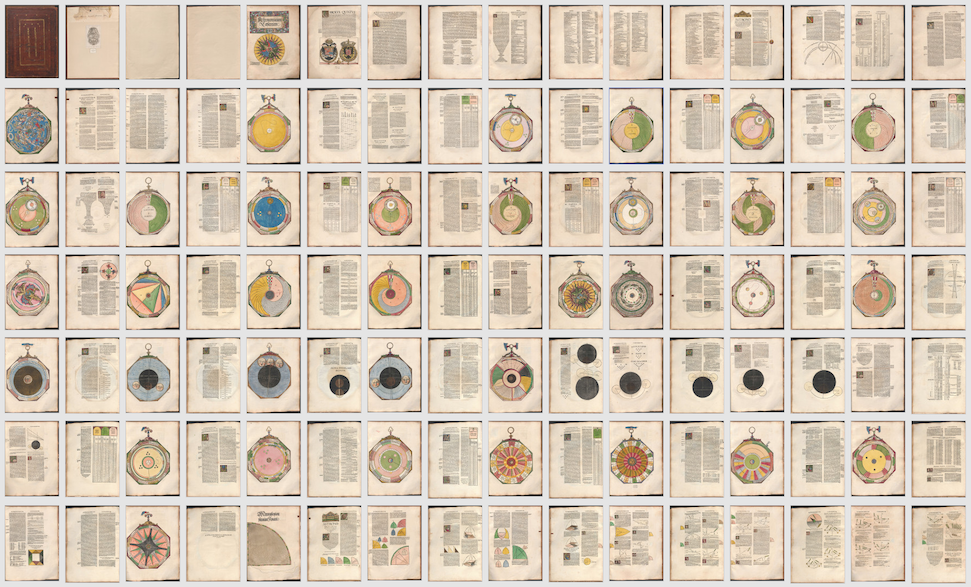
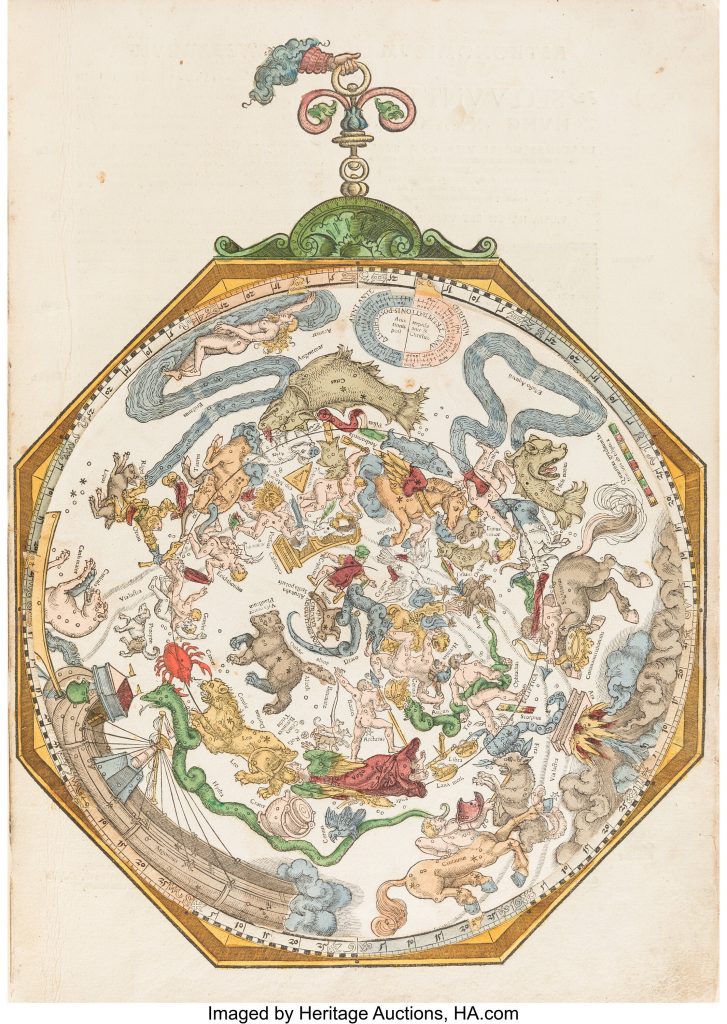
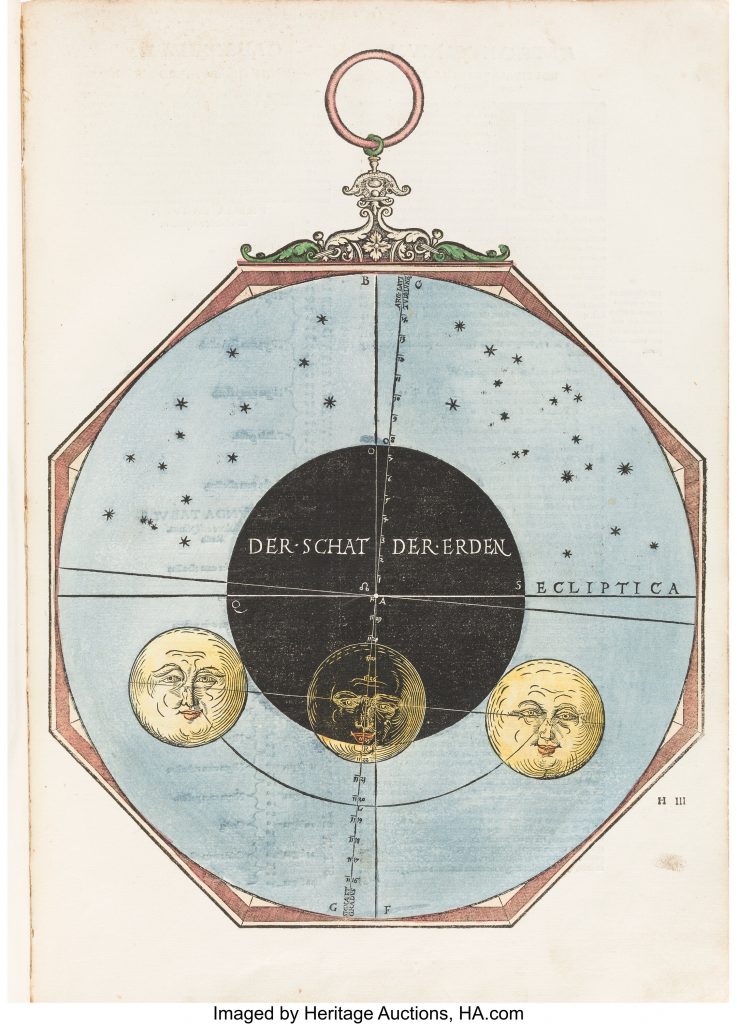
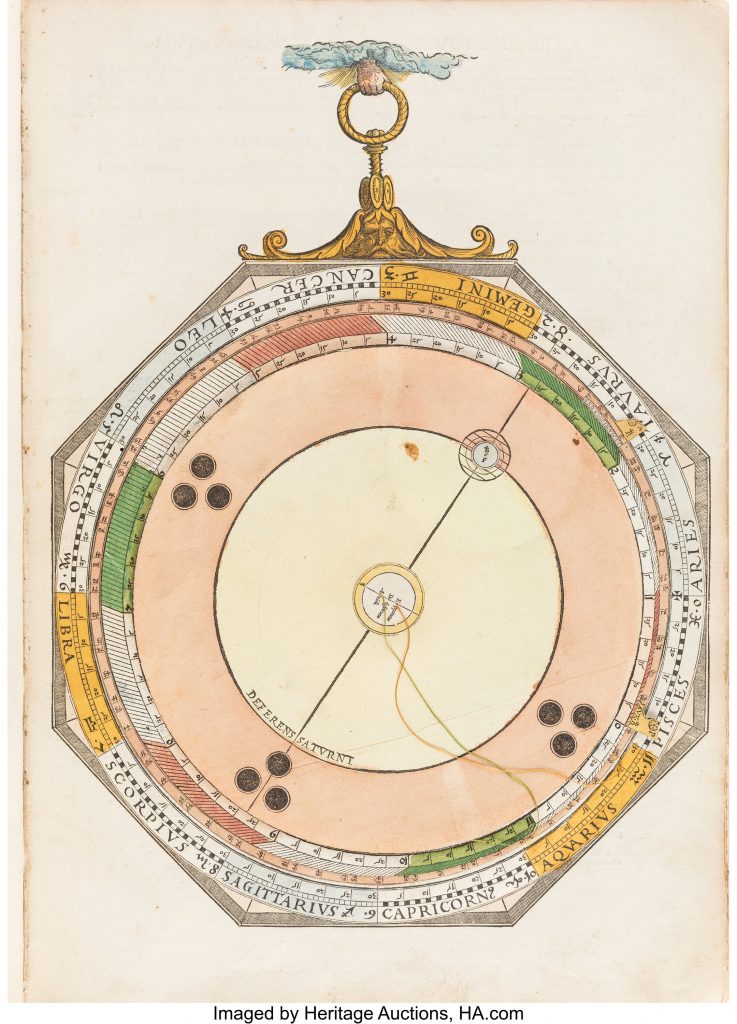
Apianus (1495-1552) “was a pioneer in astronomical and geographical instrumentation, and one of the most successful popularizers of these subjects during the sixteenth century. He studied mathematics and astronomy at Leipzig and Vienna, and quickly established a reputation as an outstanding mathematician… [His] first major work, Cosmographia seu descriptio totius orbis (1524), was based on Ptolemy. Starting with the distinction between cosmography, geography, and chorography, and using an ingenious and simple diagram, the book defines terrestrial grids; describes the use of maps and simple surveying; defines weather and climate; and provides thumbnail sketches of the continents. In its later form, as modified by Gemma Frisius, the Cosmographia was one of the most popular texts of the time and was translated into all major European languages” (D.S.B.).
“In my examination of these books, it became obvious that all of them were colored in Apian’s printing shop, and not by the buyers themselves (as was often the case for sixteenth-century books). In fact, the sheets were colored before (!) they were cut, as is revealed by the reverse of a volvelle in some copies: Apparently an error was made in coloring, and the paper was recycled and printed on the other side. The color patterns are not identical from one copy to another but the huge [ sic] are all from the same palette. A handful of deluxe copies, printed on specially watermarked, heavier paper, have more elaborate coloring, especially including the beautiful large initials that open each chapter. These deluxe copies include wonderful gold stars on a dark blue background for the movable planisphere on f. B3. A few copies on ordinary paper also have the elaborate coloring of the initials and planisphere. Only a single uncolored copy exists, in the Staatsbibliothek in Munich, apparently a set of proof pages that has been bound” (Gingerich 1995, p. 114).
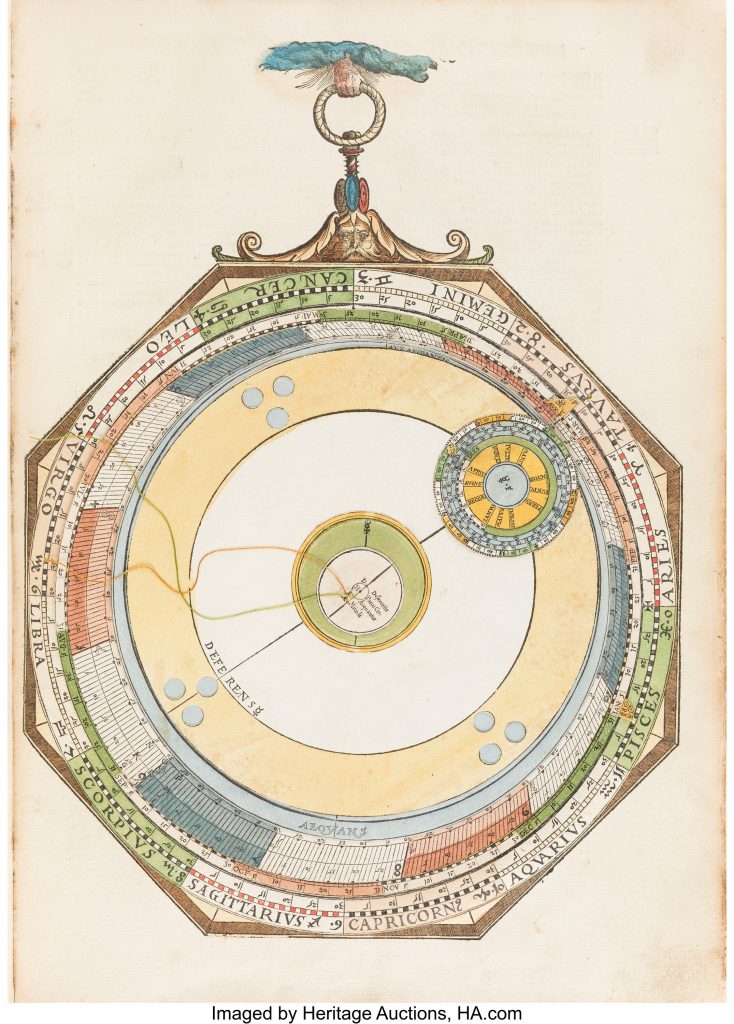
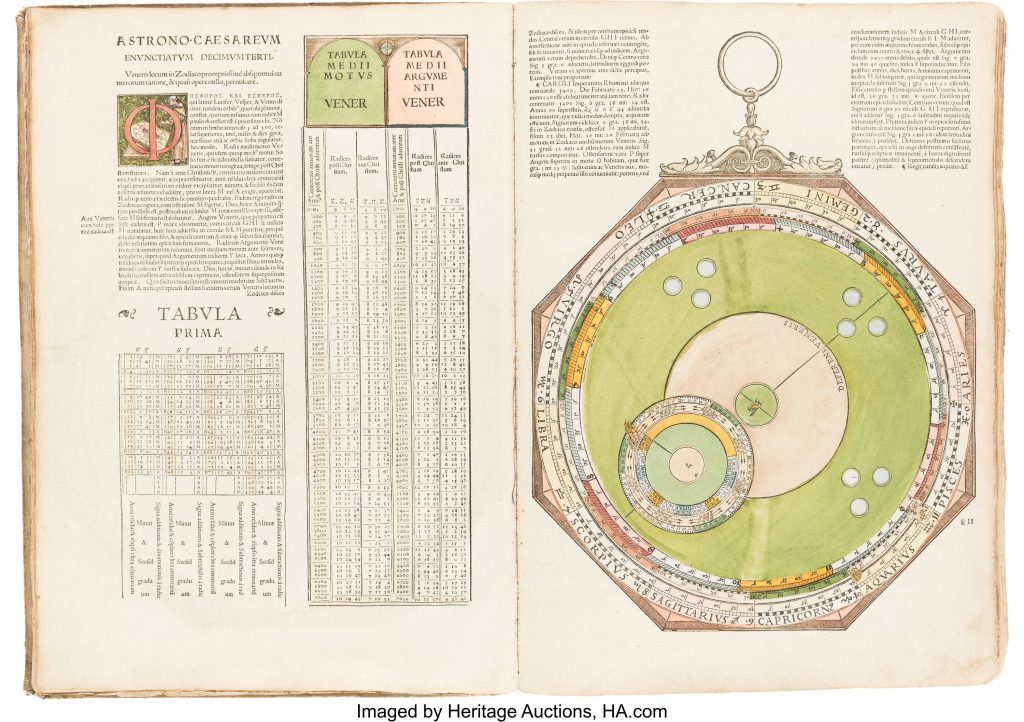
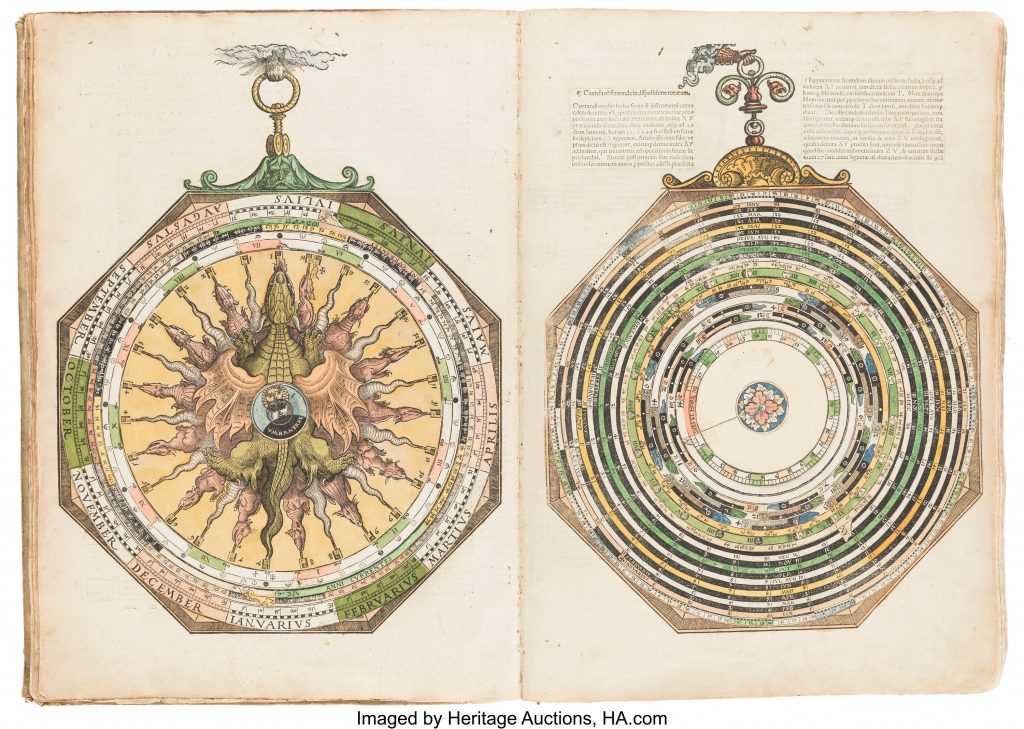
Wel erg specifieke informatie over het boek voor échte gespecialiseerde boekenfreaks: Signatures: A-F4 G4+1 H-N4 O6. In this copy, G1 and G5 appear to be conjugate, G2 and G3, and G4 is conjugate with the stub between G1 and G2. Colophon on O5 verso, printed in mirror type (as is an inscription on D3 verso). Text in double columns. Side notes. With the two letterpress slips pasted on the recto of G4 on either side of the woodcut, and with the small letterpress slip pasted over two lines on the recto of K1, correcting the text (darkened on the page somewhat from the glue). Title in black letter within an elaborate woodcut border with a large astronomical woodcut of the “Umbra Terra” beneath; woodcut arms of the joint dedicatees, Emperor Charles V and his brother Ferdinand of Spain, on the title-page verso. Thirty-six full-page plates of woodcut astronomical figures (the figure on G3 verso is also used on the title-page), within frames in the shape of astrolabes, with six different patterns of handles, of which twenty-one have a total of sixty-one volvelles. There appear to be twenty-nine original silk threads, but the seed pearls, which were used as sliding indicators, have all been lost. Two woodcut architectural head-pieces (on B1 recto and M4 verso); small circular head of Christ in the outer margin of leaf B1 recto, with two lines of text hand-colored as well, and woodcut depicting the four corners of the globe on F3 verso, with figures of a priest, a cosmographer, a poet, and an astronomer. The woodcuts are after Michael Ostendorfer, and all woodcuts and three large initials are colored by a contemporary hand. Fifty-three eleven- or twelve-line historiated woodcut initials containing astronomers, geometricians; thirty-nine six- or seven-line historiated woodcut initials, the initials by Hans Brosamer. Full-page woodcut of a torquetum on O4 verso. Numerous diagrams, some hand-colored, throughout the text. Final leaf (O6 recto) with small woodcut arms of the author, with caption above it: “Insignia / Petri Apiani, Mathemat. Ingolstadieñ.” Contemporary German blindstamped pigskin over pasteboard. Spine with five double raised bands. The binding is quite worn, with the pasteboard exposed in places, and considerable soiling and dampstaining, especially to the rear cover; damage to the lower portion of the spine. Title soiled and darkened, especially the corners, with dampstaining in the lower gutter and along the outer edge; occasional foxing and soiling and staining to the text, with heavy dampstaining at the end. Several leaves with color bleedthrough or offsetting from the plates. A small slip of paper affixed to G3 recto (paper repair), with a portion of nine lines of text supplied in ink by hand; small paper repair to G5 verso, affecting six lines of text, with loss of eight words. Short tear (1.5 inches) to lower margin of C2; occasional very minor worming; a few additional minor chips or tears to the edges. A very good copy overall, apparently well-used.
Adams A1277; Campbell Dodgson, Early German and Flemish Woodcuts, II, p. 242; Gingerich, “Apianus’s Astronomicum Caesareum,” in Journal for the History of Astronomy, 2 (1971), pp. 168-177; Gingerich, Rara Astronomica, 14; Owen Gingerich, “A Survey of Apian’s Astronomicum Caesareum,” in Karl Röttel, editor, Peter Apian: Astronomie, Kosmographie und Mathematik am Beginn der Neuzeit (Buxheim Eichstätt: Polygon-Verlag, 1995), pp. 113-122; Stillwell, The Awakening Interest in Science during the First Century of Printing, 19; Van Ortroy 112; Zinner 1734.
The mirror-printed colophon on O5 verso reads: “Factum et actum Ingolstadii in Aedi- / bus nostris. [type ornament] Anno a Christo / Nato [type ornament] Sesquimillesimo qua / dragesimo [type ornament] Mense / Maio / [type ornament].” The inscription facing the latitude of Mars on D3 verso printed in mirror type reads: “Praememoratam / Martis Latitudinem / Praesens Schema / Representat / [type ornaments].”
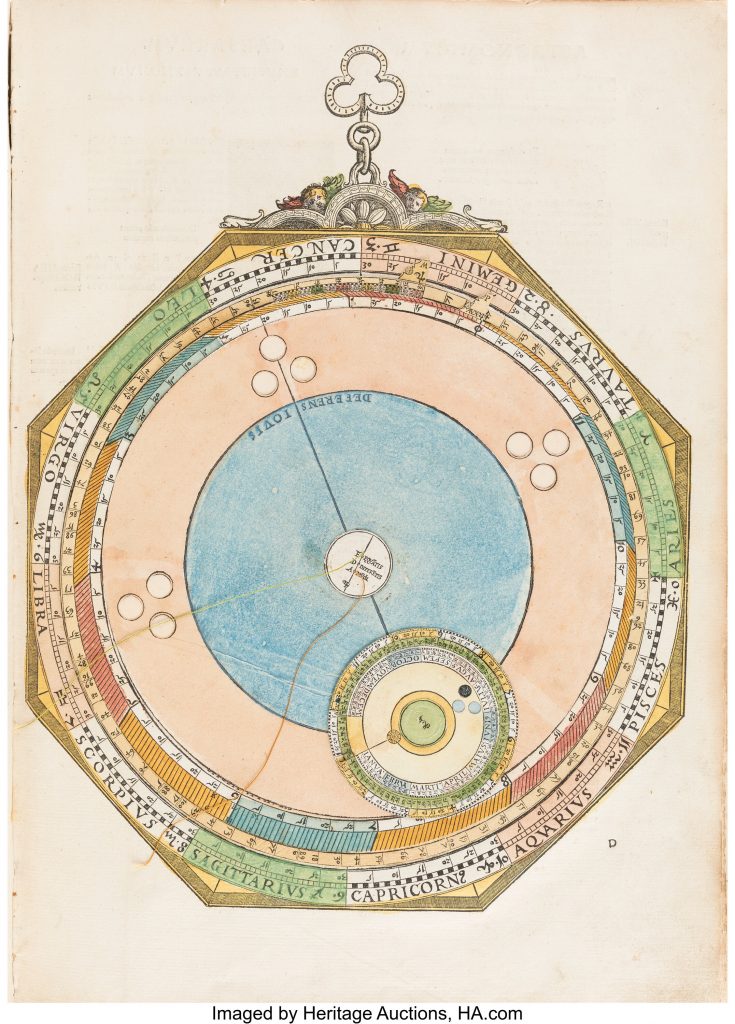
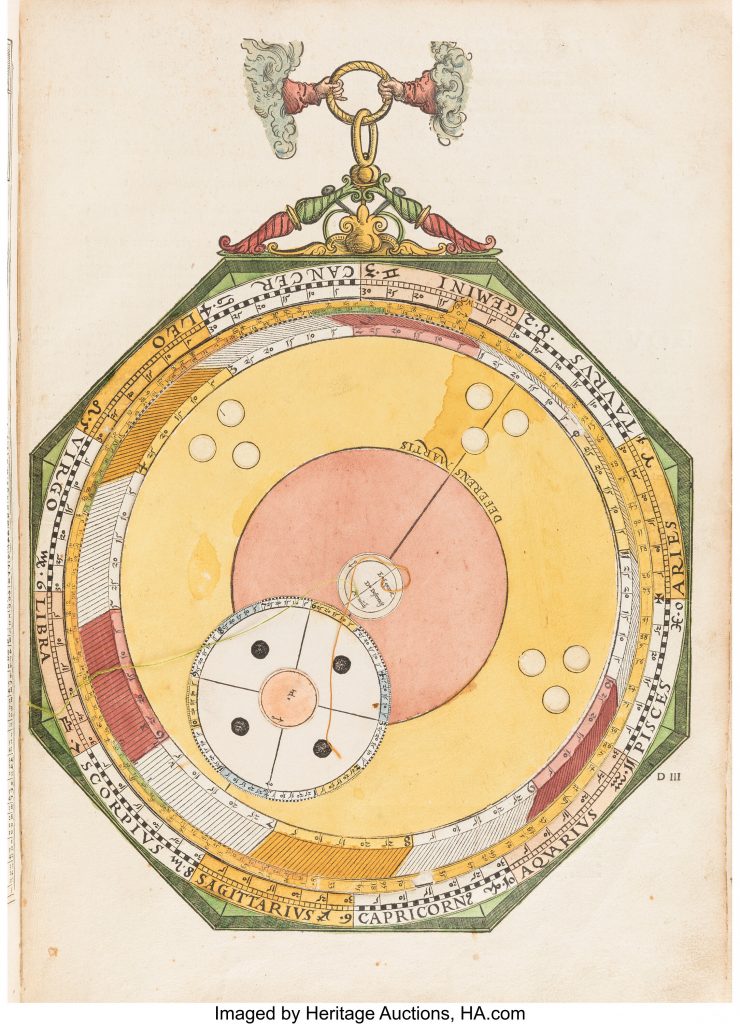
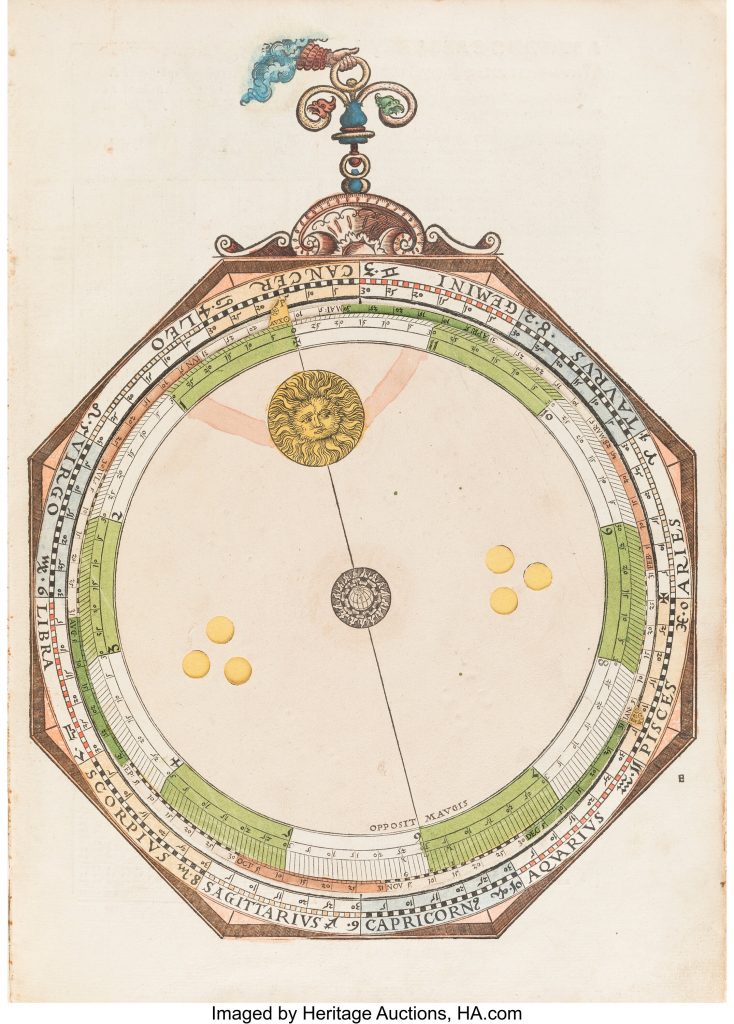
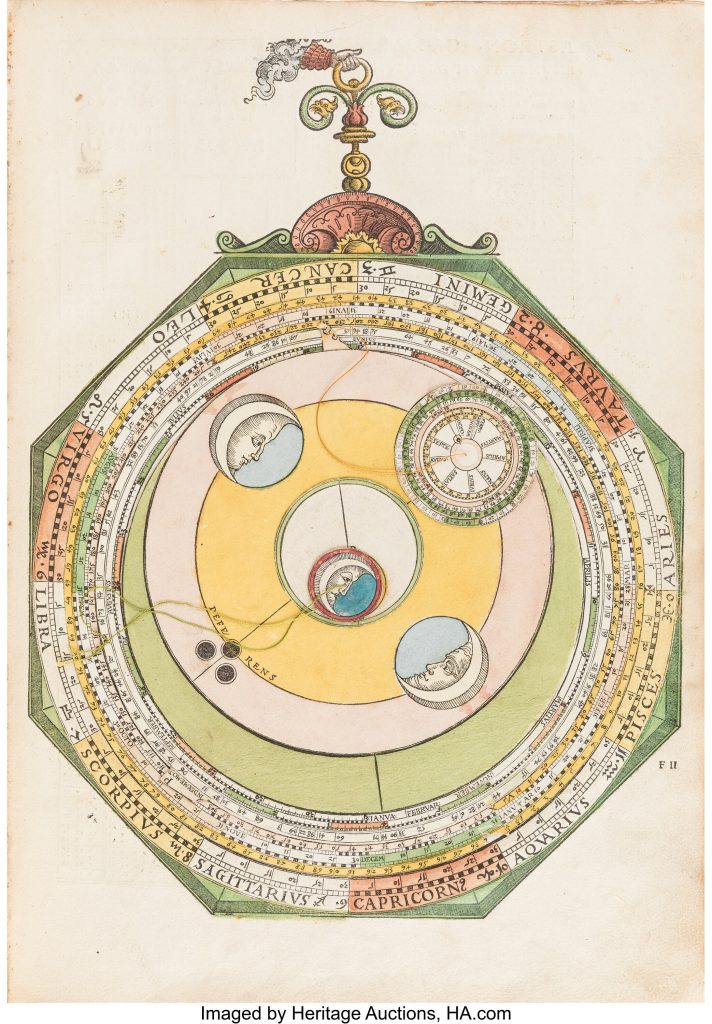
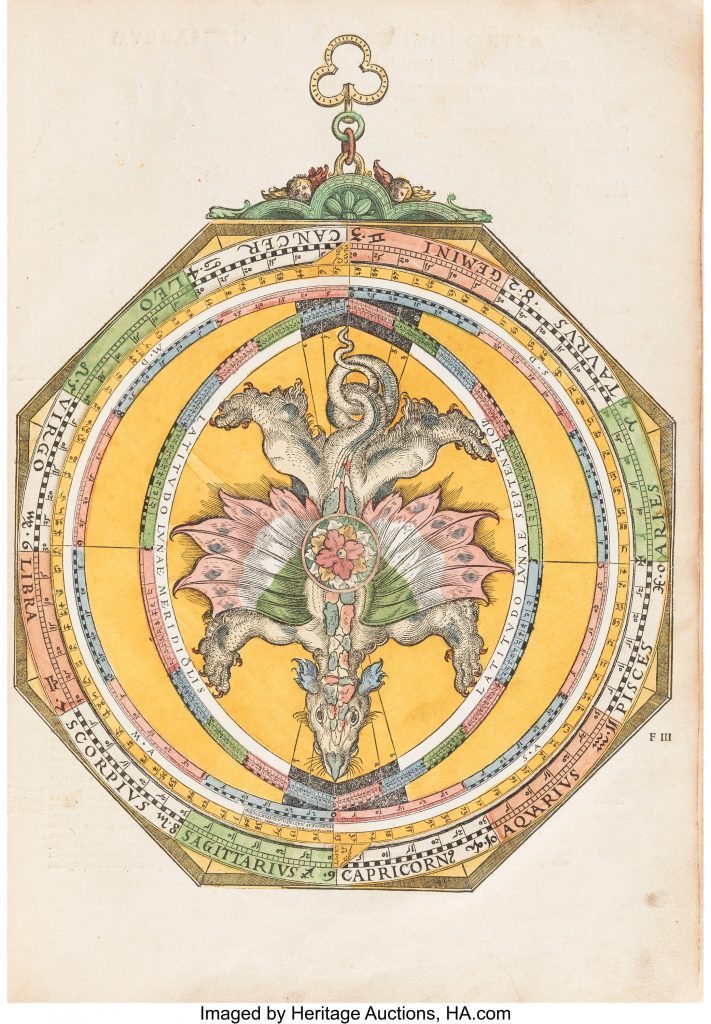
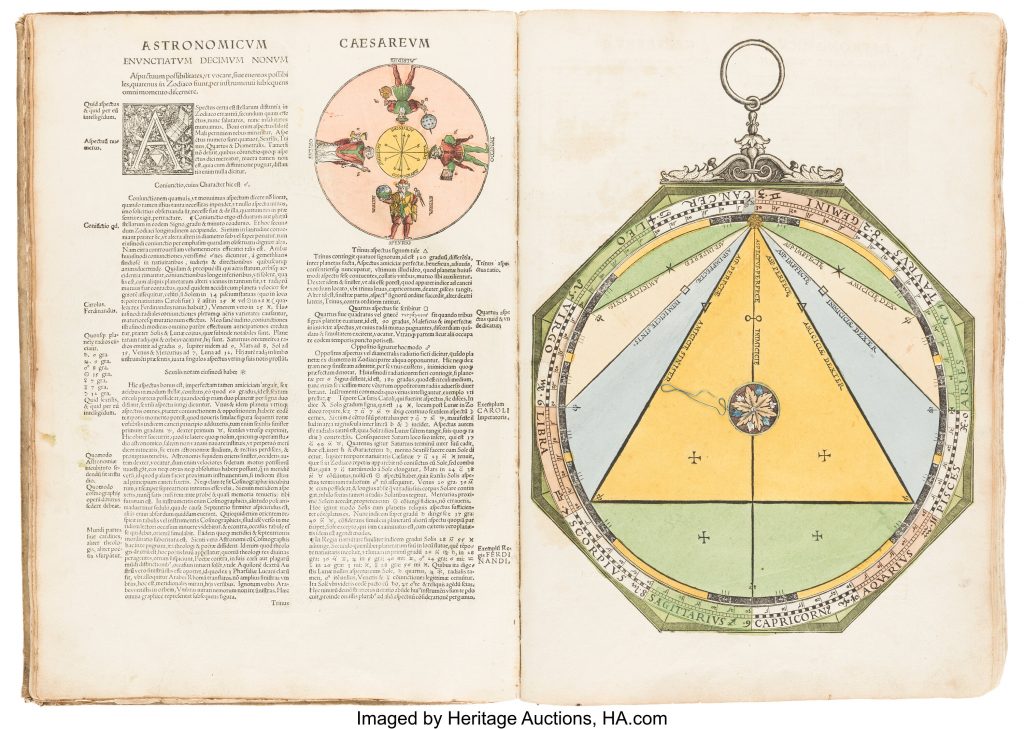
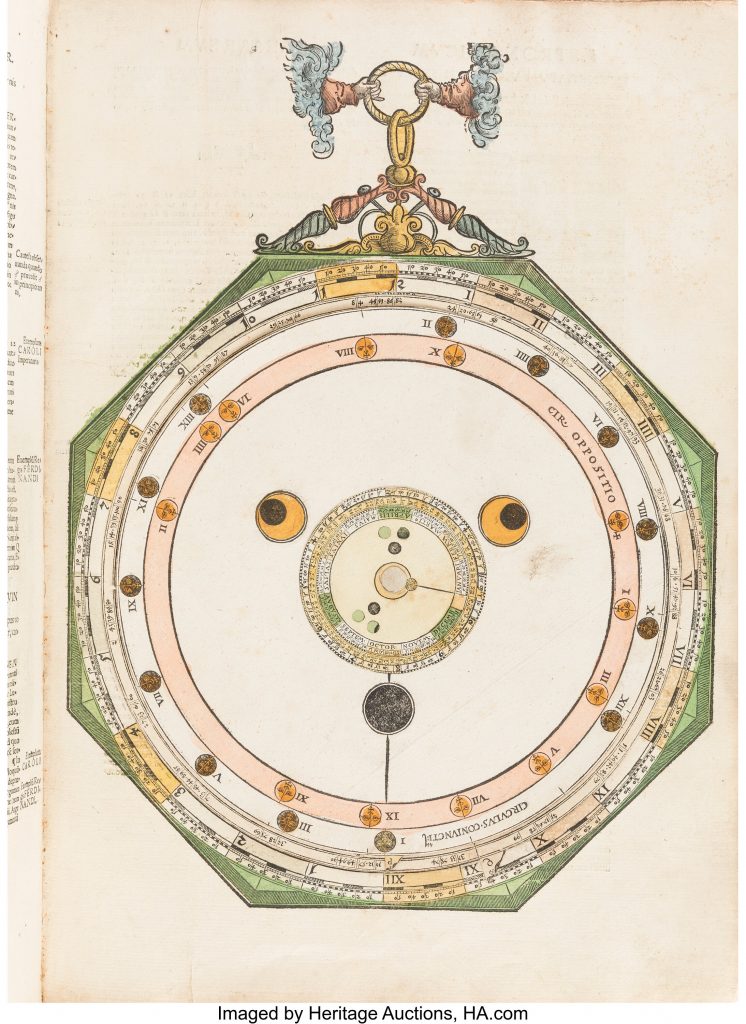
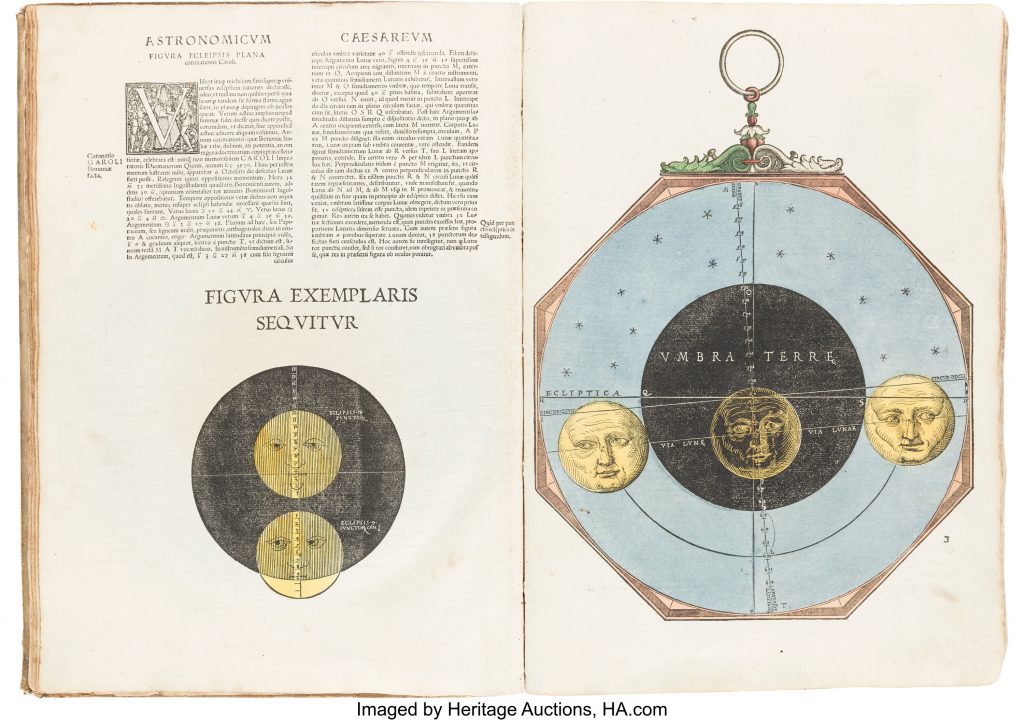
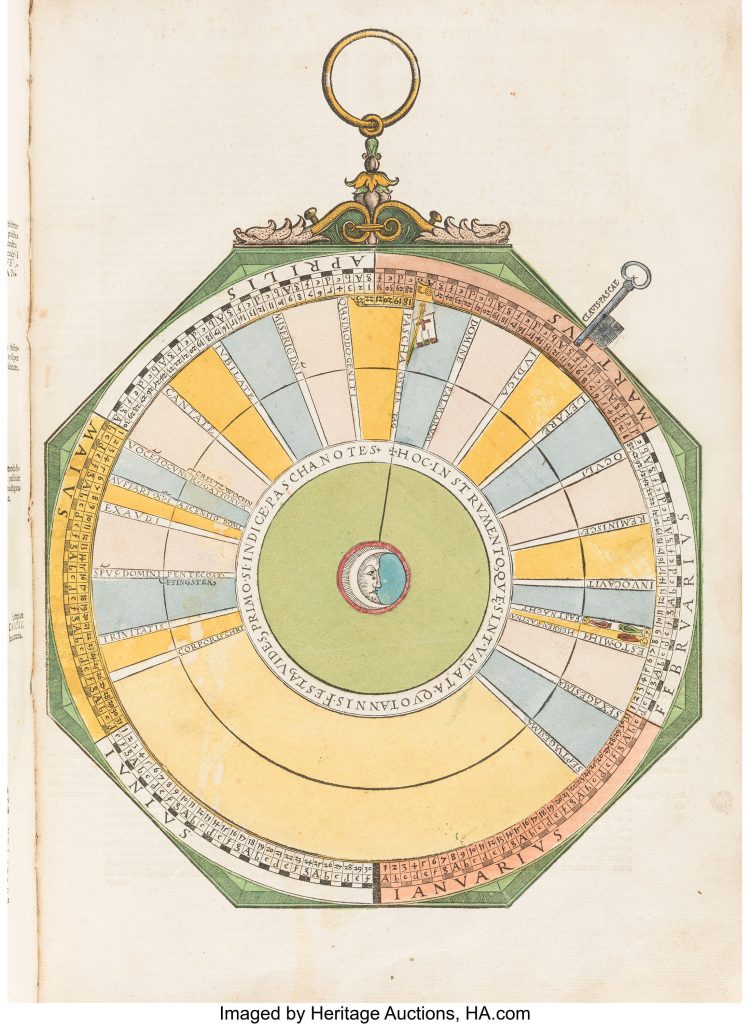
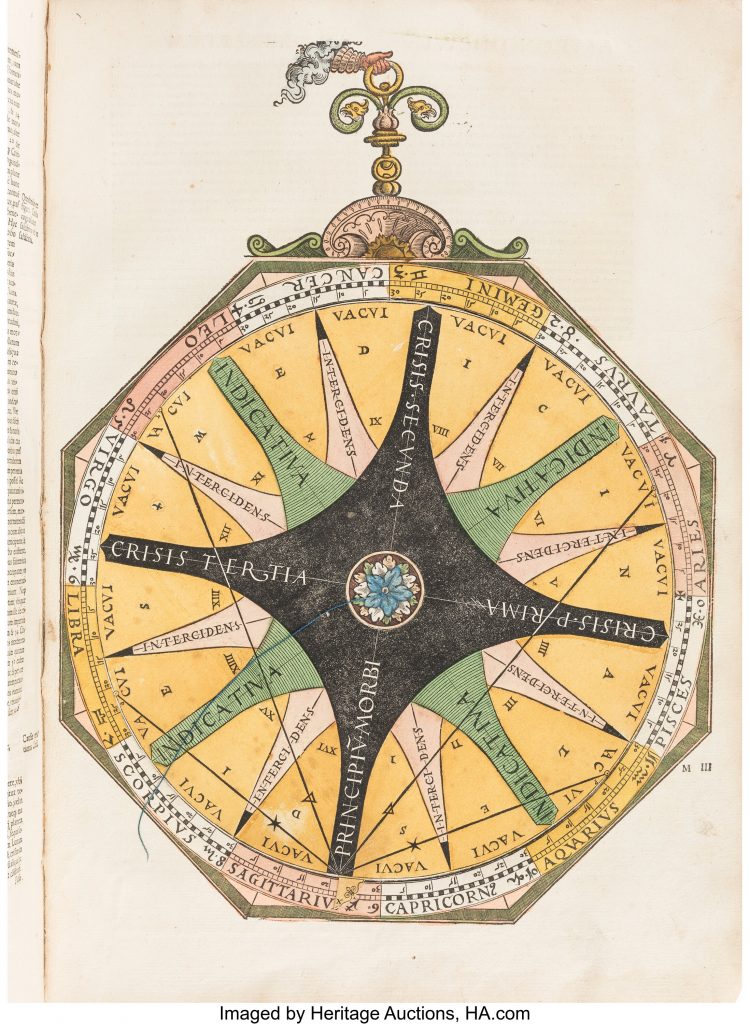
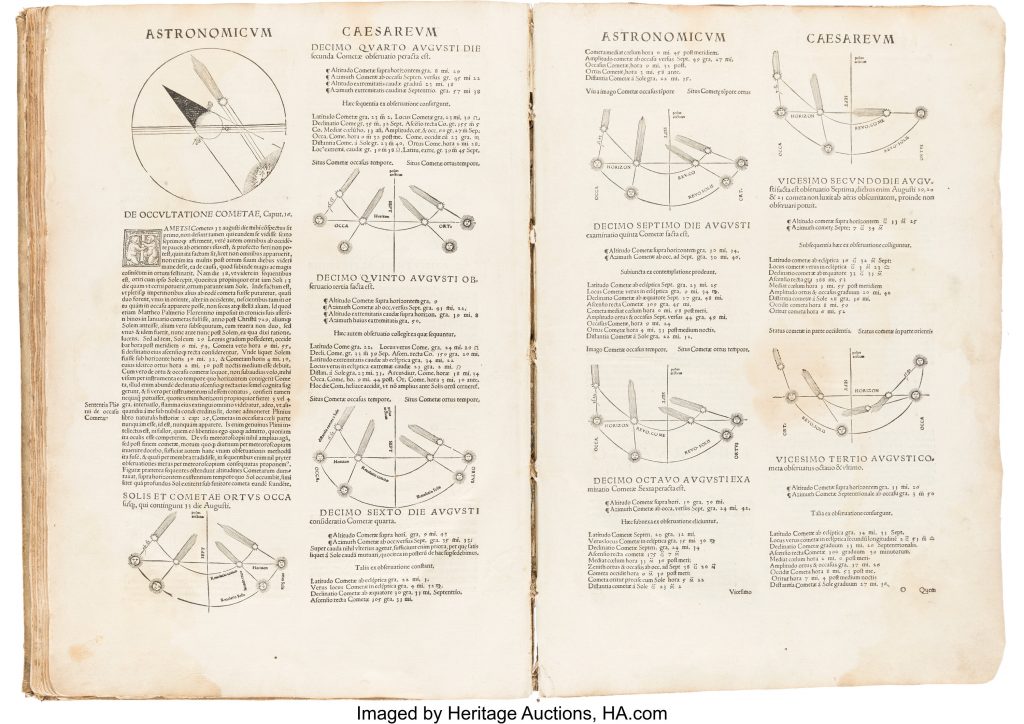
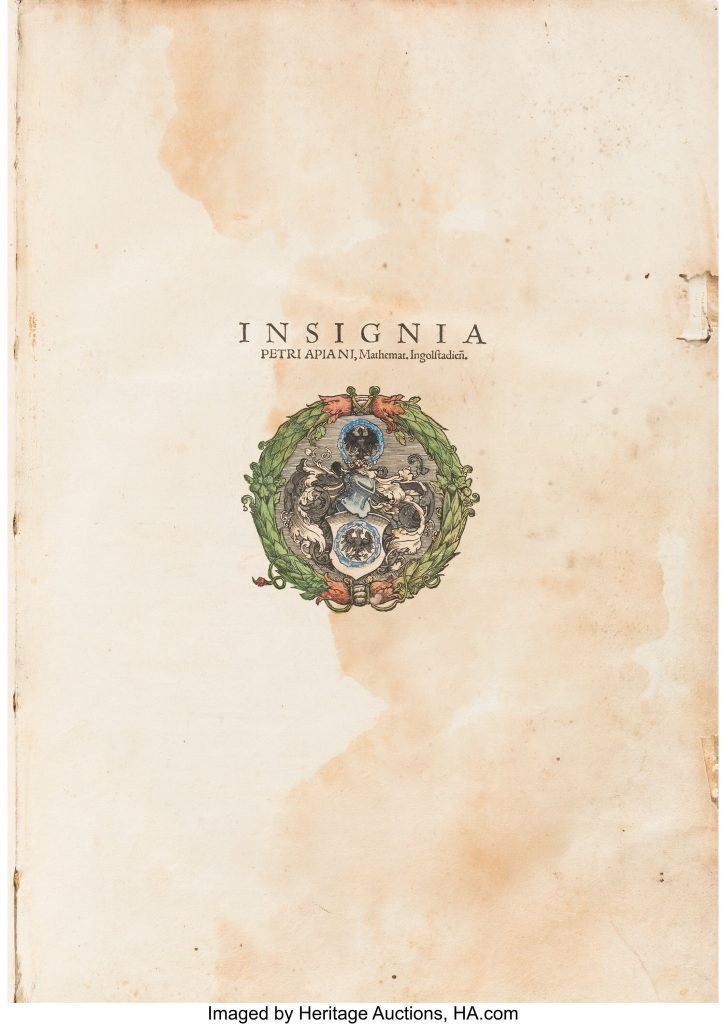
Weer een te koop, voor 850.000 euro
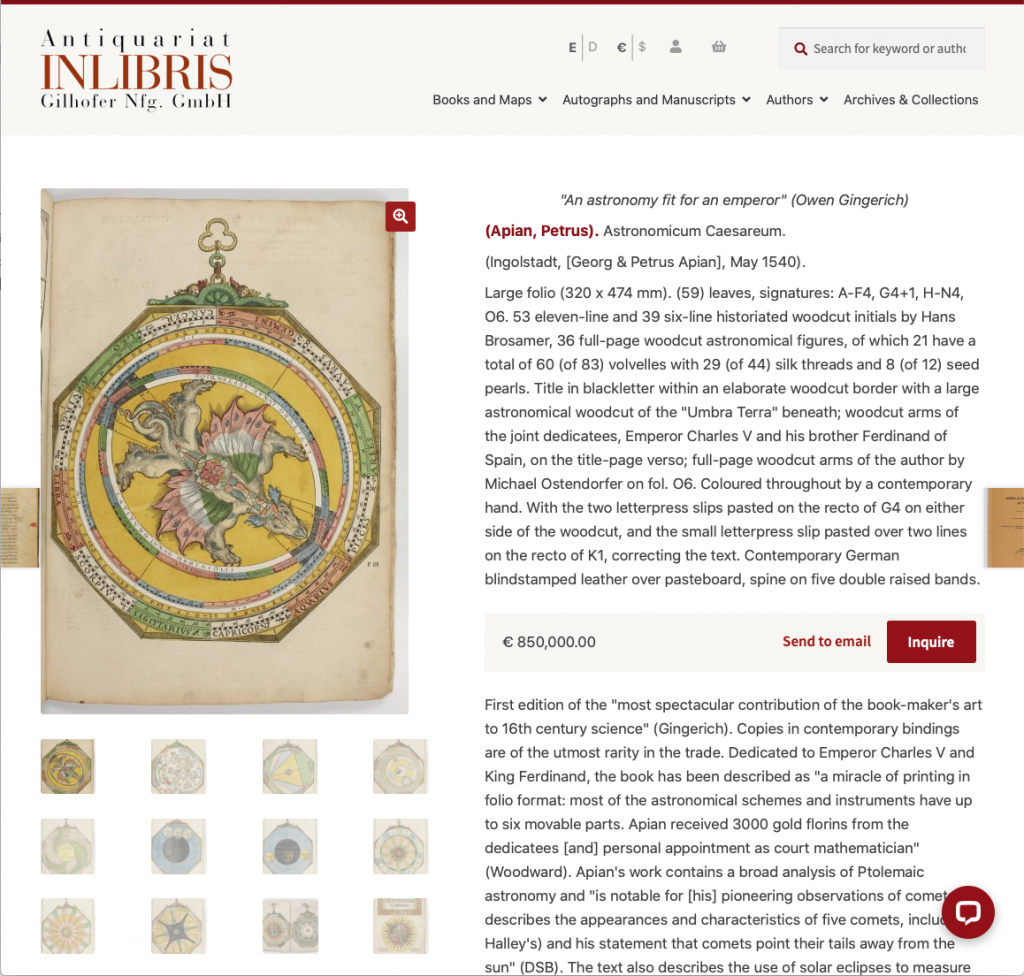
Mijn astronomie vriend Peter uit Wassenaar stuurde me een mooi mailtje: er is weer een Apianus te koop: vraagprijs 850.000 euro. Da’s een flink bedrag (Die hierboven begon op 150.000 euro). Bekijk de site hier. Het mooiste boek dat ik ooit in mocht zien, en toen nog zelf vast mocht houden… Ik was de laatste. Vanaf nu alleen te tonen door de curators…
(Ingolstadt, [Georg & Petrus Apian], May 1540).
Large folio (320 x 474 mm). (59) leaves, signatures: A-F4, G4+1, H-N4, O6. 53 eleven-line and 39 six-line historiated woodcut initials by Hans Brosamer, 36 full-page woodcut astronomical figures, of which 21 have a total of 60 (of 83) volvelles with 29 (of 44) silk threads and 8 (of 12) seed pearls. Title in blackletter within an elaborate woodcut border with a large astronomical woodcut of the “Umbra Terra” beneath; woodcut arms of the joint dedicatees, Emperor Charles V and his brother Ferdinand of Spain, on the title-page verso; full-page woodcut arms of the author by Michael Ostendorfer on fol. O6. Coloured throughout by a contemporary hand. With the two letterpress slips pasted on the recto of G4 on either side of the woodcut, and the small letterpress slip pasted over two lines on the recto of K1, correcting the text. Contemporary German blindstamped leather over pasteboard, spine on five double raised bands.
First edition of the “most spectacular contribution of the book-maker’s art to 16th century science” (Gingerich). Copies in contemporary bindings are of the utmost rarity in the trade. Dedicated to Emperor Charles V and King Ferdinand, the book has been described as “a miracle of printing in folio format: most of the astronomical schemes and instruments have up to six movable parts. Apian received 3000 gold florins from the dedicatees [and] personal appointment as court mathematician” (Woodward). Apian’s work contains a broad analysis of Ptolemaic astronomy and “is notable for [his] pioneering observations of comets (he describes the appearances and characteristics of five comets, including Halley’s) and his statement that comets point their tails away from the sun” (DSB). The text also describes the use of solar eclipses to measure longitude, the author’s inventions of the meteorscope (for solving problems in spherical trigonometry) and the torquetum (a predecessor of the equatorial telescope), and a variety of astrological concerns. Most of Apian’s observations and theories are illustrated by his inclusion of intricate volvelles, which he believed to be of greater use in providing information on the position and movement of celestial bodies, rather than mathematical formulae.
Apian is also noted for introducing Arabic star names into his maps. In the present work he includes a revision of his 1536 star chart, with the addition of two more Arabic star names (“Angentenar” in Eridanus, and “Yed” in Ophiuchus), and two Latin star names which do not appear the 1536 edition. Apian knew the work of the Islamic astronomer Abu ‘l-Husain al-Sufi (AD 903-986). “Al-Sufi, in his Book on the constellations (written around AD 964), gave a detailed account of the 48 classical constellations (which the Arabs knew through translations of Greek astronomical works and through pictorial representations on globes from other sources), complemented by records of star names of indigenous Arabic origin which he took pains to identify astronomically with the respective Ptolemaic stars. It was from this section on the indigenous Arabic star names in al-Sufi’s book that Apian extracted a number of names and mentioned them in his own writings, most of them in the chapter in constellations in his Astronomicum Caesareum of 1540” (Kunitzsch).
The Astronomicum Caesareum is “scarcer than the first edition of Copernicus’s ‘De revolutionibus’, which was published only three years later, and it is considerably rarer than the much-sought 1687 ‘Principia’ of Newton” (Owen Gingerich). The collation of the work is understandably complex. In his 1995 survey Gingerich accounts for 111 copies and estimates that there are probably fewer than another 25 copies he did not personally examine (the present copy is among the latter). Of all copies inspected, Gingerich regarded perhaps fewer than 10% as complete or near-complete. While many of the known copies also lacked some of the 59 printed leaves, our copy is textually complete but wants some of the volvelles, threads, and seed pearls that Gingerich suggests would make up an ideal copy. Ours has the 36 full-page plates of woodcut astronomical figures within frames that resemble astrolabes, with six different patterns of handles, of which 21 have a total of 60 volvelles. There are 29 original silk threads and 8 tiny seed pearls (measuring a single millimetre), used as sliding indicators.
Provenance: from the library of a large fraternal organization in Texas (USA), donated by a member of that organization in the 1950s/1960s, in whose collection the book had rested for several decades.
Binding worn and stained with professional repairs. Title soiled and darkened; some dampstaining in the lower gutter and along the outer edge. Occasional foxing and staining to the text, with heavier dampstaining near the end. Several leaves show colour bleeding or offsetting from the plates. A small repair slip of paper affixed to G3r, with a portion of nine lines of text supplied in ink by hand; small paper repair to G5v, affecting six lines of text, with loss of eight words. Occasional very minor worming; a few minor chips or tears to the edges. A very good copy overall, apparently in extensive contemporary use.
Facsimile obv Leipzig versie uit 1967
In 1967 is er een facsimile gemaakt van de Leipzig versie, oplage van slechts 750 stuks. In principe geleverd met een Duitstalige handeling voor gebruik door de leken… En dat samen in een fraaie box. Er is er een te koop hier in Europa en hij is me aangeboden. Niet zo duur als het origineel dat in Wenen voor 850.000 euro te koop staat, maar het blijft toch veel geld. Toch is de kans groot dat het er een keer van gaat komen… De kwaliteit lijkt prima en zelfs de schijven en touwtjes zijn aangebracht. Dichterbij ga ik niet komen. Museum Boerhaave heeft er een in hun bibliotheek. Die wellicht even een keer gaan bekijken om het zekerder te weten 😉
Beschrijving van het boek dat ik kan kopen; beschrijving lijkt de levering van de complete set te omvatten, zoals op de foto hieronder. > “Facsimile edition (Leipzig 1967) which comes along with a commentary, it is the limited edition (750 numbered copies) of the copy of the Bayerische Staatsbibliothek. Commentary is by Diedrich Wattenberg. Housed in the original publishers fitted slipcase.”
Andere beschrijving: APIANUS, PETRUS. Astronomicum Caesareum. Complete color facsimile with accompanying volume of explanatory text in German and English. Together, 2 volumes. Folio, 447×305 mm, original gilt-lettered pigskin, and 4to, 296×210 mm, original cloth-backed boards; contents clean, volvelles loose on K3r in facsimile; publisher’s board folding case, slightly worn along edges. Leipzig, 1967 / Number xxx of 200 colored copies, from an edition of 750. superb facsimile of the 1540 original edition of Apianus’s most famous work, an elaborate treatise on Ptolemaic astronomy, complete with 20 working volvelles. “A spectacular achievement of Renaissance printing, this volume allowed its user to reproduce the motions of all the heavenly bodies through combinations of elaborately decorated rotating paper disks up to six layers deep and arranged on nonconcentric axes”
LET OP: Ik heb zo’n facsimile versie (nummer 332 van 750 inmiddels ook in handen gehad. Dat komt omdat ik er een kan kopen. Zoals altijd twijfel ik, want het is veel geld: zeker voor een boek in de kast… Maar de kwaliteit ken ik nu en die was heel netjes. Bekijk het verslag!
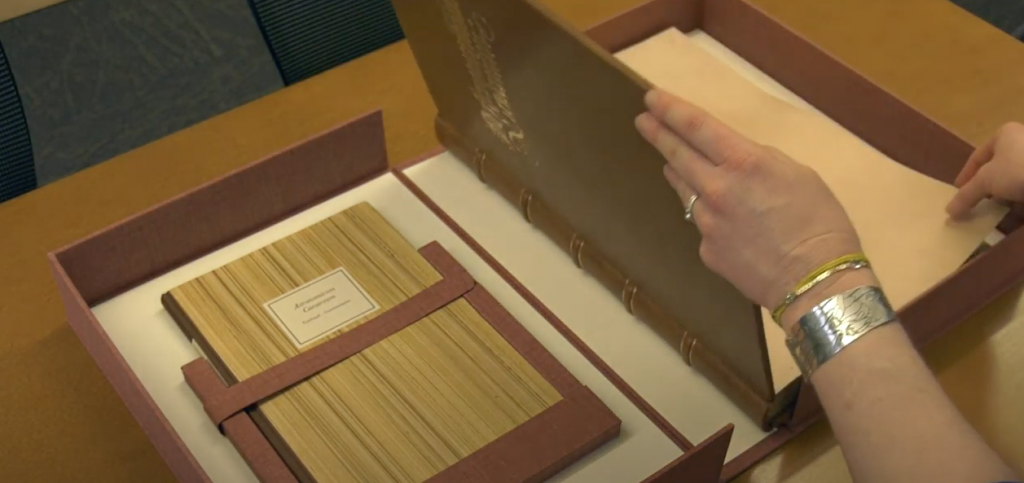
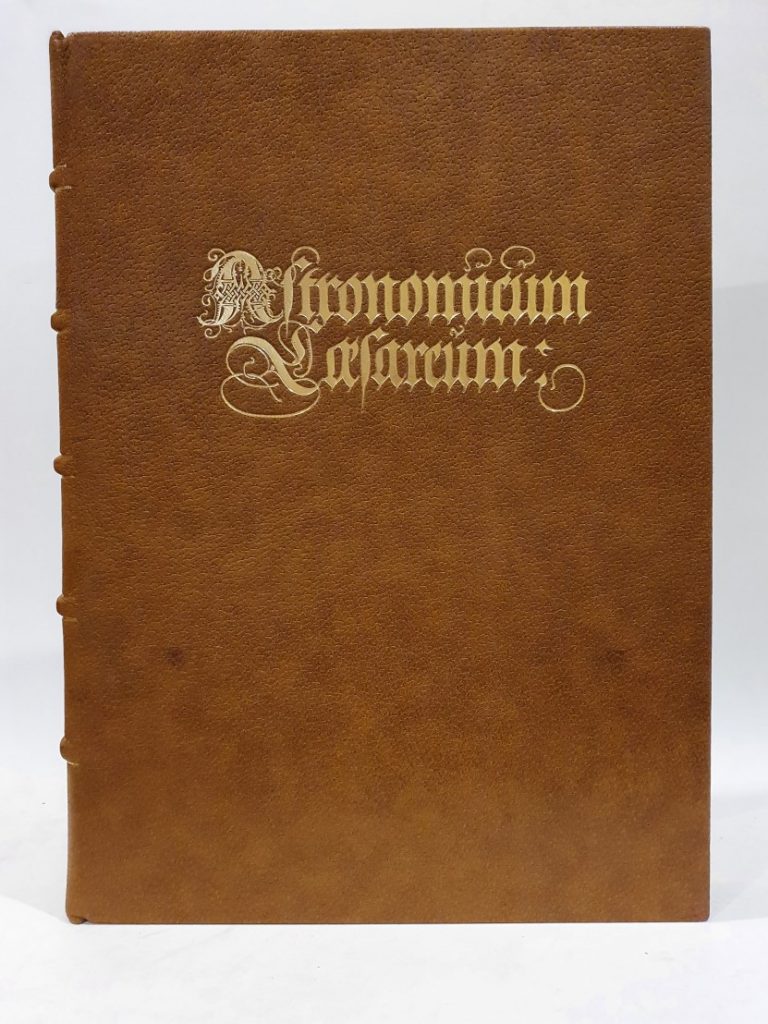
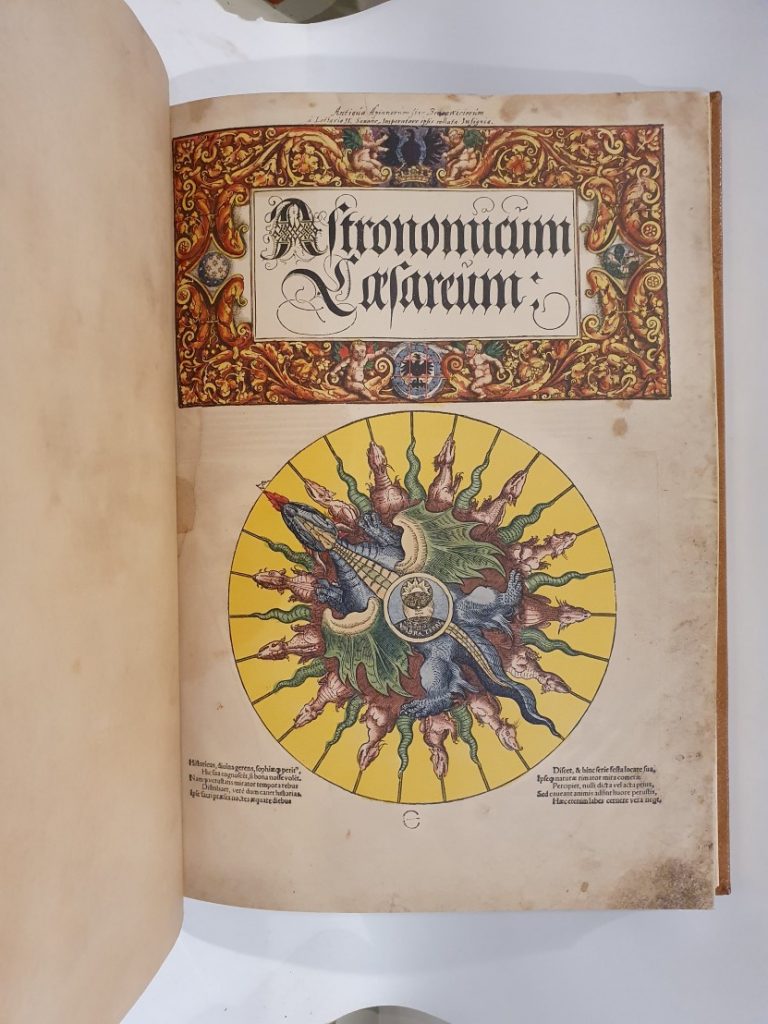
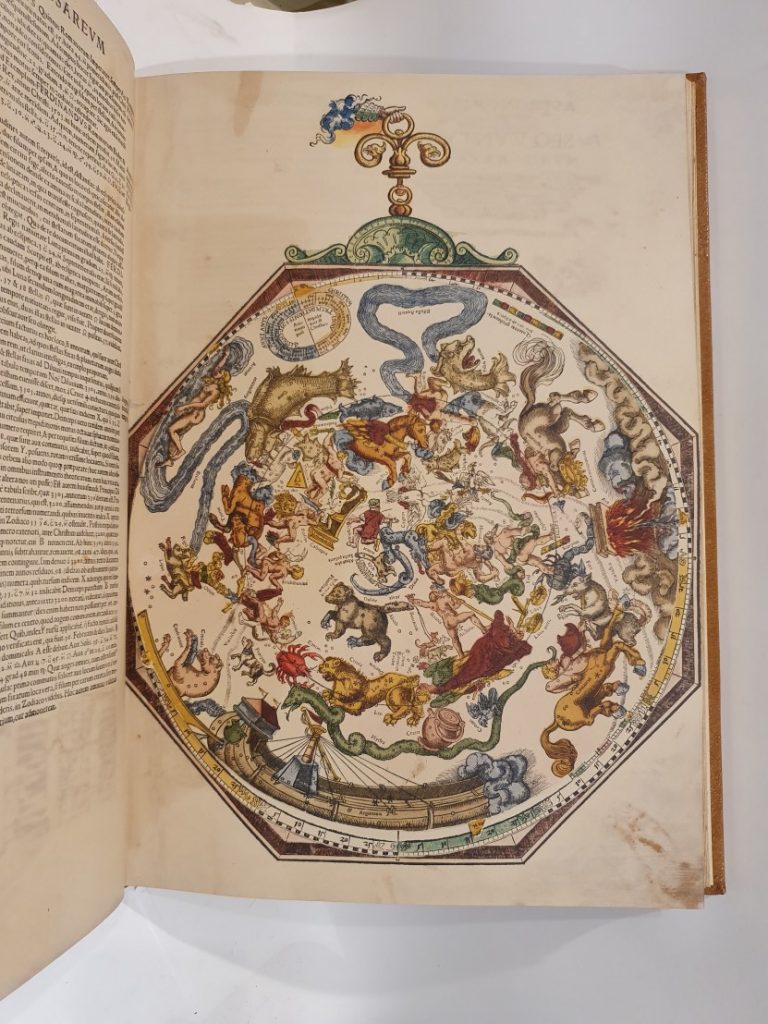
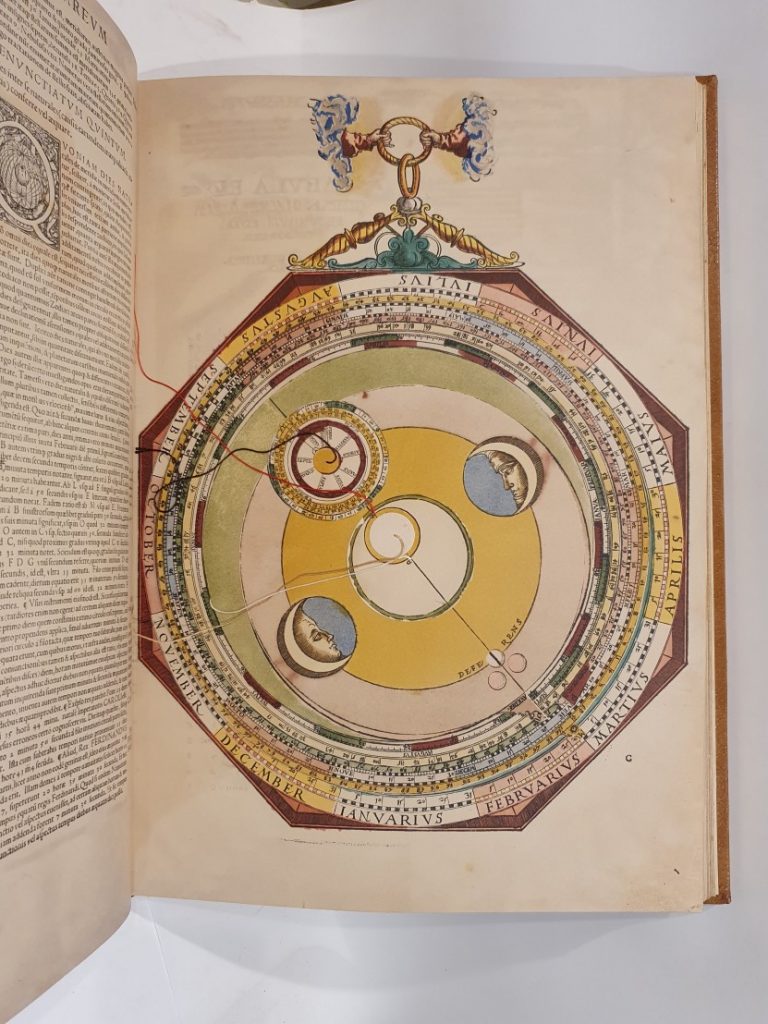
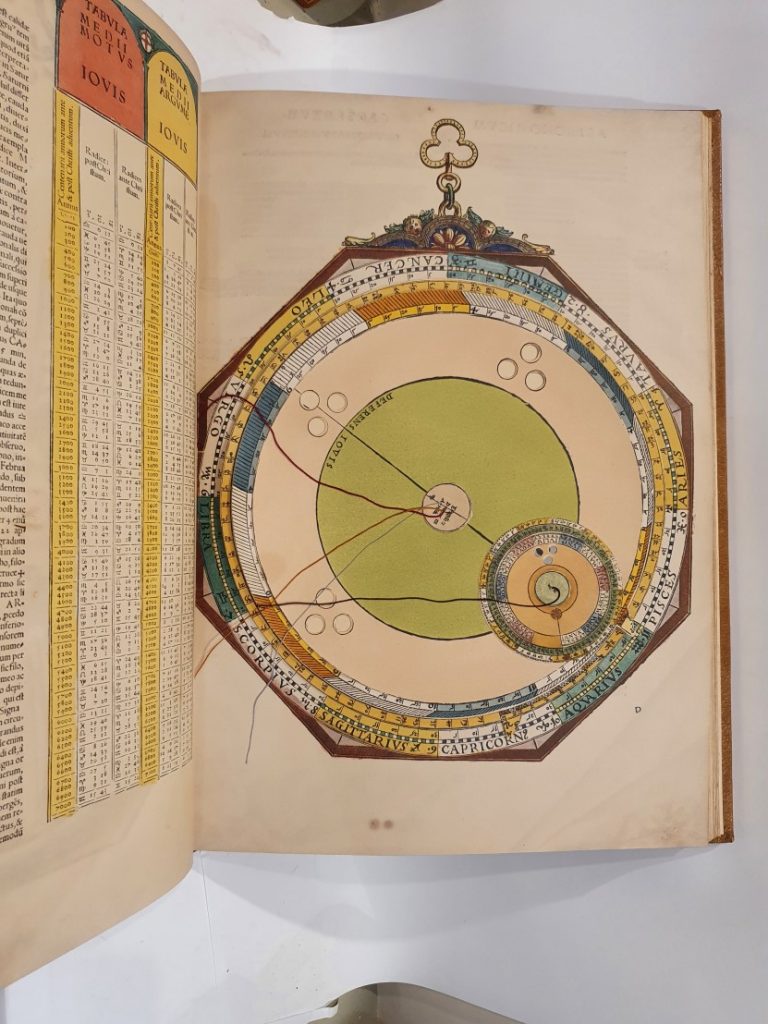
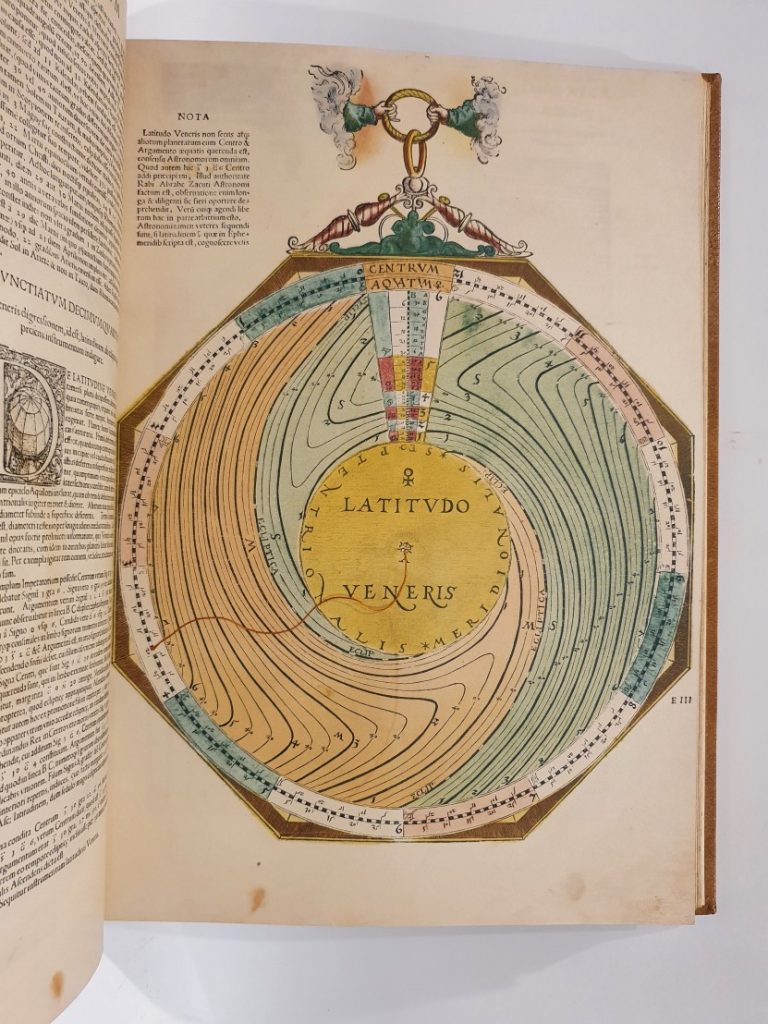
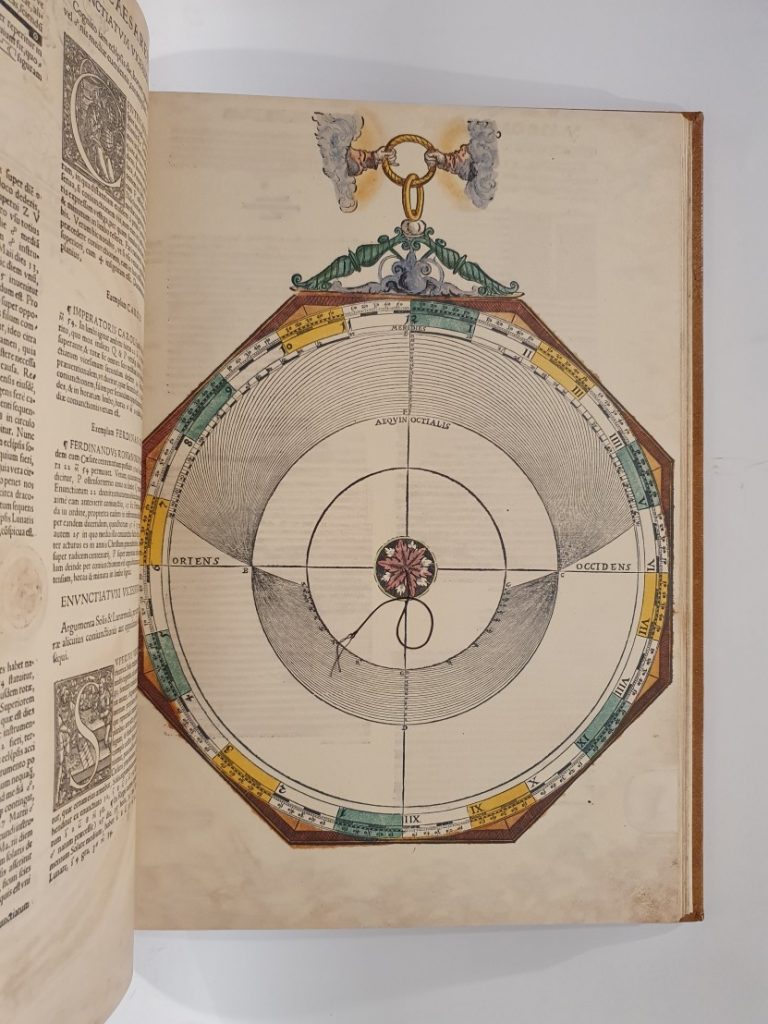
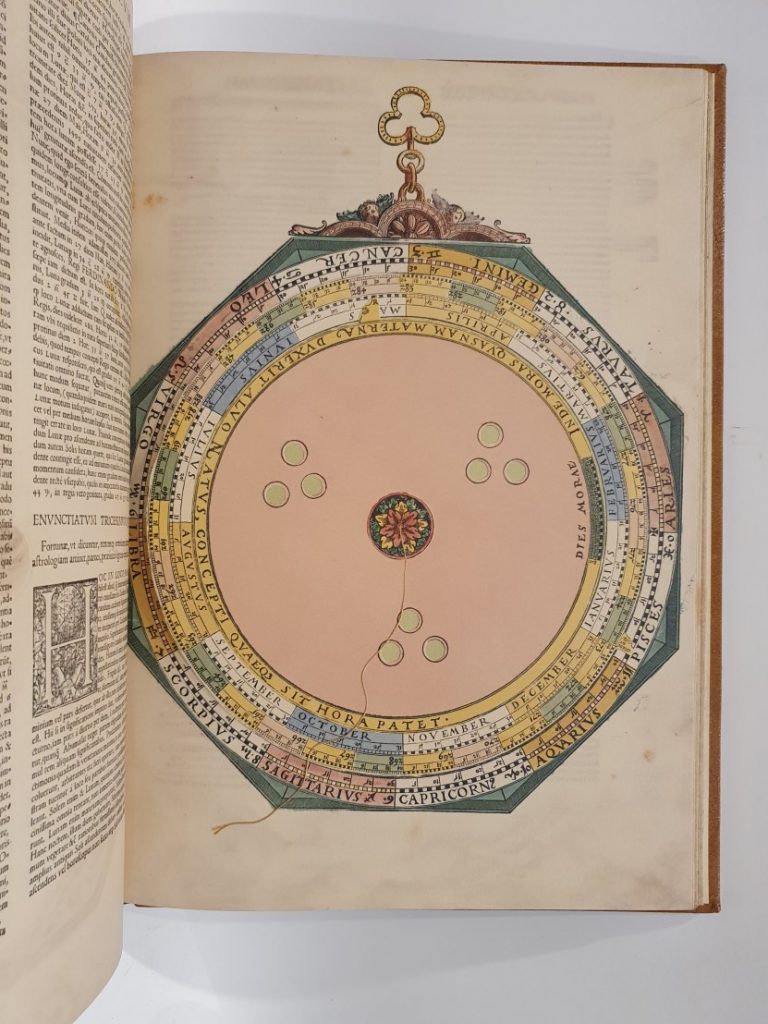
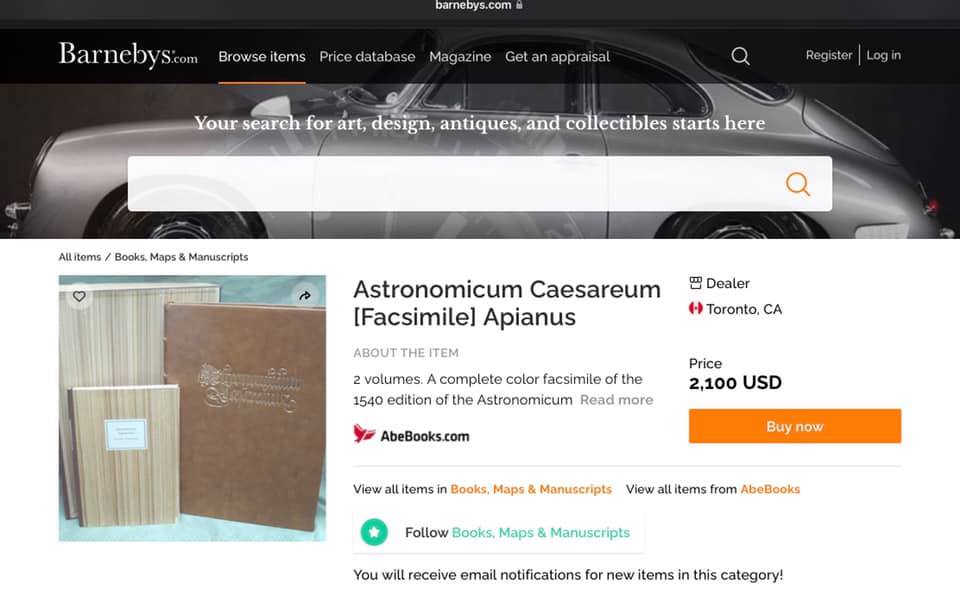
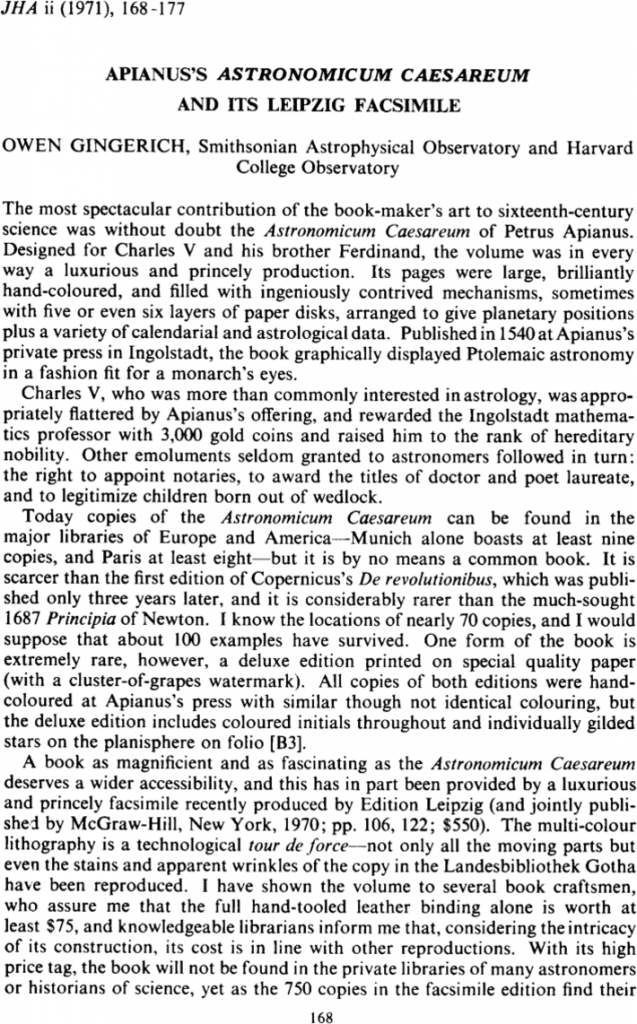
Links
Video van dit boek: https://youtu.be/mE0FS9EcJoo
Uitleg bij / commentaar op het boek door Lars Gislèn van de Universiteit van Lund
Universiteits Bibliotheek Leiden heeft ook een exemplaar van deze eerste editie. Het rotweer is in aantocht, binnenkort maar weer eens die kant op. (verslag van 9-10-’20 hier bovenaan toegevoegd)
Bekijk het volledige boek in Google Books. En bij RareBookRoom.
Over Petrus Apianus op Wikipedia. Altijd veel meer info op de Engelse versie.
Een mooi blog, waarin ze stellen dat er wellicht 111 van het totaal van slechts 130 boeken over zijn. En nog een. En nog een andere. OK, en deze dan.
Commentaar / Review van het boek
Bekijk de andere boeken die ik in mocht zien bij de Universiteits Bibliotheek Leiden. Ze hebben een prachtige collectie die je als lid mag inzien op de afdeling Special Collections.
Ik heb de afbeeldingen willen bewaren om hier te kunnen delen: ‘geleend’ van de veilingsite.


